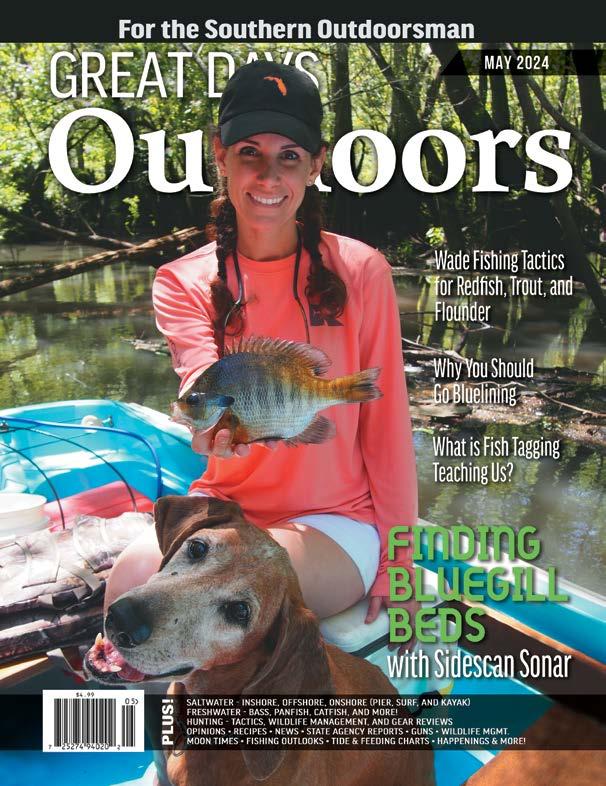





5 YEAR LIMITED WARRANTY applies to qualifying purchases of Suzuki outboard motors sold and delivered to the retail purchaser, for pleasure (non-commercial) use only, from April 1, 2021 through March 31, 2022. See Suzuki Limited Warranty for additional details. Suzuki, the “S” logo, and Suzuki model and product names are Suzuki Trademarks or ®. Don’t drink and drive. Always wear a USCG-approved life jacket and read your owner’s manual. © 2021 Suzuki Marine USA, LLC. All rights reserved. A BIGGER COOLER YOU’RE GONNA NEED HOOKED ON™ SUZUKI TECHNOLOGY SZ Q4 CSTL FSHNG W BOX 1 PG 9-13-21.indd 1 9/13/2021 2:46:43 PM 251.968.2628 6940A HIGHWAY 59 | GULF SHORES, AL 36542 HWY 59 @ COASTAL GATEWAY BLVD. 2 May 2024 // GreatDaysOutdoors.com // 877.314.1237




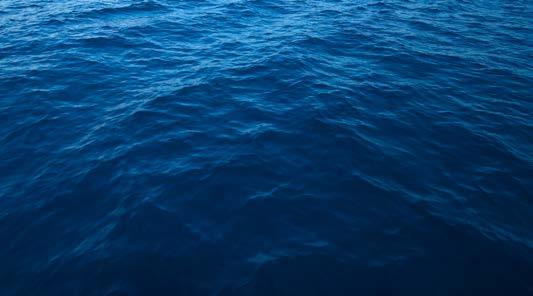

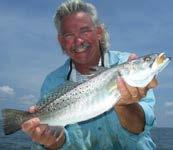






INSHORE GUIDE SERVICE Mobile Bay + Mobile Delta + Dauphin Island 3 TIME ALABAMA INSHORE TRAIL CHAMPION MULTIPLE REDFISH TOUR WINS USCG LICENSED 35 YEARS EXPERIENCE Capt. Bobby Abruscato (251) 661-7696 www.ateamfishing.com A-Team Fishing Adventures 7 LOCATIONS TO SERVE YOU DIXIESUPPLY.COM Eight Mile, AL • Theodore, AL Summerdale, AL BAKERMETALWORKS.COM Troy, AL • Baker, FL Fountain, FL • Cantonment, FL METAL ROOFING & SIDING | 20 COLORS | 29 & 26 GAUGE | 5 PROFILES YOUR METAL ROOFING HEADQUARTERS 877.314.1237 // GreatDaysOutdoors.com // May 2024 3


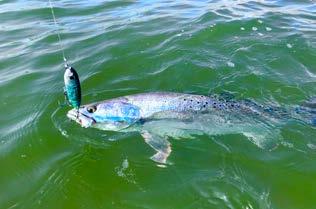
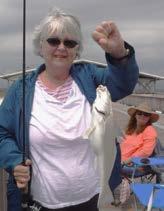


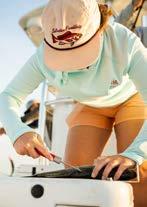
THE
CONTENTS Best Bets . . . . . . . . . . . . . . . . . . . . . . . . . 6 by The Editors Camphouse Kitchen . . . . . . . . . . . . . . . . . . . 60 by Hank Shaw New Gear . . . . . . . . . . . . . . . . . . . . . . . . . 62 by Nick Williams From the Commissioner 64 by Chris Blakenship From the Director . . . . . . . . . . . . . . . . . . . . . 66 by Charles Sykes Alabama & Northwest Florida Saltwater Fishing Forecast . . . . . . . . . . . . . . . . . . . . . . . . . 68 by Tanner Deas Pier & Shore . . . . . . . . . . . . . . . . . . . . . . . . 70 by David Thornton Regional Freshwater . . . . . . . . . . . . . . . . . . . 72 by Ed Mashburn Prime Feeding Times, Moon, Sun, and Tide Charts 76 Pensacola Motorsports Trophy Room 80 Great Days Kids Corner . . . . . . . . . . . . . . . . . . 82 Fishing Tips . . . . . . . . . . . . . . . . . . . . . . . . 85 by the Editors A Great Day Outdoors 86 by Jim Mize In Every Issue 16 8 Wade Fishing Tactics for Redfish, Trout, & Flounder 8 by Butch Thierry Gulf Kingfish (AKA Whiting) Fishing - Expert’s Guide 12 by David Thornton How to Turn Your Food Plot Into A Dove Field . . . . 16 by Joe Baya Is a Fishing Paddle Board Right for Me? . . . . . . . . 20 by Nick Williams Which Fish Attractors Are Right for Your Pond? . . . 24 by John E. Phillips Fish Cleaning Table Troubleshooting Before You Buy 28 by Tanner Deas Best Tractor for Small Farm Needs 32 by Joe Baya Raw Land Loan Rates . . . . . . . . . . . . . . . . . . . . . . . 35 by Joe Baya Catching Big Bluegill Using Sidescan Sonar . . . . . 36 by Nick Williams Dog Stands for Duck Hunting . . . . . . . . . . . . . . . 40 by Nick Williams What is Fish Tagging Teaching Us? 44 by Frank Sargeant Why You Should Go Bluelining 48 by Matt Lewis, PhD Whether It’s Law Or Not, You Need to Descend Your Fish 50 by Tanner Deas Are AFTCO Fishing Shorts Worth It? . . . . . . . . . 52 by Nick Williams Conservation Minded Ways To Make Money w/Land . . 56 by Joe Baya Opinion: When it Comes to Red Snapper, Alabama Can Do Better . . . . . . . . . . . . . . . . . . . . . . . 56 by Dr. Bob Shipp 12 44 40 4 May 2024 // GreatDaysOutdoors.com // 877.314.1237
HUNTING & FISHING IN ALABAMA &
FLORIDA PANHANDLE

Patsaliga Creek Camp Hunting & Timber Retreat
Crenshaw County, Alabama, 986+/-Acres
This rare waterfront property offers a chance to own a turn-key slice of paradise. It boasts an impressive 4+ miles of scenic waterfront with long views and beautiful sandbars provided by 2.2± miles of frontage along the picturesque Patsaliga Creek and 2± miles on Little Patsaliga Creek, giving you year-round fishing, boating, and swimming opportunities. The property features a 3-bedroom cabin overlooking a sprawling agricultural field, ideal for dove hunting and watching game from the porch. The cabin is equipped with both conventional power and solar/generator backup, and the multi-bay equipment sheds provides ample space for storing and maintaining your equipment. The hunting is fantastic, with trophy deer, turkey, wild hog, and waterfowl. Enjoy a network of large 20± food plots and multiple duck ponds, creating a habitat that attracts and sustains quality wildlife. Nature lovers and timber investors alike will appreciate the various timber types, consisting primarily of mature hardwood, complemented by mature pine plantations and some younger hardwood stands for ideal bedding habitat. It’s located near the town of Luverne, offering a perfect balance between seclusion and accessibility.
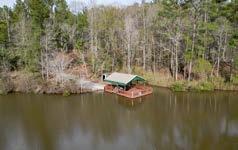
The Adams Place
Greene County, Alabama, 600+/-Acres
The Adams Place represents an elite piece of property. Property of this character, condition, and quality is extremely rare. This beautiful property is located only about 30 minutes from Tuscaloosa and The University of Alabama. It has everything needed for the perfect year-round recreational tract. A super nice camphouse, which overlooks a 10+/- acre stocked lake, with a really nice boathouse and deck, perfect for kids and grandkids to fish off of. The house has 3 bedrooms, 2 bathrooms, a loft, a screened porch, and a big open greatroom-kitchen area. The property has a great internal road system, nice food plots for wildlife, and 540+/- acres of mature hardwood and pine timber (cruise available). It offers great deer hunting, and the turkey hunting is second to none. There is also frontage on the Sipsey River with a concrete boat ramp.
FL Panhandle Listings

Along with hundreds of others across the entire United States

Alabama Listings Autauga Autauga Autauga Autauga Autauga Baldwin Baldwin Baldwin Baldwin Baldwin Barbour Barbour Barbour Barbour Barbour Bibb Bibb Bibb Bibb Bibb Blount Blount Blount Blount Blount Bullock Bullock Bullock Butler Butler Butler Calhoun Calhoun Calhoun Cherokee Cherokee Cherokee Cherokee Cherokee Chilton Chilton Chilton Chilton Chilton Choctaw Choctaw Choctaw Choctaw Choctaw Clarke Clarke Clarke Clarke Clarke Colbert Conecuh Conecuh Conecuh Conecuh Coosa Coosa Covington Covington Covington Covington Crenshaw Crenshaw Crenshaw Crenshaw Dale Dallas Dallas Dallas Dallas Dallas DeKalb DeKalb DeKalb Elmore Escambia Escambia Fayette Fayette Fayette Fayette Fayette Greene Greene Greene Hale Hale Hale Hale Hale Henry Henry Henry Henry Henry Houston Houston Houston Houston Houston Jackson Jackson Jackson Jefferson Jefferson Jefferson Jefferson Jefferson Lamar Lamar Lamar Lamar Lamar Lauderdale Lauderdale Lauderdale Lauderdale Lauderdale Lawrence Lawrence Lawrence Lawrence Lawrence Lee Lee Lee Lee Lee Limestone Limestone Limestone Limestone Limestone Lowndes Lowndes Macon Macon Macon Macon Macon Madison Madison Madison Madison Madison Marengo Marengo Marengo Marengo Marengo Marion Marion Marion Marion Marion Mobile Mobile Mobile Mobile Mobile Monroe Monroe Monroe Monroe Monroe Montgomery Montgomery Montgomery Montgomery Montgomery Morgan Morgan Morgan Morgan Morgan Perry Perry Perry Perry Perry Pickens Pickens Pickens Pickens Pickens Pike Randolph Randolph Saint Clair Saint Clair Shelby Shelby Shelby Shelby Shelby Sumter Sumter Sumter Sumter Sumter Talladega Talladega Talladega Tallapoosa Tuscaloosa Tuscaloosa Tuscaloosa Tuscaloosa Tuscaloosa Walker Walker Walker Walker Walker Washington Washington Washington Washington Washington Wilcox Wilcox Winston COUNTY ACRES COUNTY ACRES COUNTY ACRES COUNTY ACRES
373 372 80 59 48 4615 1995 648 518 448.59 647 351 160 40 5 520 411 367 167 160 547 306 241 86 80 278 105.5 68.22 372 107 21 0.83 0.42 0.4 4 3.09 2.43 0.84 0.79 80 77 25 5.05 4.34 1358 329 204 120 54 620 120 50.27 21 19 4 355 96.5 15 3 126 68 200 100 62 38 986 986 276.5 7 40 933 740 198 193 165 184 117 15 5.78 127 21 495 280 138 138 84 600 104 1.5 258 48 30 7 2.55 200 83 80 60 58 231 54 28 15 4.7 821 230 55 928 294.74 126 106 41 530 350 99 82 70 107 56 51 33 24 190 86.2 81 18 12.4 305 130 15.2 14.28 13.09 294 162 33 19.5 18 1075 112 960 598 82 39 35 90 45 20 8 7.3 1224 182 58 16 10 209 163 160 160 108 770 340 330 217 198 316 198 95 76 25 640 250 200 72 34 58.19 23 4.4 4 0.1 485 310 184 134 130 1119 217 180 167 77 10 161 36 32 31 904 100 65 55 25 568 145 140 1 1 565 444.6 147 204.79 559 470 144 130 120 373 288 120 115 63 1225 564 216 214 192 10 3 2.3 Escambia Escambia Holmes Santa Rosa Santa Rosa Santa Rosa Santa Rosa 168 44 80 80 48.77 20 11
COUNTY ACRES
877.314.1237 // GreatDaysOutdoors.com // May 2024 5
BEST BETS FOR MAY
These are our top targets for hunters and anglers this month!
BY GREAT DAYS OUTDOORS EDITORS

POPPING FOR BLUEGILL
Bluegill, green sunfish, shellcrackers, warmouth, and other members of the lepomid family are always fun, but they’re especially good for the soul when they’re smashing tiny topwater bugs with reckless ferocity. Places to target include cypress knees, steep banks with low hanging branches extending over the water, slackwater pools in creeks, submerged structure, grass edges, and, of course, bedding craters.
Amnesia and Bullet Bugs in sizes 8 and 10 aren’t cheap, but they hold up well and catch fish. Solar Flare, Yella Fella, and Electric Damsel are the editors’ top-performing colors, but black, white, and frog green are also popular choices. Toss them in likelylooking spots, wait for the ripples to fade, count to 10, and then give it a slight twitch. Wait a while, and if nothing hits, give the bug an erratic, wristtwitching retrieve for a few feet before moving on to the next cast. Keep a small pair of forceps handy, because it’s not uncommon at all for panfish to inhale the bug in their excitement.
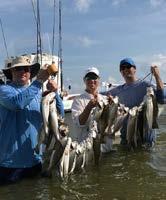
PARK THE BUSH HOG FOR MORE TURKEYS
If you’re a land manager, it can be tempting to start bush hogging. The earlier you get to it, the better, right? Not according to Dr. Michael Chamberlain.
“Turkey hatch dates are around the middle of May,” he reveals. “So you’ve got one-week-old poults that are on the ground, and they’re using these early successional areas that are grassy. There’s a study that’s ongoing right now, up in Tennessee, with Dr. Craig Harper and some others, where they recently reported that during the past few years, they’ve lost about 12% of their nest due to mowing.”
If you think about it, you can potentially see a 12% increase in turkey numbers next year by doing…well…nothing! Sounds like an awesome reason to go fishing this month!
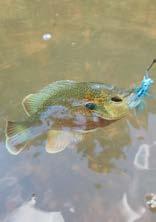
FIND OYSTERS AND GRASS FOR SEATROUT
May is a great time to go wade fishing for speckled trout, but not all shallow water is created equal. Good stalking grounds are shallow, obviously, but unless you enjoy flailing around and struggling to pull your feet free from the muck, you also need a hard bottom. Oyster shells make for easy walking provided that you have good wading shoes to protect your feet. Seagrass beds are also a good candidate for wade fishing. Grass holds bait and the fish that feed on them, and the roots hold the bottom together, allowing you to easily slip around the flats.
Once you’ve identified good wading grounds, target trout with either live croaker, a smallish topwater like the Rapala Skitter-V, or a soft jerkbait such as Pure Flat’s The Slick. Move slowly to avoid spooking fish, and if possible fish with the wind to your back. This facilitates maximum casting distance, letting you cover more water with less effort and stay your distance from spooky fish.

VOLUME 28 ISSUE 5 MAY 2024
PUBLISHED BY:
Great Days Outdoors Media, L.L.C.
PUBLISHER/EDITOR-IN-CHIEF:
Joe Baya
EXECUTIVE EDITOR
Butch Thierry
MANAGING EDITOR: Nick Williams
GENERAL MANAGER: Samatha Hester
CREATIVE DIRECTOR: Wendy Johannesmann
DIRECTOR OF DIGITAL MARKETING
Jarod Bosarge
Great Days Outdoors (USPS 17228; ISSN 1556-0147) is published monthly at P.O. Box 1253 Santa Rosa Beach, FL 32459 Subscription rate is $36 for one-year, $60 for two-years.. Periodicals Postage Paid at Mobile, Ala. and additional mailing offices.
POSTMASTER: Send address changes to Great Days Outdoors Media, LLC PO Box 460248 Escondido, CA 92046
SUBSCRIBERS: All subscriptions begin the first issue for the month following receipt of payment, if payment is received by the 15th. Great Days Outdoors assumes no responsibility for delivery after magazines are mailed. All delivery complaints should be addressed to your local postmaster.
CONTACT US: EDITORIAL | JoeBaya@greatdaysoutdoors.com
ADVERTISING | SamHester@greatdaysoutdoors.com
SUBSCRIPTIONS | greatdaysoutdoors@pcspublink.com
Great Days Outdoors Media LLC P.O. Box 1253 Santa Rosa Beach, Fl 32459 877. 314. 1237 info@greatdaysoutdoors.com www.greatdaysoutdoors.com
All rights reserved. Reproduction of contents is strictly prohibited without permission from Great Days Outdoors Media, LLC.
WWW.FACEBOOK.COM/GREATDAYSOUTDOORS
WWW.TWITTER.COM/TEAMGREATDAYS
WWW.INSTAGRAM.COM/GREATDAYSOUTDOORS
BEST BETS 6 May 2024 // GreatDaysOutdoors.com // 877.314.1237
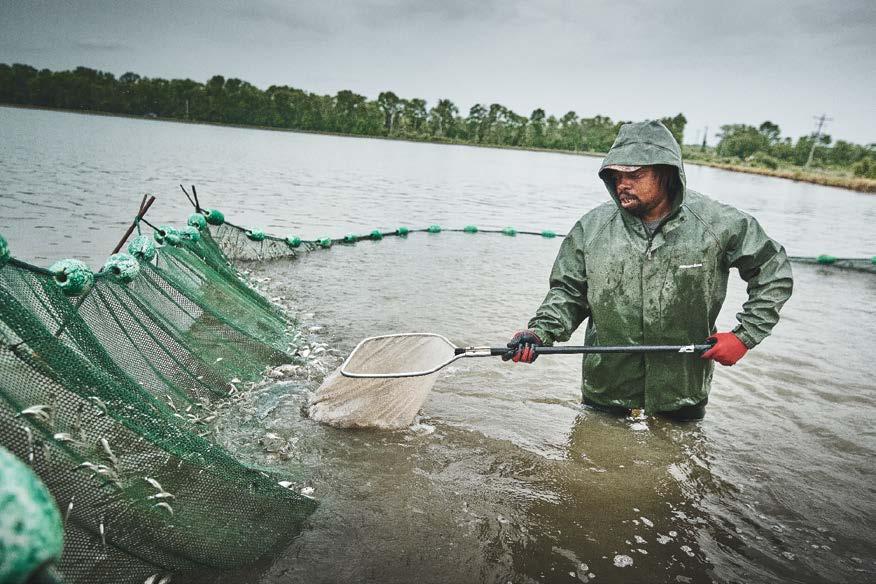
877.314.1237 // GreatDaysOutdoors.com // May 2024 7
Wade Fishing Tactics for Redfish, Trout, and Flounder
BY BUTCH THIERRY
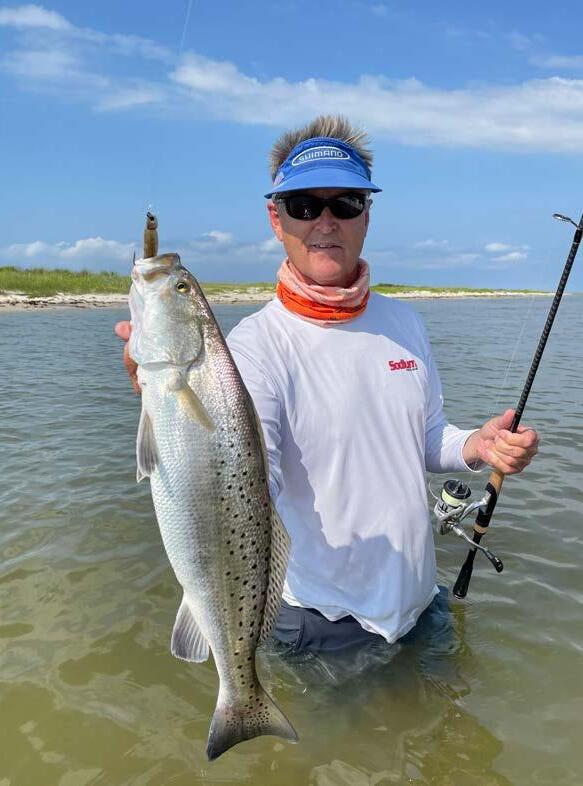
8 May 2024 // GreatDaysOutdoors.com // 877.314.1237
I consider myself a novice when it comes to inshore fishing. I grew up primarily offshore fishing but since I have started hosting the Alabama Saltwater Fishing Report podcast I have grown to love the inshore game. One of my favorite ways to target inshore species is by wade fishing. There is nothing like getting in the water with these fish and watching a topwater blow up at sunrise is an experience like no other. We talked with Capt. Richard Rutland on a podcast recently to get all of the nitty-gritty details that have made him a successful wade fisherman. I do not know about you, but when I get a chance to chat with someone who does this kind of fishing for a living, I pay close attention to the where, how, and why. Most of what we are talking about in this article relates to many different places all along the Northern Gulf Coast.
WHAT IS WADE FISHING?
Wade fishing is a method of fishing that can be very effective for many reasons. Wade fishing away from the boat allows you to be stealthy and a bit sneaky approaching fish or fishy spots. A boat in the water makes a lot of noise and causes water displacement that the fish can feel, especially on calmer days. When wade fishing you want to park your boat at a minimum of 100 plus yards away from your fishing spot. Make sure you use a good heavy anchor and anchor the boat off the beach a little. It takes no time for the waves or a wind change to blow the boat up on the beach, which leads to calling a buddy to pull you off, not to mention if you have a storm blow up on you quickly.
WHAT ARE THE BENEFITS OF WADE FISHING?
The benefits of Wade fishing are summed up in two words: Sneak attack. The boat makes a lot of noise. Of course, you have hull slap, the waves slapping on your hull making noise and you have whatever walking around and beating and banging noise you are doing on the boat. As you are either drifting in or on your trolling motor (Which also makes noise) The biggest thing Capt. Richard thinks about is the displacement of the hull. “As you are moving along, the boat is pushing water in front of you and as you move through the water sucks in behind you, and the fish can feel a much bigger creature in their area. So when you jump in the water and wade, I would not say they totally do not know you are there, but they totally do not know you are there. I know this is true because I have fished flats over and over again from my boat, day after day, and caught a handful of fish. Then go wade that exact spot and it is night and day difference, you can really up your numbers by getting in the water with the fish.”
WADE FISHING SPOTS
When we asked Capt. Richard what he looks for in a wade fishing spot, this is what he had to say. “Recently, I have opened up a lot of doors when I opened my mind a little bit by looking at places through a wade fishing lens. When I start thinking about wade fishing a new spot, I think about places that I have previously had some success from my boat, typically when the water is high. The things that I look for when I am looking for a spot to wade, number one would have to be bait, second behind that will be the bottom type. Meaning grass or oyster shells, you have to have a decent bottom type, you do not want to be sinking in the mud trying to fish, you will be falling all around. When I am looking to wade a spot in a marshy area, I am looking for shells on the bottom preferably, also I look for a creek or some sort of flowing water. The other thing I look for is bottom relief, a real nice area where there are troughs and bars and different water levels. These gamefish are ambush feeders so sit down in these troughs and holes, hiding and water for bait to be washed over their heads to ambush their meal.”
“Most years when approaching late spring and early summer I jump at the opportunity to get on the beaches well before the fish show up. I like to run at a slower speed and really take note of the “lay of the land” and make marks on my GPS to come back later and fish in the future.
Utilizing your GPS does a couple of things for you. I like to start my morning very early and finding a place I am not familiar with in the dark can have its challenges and that recorded information makes things easier. It also provides me with several location options to fish if other fishermen are in any of the
places I marked. Anytime you can find structure on the beach like wrecks, rocks, bulkheads, pilings and clay/mud lumps are great places to start as well. The main ingredient for me though is always finding big schools of mullet. It doesn’t have to be finger mullet sized bait either, I like to see schools of big mullet either jumping or smoking on the surface. When I think about how to catch speckled trout in the surf, I always prefer to be in the water if possible but sometimes that can be tricky due to the sea state.”
SETTING UP A WADE
This is what Capt. Richard had to say about how he sets up the ideal wade. “Generally when I go to set up a wade, the number one thing that I am going to do is set myself up to fish well. Meaning I want the wind at my back and be able to make bomb casts to get the bait as far away from me as possible. I am going to set my boat up where I can slip out of the boat and walk 100 yards and then start fishing with the wind at my back. Being able to cast as far as possible is very important. If you are fishing with your buddy and he may not be able to cast as far as you. If you add up the number of feet you cast and then the number of feet that another angler casts, if you cast 10 feet further over 500 casts on that day, that is almost an extra mile of water being covered at the end of the day!”
WADE FISHING FOR SPECKLED TROUT
We asked Capt. Richard, “What do you do differently to target Speckled Trout specifically while wade fishing?” “I almost always throw plastic when I can, that is what I love to do so that is what I am doing 90% of the time. I generally carry two rods. I am typically going to start out with topwater. If I am throwing topwater and I make some good casts and good presentations and I am not getting bites and I know fish are there, then I am going to go to the Slick Lure”
WADE FISHING FOR REDFISH
“Capt. Richard, What do you do differently to target Redfish specifically while wade fishing?”
“A redfish will almost always react to a topwater presentation, those fish are usually in 2 feet or so or less of water, and they cannot resist that thing twitching around up there.”
WADE FISHING FOR FLOUNDER
“What do you do differently to target flounder specifically while wade fishing?
“For flounder, you are going to have to have a suspending bait like the Slick Lure or a jig head on the bottom, I will slow down my presentation a lot, when I see a hole or a spot that looks like it would be a flounder in there, I cast in there and will slow my presentation down, twitching it a lot slower and keeping it down on flounder level.” I have even gotten to where I will keep a jig head or two with an artificial bait for flounder in my wade tackle box.” Locating flounder I will look for some shell on the bottom or grass banks.” I am looking for deeper water against shell or grass, they love steep drop offs because they are ambush predators.”
WADE FISHING WITH LIVE BAIT
Capt. Richard had this to say about live bait fishing while wading. “When I think about how to catch speckled trout in the surf with live bait, I really favor croakers. They are usually very easy to come by at a few bait shops, pulling a small shrimp net, catching them on hook and line or cast netting them. Live Menhaden are very hard to keep alive but also work very well in the surf. For fishing live croakers, I like to use a 7 ½ foot medium power fast to moderate fast action rod and we fish a free-lined setup with no weight. I prefer a casting rod with 12 lb. monofilament line with a 4-6-foot section of 15-20lb. fluorocarbon leader with a 1/0 to 2/0 Owner SSW live bait hook. I like the casting rig because I can easily free spool the reel and let some line out to allow the fish to swallow the bait. When I get a bite, I usually count four to six seconds before setting the hook. We also use spinning setups with 7 ½ foot rods spooled with 15-20 lb. braided line with a four-foot section of fluorocarbon leader attached with an improved albright knot. To fish this saltwater wade fishing gear, I make long
FISHING 877.314.1237 // GreatDaysOutdoors.com // May 2024 9
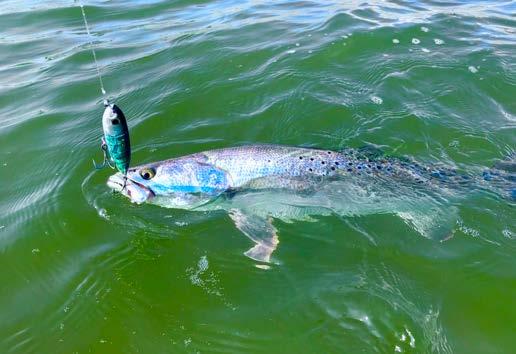
casts into or around the deeper sides of sandbars. I leave enough slack “belly” in my line to give the fish a chance to swallow the bait before I set the hook but, at the same time, keep enough tension on the line so I can slowly work the retrieve back and know when I get a bite. A typical cast and retrieve is about a one to three-minute process.
Sometimes, the whole bait will pull out of the fish’s mouth and, if you can be patient enough and pause, most times you will get another bite quickly. While I don’t know if these bites are from the same fish or other fish competitively feeding in the school, it frequently happens.
In terms of wade fishing baiting, I have found that hooking the bait through the top lip/nose of the croaker is the best route. There is a fine line between not hooking it deep enough or hooking it too deep and that will come with experience over time. It is important to note that if you aren’t getting bites relatively quickly you need to be moving. The beach bite is not really one to turn on and off at certain times. If they are chewing you will know it pretty quickly so always be on the move until you get a bite.”
WADE FISHING WITH ARTIFICIAL BAIT
Capt. Richard says this about wade fishing with artificial baits. “I prefer to fish lures when catching speckled trout in the surf due to the amount of water that can be covered in a short amount of time. Sometimes they are only on the live bait and not lures and other times you can catch them better on lures. If I am not getting bites, I am constantly moving down the beach to find the next school of fish.”
“My morning saltwater wade fishing gear is always a topwater lure, to start. If you get lucky and have very calm, quiet, and smooth conditions I prefer a smaller topwater like the Rapala Skitter-V. When I have a little more wave action and wind, I throw larger topwaters like my favorite, the Heddon Super Spook.
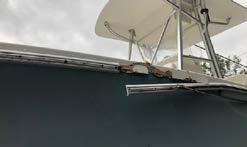
• Custom Fabrication • Premier Repairs • Expert Finish Work • Estimates & Supplies • 14’ Ultralight Tunnel Boats 251-473-3176 2110 Halls Mill Road • Mobile, Alabama 36606 www.fiberplastics.com Time to call Professional Fiber Glass Repair Since 1974 FIBER-PLASTICS INC We can help... Look Familiar?
10 May 2024 // GreatDaysOutdoors.com // 877.314.1237
Wade Fishing Tactics for Redfish, Trout, and Flounder
When it comes to color, pink always seems to be a great color but a lot of days I throw color out the window because it seems like it doesn’t matter. I like to try and match the color to the water conditions. If it’s a clear day with clean water I go with bright colors and if it’s cloudy or off-color water I go a little darker. Topwater is usually an early morning and low light tactic but I have seen many days when they will chew them up all day. You have to throw it to know what the fish are in the mood for that day. My all-time favorite piece of saltwater wade fishing gear and just favorite lure to throw for speckled trout anytime of the year is The Slick Lure. I like this soft plastic jerk bait because of the unbelievable natural action it has in the water and the translucent colors that they carry. I only fish this lure on the Owner Beast 4/0 in the 1/8 ounce weighted hook. The 4/0 hook only comes two ways which is unweighted and weighted 1/8 ounce. I only fish the weighted version year-round. My favorite colors are pink/chartreuse, pearl/chartreuse, goblin, bayou blues, cool beans, and mad mullet. While I primarily like to use Fishbites for redfish and flounder I have found that they also work well for speckled trout. In the Fight Club series, I’ve found that the Brawler five-inch jerkbait in the haymaker color is a winner. I also have had success with the four-inch Butt Kicker paddle tail also in the haymaker color. These are great for those occasions where you may be battling some dirty water conditions. The Haymaker color is a good dirty water color but also the added scent will also help to overcome tough water conditions. One of my other go to colors in the Counter Punch which is a Chartreuse color.
As far as rigging goes, I use from a 1/8 to ¼ ounce jig with a Hogie jig head for either the Brawler or the Butt Kicker and work it a little bit fast on the beach twitching it along pretty quickly. I also like rigging it with a weighted Fight Club weighted swim bait hook for a more subtle approach in calm conditions. I will put those on a 20-pound fluorocarbon leader attached to 15 to 30 pound braid and sometimes a lighter leader in clear water conditions.
You could tie them under a popping cork if you were fishing in dirtier water and for that setup, I use a 2 ½ foot section of leader under the cork attached to a Fight Club weedless hook worked with a 7 ½ foot medium light rod with an extra fast tip and a 2,500-3,000-size spinning reel. This is a great all around go to setup in many different conditions and areas around bays and estuaries.
As far as surf fishing goes for me I do not have a lot of opportunities to sightcast Trout on the beaches but many times redfish make themselves available. The Fight Club series in many different patterns and colors are a great bait selection to take advantage of Redfish on the beach. I like to use the lightest weight that the conditions will allow to avoid making a big slash with the lure and spooking the fish. When casting I like to lead the fish or school of fish by quite a margin and reel the lure back quickly to get in front of the fish. Once you feel your lure is in front of the fish, slow down your retrieve with small twitches to spark a bite.”
FINAL THOUGHTS ON WADE FISHING
The tactics outlined in this article can maximize your success while wading the coastal flats and marshes. Whether it’s targeting gator trout in shallow grass beds, stalking redfish in sandy potholes, or enticing flounder from shell beds or banks, the versatility of wade fishing allows anglers a variety of productive habitats. Remember, success in wade fishing often depends on finding the right spot and being able to set up on those fish in the sneakiest way possible. Take the time to study the water, read the signs of feeding activity, and adjust your presentation accordingly. Utilize a variety of artificial lures and live baits to entice strikes from wary fish, and don’t be afraid to experiment with different techniques and retrieves until you find what works best. So, whether you’re a seasoned wade fishing veteran or just dipping your toes into this exciting style of fishing, I hope Capt. Richard’s wisdom shared in this article will help you elevate your wade fishing game and make unforgettable memories on the water chasing trout, redfish, and flounder.

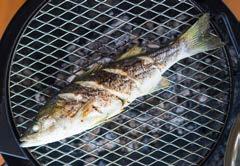 BY HANK SHAW
https://honest-food.net
Image courtesy of Holly A. Heyser
BY HANK SHAW
https://honest-food.net
Image courtesy of Holly A. Heyser
Simple Grilled Whole Fish
Prep: 20 mins • Cook: 15 mins • Total: 35 mins
Ingredients
• 1 or 2 whole fish, scaled, gutted and with gills removed
• Olive oil
• Salt
• Freshly ground black pepper
Instructions
1. Wash the fish well and make 3 to 5 slashes in the meat perpendicular to the backbone on each side of the fish. You are doing this to open the interior of the fish to the heat, so it will cook evenly. Make more slashes closer to the head, where the fish is thicker, than toward the tail, which cooks first. Snip off any sharp fins with kitchen shears or scissors if you want. Leave the tail, as it will crisp up and taste wonderfully nutty. Seriously. Try it.
2. Coat the fish with olive oil and salt it a little more than you think you ought to; salty fish tastes good! Let the fish sit at room temperature for 20 minutes to an hour.
3. Get your grill crazy hot, at least 500°F, and scrape the grill grates well to clean them. When you are ready to lay the fish down, dip a paper towel in some oil and grab it with tongs. Wipe down the grill with the oily towel and them immediately lay the fish down on the grill grates. Let them sizzle nicely for a minute or so.
4. Turn the heat down to medium and cover the grill if you have a gas grill, or just leave the fish on the open grill if you are using wood or charcoal and the grill is very hot. Let the fish cook for a total of 5 to 10 minutes on this side, depending on how thick it is. A general rule is a fish will need 10 minutes per inch of thickness. Estimate this thickness measuring to the fish’s spine - remember you are flipping the fish.
5. To turn the fish, have your tongs in your “off” hand and a big spatula in your good hand. Gently turn the fish over. It should come off the grates cleanly. If not, don’t force it. Let the fish back down and come back at it with the spatula, using pressure to pry it off the grates. You don’t want to pull the fish away from the grates and have half the skin and meat stick to the grill. Once the fish is flipped, let it cook for another 5 to 10 minutes.
6. Once the fish is ready -- check by making sure the meat closest to the bone in the slash that is closest to the head of the fish is fully cooked -- put it on a platter and serve, with a sauce or not.
877.314.1237 // GreatDaysOutdoors.com // May 2024 11
Wade Fishing Tactics for Redfish, Trout, and Flounder
Catching whiting
is a blast whenever conditions allow .
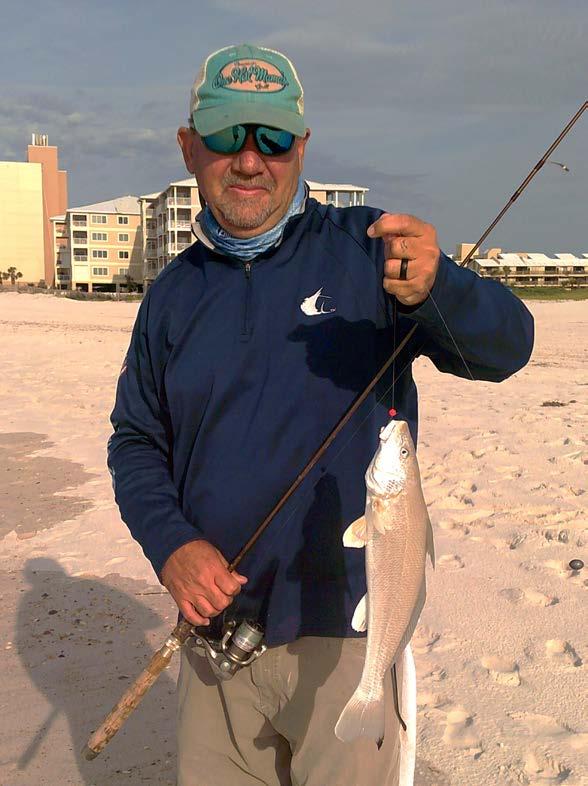
12 May 2024 // GreatDaysOutdoors.com // 877.314.1237
from shore on ultralight tackle
Gulf Kingfish (AKA Whiting) Fishing
The Expert’s Guide
BY DAVID THORNTON
WHAT’S IN A NAME?
Likely the first and most common fish that anglers encounter in the surfzone along the north central coast of the Gulf of Mexico is the Gulf Kingfish (Menticirrhus littoralis), locally referred to as “whiting”. Although “whiting” is a local name often used interchangeably with “ground mullet”, that term usually refers to the two other closely related species in the genus Menticirrhus (Southern and Northern Kingfish). Thus the confusion in what to call each of the three closely related species that are so similar looking. In fact, the state of Alabama does not even differentiate between the species when record keeping. And even though they are also referred to as “kingcroakers” they do not make the characteristic croaking sound of the typical Atlantic Croaker, their distant cousin in the family Sciaenidae which include drums and croakers.
Menticirrhus translates from the Latin words mentum, meaning “chin”, and cirrhus, which means “barbel”. This describes the single appendage under the mouth used in detecting food, often in roiled waters or even in the dark at night.
The three species’ Latin name refers to the habitat or location where they are most commonly found: littoris translates roughly to “shore”, americanus means “of the Americas”, and saxatilus means “dwelling among rocks” (or shells). Though all three species are frequently encountered in schools throughout this region, it is unusual to find all three in the exact same location simultaneously. As their binomial names infer, the preferred habitats of kingfish are different enough to keep them mostly separated, though their territories frequently overlap, mainly due to their similar diets of small benthic invertebrates. While the Southern Kingfish prefers deeper channels and bays near the mouth of estuaries (thus the East Coast name “Channel mullet” and Gulf Coast moniker “ground mullet”), the Gulf and Northern varieties are rarely found away from a high salinity surfzone environment.
WHITING FACTS
Stock assessments are not generally tracked for the kingfish species, but catch surveys by NOAA show a cyclical abundance relatively coincident to the lifespan of individual fish. This would suggest some years provide stronger spawning cycles of about every three to five years. Though recent recreational anecdotal reports would indicate a downturn in reported kingfish numbers, that could simply be the result of localized depletion around areas that receive the most angling pressure and retention of whiting. From-shore beach and shore guides have noted this effect over the past ten years or so, along with a general increase in angler numbers and prowess. Their answer was to self-regulate their harvest of these unregulated species to no more than ten fish over ten inches per angler per day.
Kingfish grow rather quickly through their first year, averaging almost an inch per month. And most are sexually mature around their first birthday, once they reach eight to ten inches. At that point their growth rate slows markedly, to about one to three inches per year. But they are fairly long-lived, maxing out at over twenty inches in eight to ten years. Though the numbers of larger length
individuals decreases almost exponentially each year, as they are heavily predated upon by bluefish and other toothy fish as well as animals like loons and dolphins, not to mention shore-bound anglers.
HOW BIG DO WHITING GET?
The IGFA record Kingfish, listed as M. littoralis, weighed in at three pounds, thirteen ounces, and was caught in 2020 in North Carolina. IGFA lists the record M. americanus as two pounds, thirteen ounces (2002 from Virginia Beach, VA), and the record M. saxatilis as two pounds, thirteen ounces (from North Carolina in 2002).
As mentioned previously, Alabama does not differentiate between the Gulf and Southern species, but records two pounds, sixteen ounces (three pounds?) as the record (caught April 9, 2001). Florida’s latest record whiting/kingfish is 2.8 pounds caught from Santa Rosa Beach in 2021. And Mississippi records M. littoralis at two pounds zero ounces (in 2014), and M. americanus at 2 pounds 0.84 ounces (in 2017).
About twelve inches is the average size for most whiting, when they are between two and three years old. Near fourteen inches long, kingfish weigh around a pound and are between three and four years old. At sixteen to seventeen inches kingfish weigh about one-and-a-half pounds and are over five years old. And a two pound whiting is usually nineteen to twenty inches long, and probably seven years old, or more.
WHERE TO FIND KINGFISH
The Gulf Kingfish is well adapted to the harsh littoral environment, spending its lifespan fighting strong waves, currents, and numerous predators both in the water and out. They are easily identified by their gray back, silvery sides and white belly, but mostly by their tell-tale black spot on the tip of the tail. This distinctive marking is likely a defensive measure evolved to confuse predators, tricking them into mistaking the tail of the fish for its head. The Southern and Northern varieties have angular dark gray lines on their sides and no black tip on their tail. The Northern Kingfish also sports a characteristically long, dark colored dorsal fin.
The Gulf and Northern Kingfish are most often found in the surfzone in relatively shallow water, seeking refuge from water-bound predators, resting, or feeding on benthic invertebrates such as sand fleas, beach ghost shrimp, coquina clams, and augers. As the water calms and gets clearer between storm systems, and in bright daylight, these kingfish generally move into slightly deeper water. The schools tend to meander into any longshore current that may be available. So, whenever a sideshore wind is sustained long enough, or strong enough to create wind driven currents, feeding kingfish tend to orient and move into it. Often the key to an angler finding them is to fish along a sandbar dropoff where food items may be swept off the bar into relatively deeper water. The kingfish, and perhaps other predatory fish such as pompano, small redfish or
FISHING
877.314.1237 // GreatDaysOutdoors.com // May 2024 13
Gulf Kingfish (AKA Whiting) Fishing - The Expert’s Guide drum, flounder, bluefish and even speckled trout stage just below these edges where their hapless food items are pushed, so they can avoid the full force of the current.
Often this feeding window is triggered by changes in the tide level and direction, which depending on the water depth in the trough provide relative safety for kingfish to feed in. They only need a couple of feet on an incoming tide, but perhaps twice that on the outgoing tide when they fear being stranded and an easy meal for shore patrolling herons.
Kingfish often feed along deeper sandbar drop-offs too, especially along the longshore sandbar whenever waves or currents potentially push prey items to them. Plus they tend to feed around the edges of beach points where the bottom profile gradually gets deeper, especially as the tide rises. Finding kingfish feeding on points is generally more difficult as they tend to spread out where there is only a gradual change in water depth. The same goes when they are feeding in a trough, near or far from shore, where the bottom depth usually only changes gradually. So if you can locate a shelf edge in deeper water, usually indicated by a color change, that might be a good money spot.
HOW TO CATCH KINGFISH
Lures are not commonly used to target kingfish, though larger specimens may be caught occasionally on bottom hugging jigs (like the Goofy jig), or weighted Gulp shrimp in the 2 ½ or 3 inch sizes. Also, the proclivity of all three kingfish species to readily bite Fishbites is well noted and widely exploited by pier and shore anglers.
Fresh dead shrimp, cut up in thumbnail sized pieces, very closely mimics mouth-sized sandfleas that kingfish feed upon most when the water temperature is above seventy degrees, while ghost shrimp or beheaded fresh shrimp smaller than your little finger make a good bait the rest of the year. A mistake
kingfish can fit into its mouth. Their characteristic feeding habit is to approach the bait cautiously, and strike to stun it. Then they circle around to line up the bait and suck it into their mouth. The best time to strike is as they swim away. A small, #6 kahle single hook is very effective for this method. But the type of bait, hook style and size, along with the presentation type, and amount and style of weight used can be altered to determine the most effective under the circumstances encountered. Kingfish are very wary, even finicky, and will scatter when a heavy weight splashes down nearby. Many times in calm, clear water, a light or ultralight presentation will be most effective, and fun! Experimentation and results between Carolina rig, versus Fishfinder rig, single drop, or double drop become more evident as an angler gains more experience with each method.
THE FUTURE OF KINGFISH
Fortunately for kingfish, and anglers, they are quite prolific. They spawn throughout much of the year, while the water temperature is above seventy degrees (April to November). This assures their relative abundance, thus kingfish are not currently regulated and only rarely commercially harvested.
Like many other fish species found in the Gulf, smaller mature kingfish are most often males, and the larger specimens are most likely females. The relative fecundity (ability to reproduce each year) of kingfish is directly proportional to the size of the fish. Thus the number of eggs produced by a 16 inch kingfish (4 or 5 years old) may be more than twice that of each 12 inch (1 year old) kingfish breeding for the first time.
Problem for the kingfish is the size of the fillets are relative too. Thus anglers are tempted to keep and eat every large kingfish they catch, because they are so darn delicious. So that means from-shore anglers must be responsible enough when harvesting them for food or bait to assure they never are regulated, and that kingfish continue to remain abundant throughout the region for
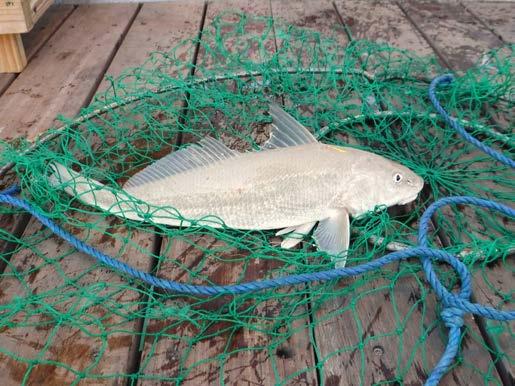
14 May 2024 // GreatDaysOutdoors.com // 877.314.1237
Large whiting over 18 inches caught from gulf beach piers on ultralight tackle are often netted just for safe measure .
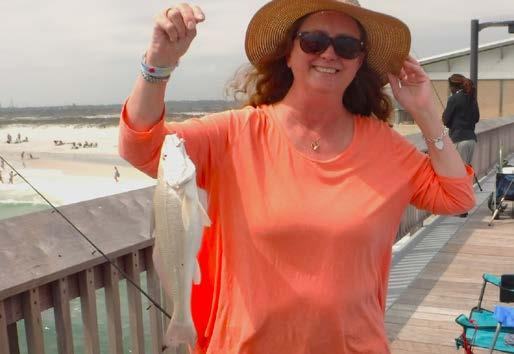


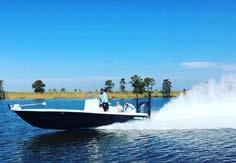




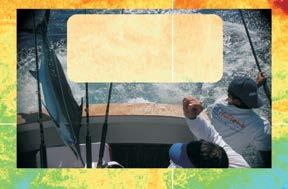



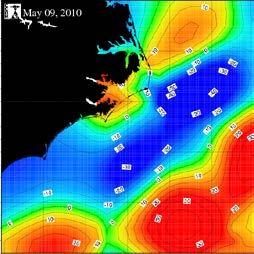


An Online Map Server Catch More Fish Using Less Fuel! www.Realtime-Navigator.com Whiting fishing is a fun family sport for all pier anglers Gulf Kingfish (AKA Whiting) Fishing - The Expert’s Guide Capt. Richard Rutland 251.459.5077 richard.rutland@yahoo.comwww.coldbloodedfishing.com richard.rutland@yahoo.com www.coldbloodedfishing.com Speckled Trout Tripletail Redfish Flounder USCG Licen d & InsuredDauphin Island Alabama CAPT. RICHARD Capt. Richard Rutland 251.459.5077 richard.rutland@yahoo.comwww.coldbloodedfishing.com Speckled Trout Tripletail Redfish Flounder USCG Licen d & InsuredDauphin Island Alabama Inshore and Offshore Fishing Charters USCG Licensed & Insured Dauphin Island, AL Follow us on Facebook and Instagram @coldbloodedfishing Inshore and Offshore Fishing Charters USCG Licensed & Insured Capt. Richard Rutland 251.459.5077 Speckled Trout Tripletail Redfish Flounder Capt. Richard Rutland Inshore Fishing Guide Service 251.459.5077 richard.rutland@yahoo.comwww.coldbloodedfishing.com Capt. Richard Rutland Inshore Fishing Guide Service 251.459.5077 richard.rutland@yahoo.com www.coldbloodedfishing.com Speckled Trout Tripletail Redfish Flounder USCG License d & InsuredDauphin Island Alabama CAPT. RICHARD RUTLAND 251.459.5077 Capt. Richard Rutland
Speckled Trout Tripletail Redfish Flounder USCG License d & InsuredDauphin Island Alabama Inshore and Offshore Fishing Charters USCG Licensed & Insured Island, Follow us on Facebook and Instagram @coldbloodedfishing Dauphin Island, AL Capt. Richard Rutland 251.459.5077 richard.rutland@yahoo.com www.coldbloodedfishing.com Follow us on Facebook and Instagram @coldbloodedfishing 877.314.1237 // GreatDaysOutdoors.com // May 2024 15
richard.rutland@yahoo.comwww.coldbloodedfishing.com

16 May 2024 // GreatDaysOutdoors.com // 877.314.1237
How to Turn Your Food Plot Into A Dove Field
BY JOE BAYA
A dove field, cultivated specifically to attract mourning doves, serves as a crucial habitat for sustaining dove populations. The establishment of dove fields doesn’t solely cater to dove enthusiasts. Done properly, these habitats can contribute to the broader ecosystem by providing resources and refuge for other wildlife species. In recent years, concerns have arisen regarding the declining numbers of mourning doves across various regions. Both private landowners and leaseholders are increasingly acknowledging the importance of creating and maintaining dove habitats if they want to have good hunts.
The problem is, in timberland-dominated landscapes, food plots and clear-cuts are often the only significant openings in the forest canopy. This begs a question. Can you turn a food plot into a viable dove field?
With proper planning, the answer is, “Maybe.”
Drawing upon insights from state agencies, private landowners and leaseholders can glean valuable knowledge on effective habitat management practices. On the Huntin’ Land Podcast I recently interviewed Seth Maddox, The former Migratory Game Bird Coordinator and current Assistant Chief for the wildlife section Alabama Department of Conservation and Natural Resources to discuss this topic and find out how hunters can (and can’t) manipulate their food plots for a dove hunt this year.
DOVE FIELD PLANTING - WHAT’S THE BEST DOVE FIELD SEED MIX?
When it comes to choosing a seed mix and determining a planting date, it all comes down to understanding your seed maturation.
Seth Maddox had this to say, “Corn is probably the longest maturation crop out there. So you’re talking about April/May when you put your corn crop in to be ready by dove season. Later plantings could be grain sorghum sometime after that, in May/June. If you want to plant Sunflowers it’s probably May/June. Millets have a much shorter maturation, especially Brown Top or Proso Millet, you’re talking 30 to 45 days of maturation. So you could put that stuff in late July and still have a bumper crop in September when the season opens.”
WHEN IS IT WORTH CREATING A DOVE FIELD IN A FOOD PLOT?
With so many food plots being planted for deer and turkeys, and those food plots being often the only forest canopy openings available to both private landowners and leaseholders on many tracts of land, it only makes sense to consider planting your food plots with doves in mind. But is the juice worth the squeeze?
“It depends, but you can have a successful plot on as little as half an acre.” said Maddox, “It just depends on the number of hunters, the number of birds in the area, and how you prepare the field. Typically, if you can have 2-5 acres, somewhere in there, that’s a good start.”
OPTIMIZING A DOVE FIELD LAYOUT
“The way we manage our dove fields on our SOA’s, I take an aerial photo, lay a grid over the top, and I’m typically putting one hunter per acre. If you know the people a little more and they’re seasoned hunters, you can probably squeeze them in a little
HUNTING 877.314.1237 // GreatDaysOutdoors.com // May 2024 17

tighter than that,” said Maddox when asked how many hunters are ideal per acre of dove field. “On the larger fields, you could probably tend to hunt those a little more frequently throughout the season than you could on a smaller field.”
There’s even more to planning a successful hunt than just determining the right planting and optimizing the number of hunters. The next step is determining where to place your hunters.
“If you have a good square field, I take an acre-size grid over an aerial map and I put a dot in the middle of that [each grid]. I’m putting a hay bale on that dot or I’m putting them in the edge on the edge of the field on that dot. If you’re on a hunt, where you know most of the hunters and they’re well-seasoned hunters, you can eyeball 50 or 75 yards apart, something like that.”
FINDING (OR CREATING) THE HONEY HOLE IN A DOVE FIELD
If you’ve done much dove hunting, you’ve probably experienced a hunt where you were either on or off “the x”. If you get to pick your spot, where should you sit?
Seth had this to say, “If I’m looking for the honey hole, I’m looking for a snag, (a dead tree), or some type of power line. The doves will come into the field and they like to perch somewhere prior to going to feed. They want to see what’s going on in that field be -
fore they go down and put themselves in danger from a predator. So another good practice is leaving dead trees. You may go try to kill those trees, notch them, put some herbicide on them, and just let them stand. So once the leaves fall off, it makes a great perch for doves.”
FINDING OR CREATING GREAT DOVE FIELDS NEAR ME
In addition to your food plot acreage, another great option for creating a dove field on your land or lease is a fresh clear-cut
“Clear cuts can be really good areas for the first couple of years after they’re cut, especially if you keep them burned. If you’re putting fire through it, it produces forbs. The seeds that are in the ground, they’re going to grow and produce seeds. That’s food for doves, and the ground is going to stay pretty open for the most part, especially if you’re putting fire through it.”
GIVE FOOD PLOTS A TRY THIS DOVE SEASON
Nothing is holding you back from planting and manipulating your food plot acreage to attract and hold more doves, but the planning starts now if you want to experience good hunting later this year. If you want to take part in Alabama’s public dove hunting, visit the Outdoor Alabama website to stay up to date on application dates and license requirements.
How to Turn Your Food Plot Into A Dove Field
18 May 2024 // GreatDaysOutdoors.com // 877.314.1237

With a new lightweight asymmetric X2-Cräftic™ alloy frame design, increased handle size for more torque, and best-in-class Power Stack Carbon Matrix Drag System,™ the latest Revo® STX pushes the limits of speed, precision and power for a go-to reel to out-fish the competition on any given day.
ENGINEERED TO FURTHER REMOVE LUCK FROM THE EQUATION.
FISH TO WIN
Revo STX Reels
©2023 Pure Fishing, Inc. 877.314.1237 // GreatDaysOutdoors.com // May 2024 19
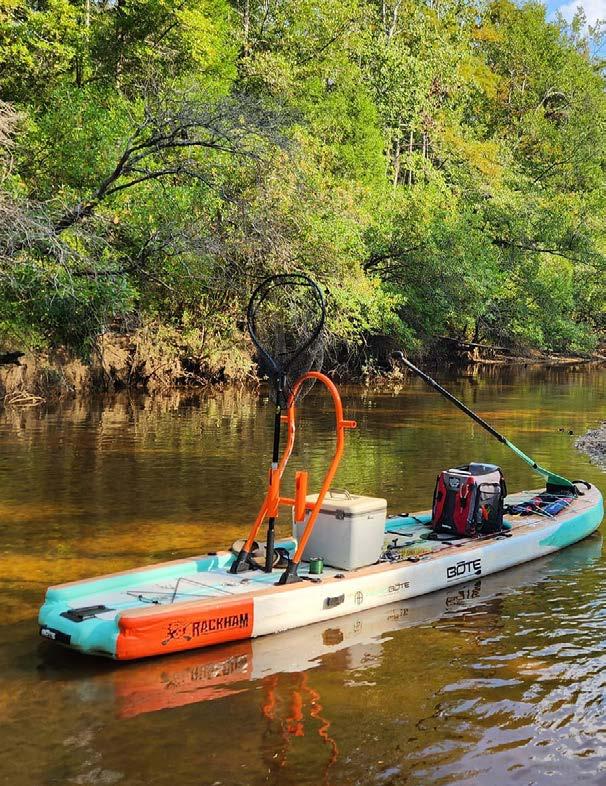
Is a Fishing Paddle Board Right for Me?
BY NICK WILLIAMS
20 May 2024 // GreatDaysOutdoors.com // 877.314.1237
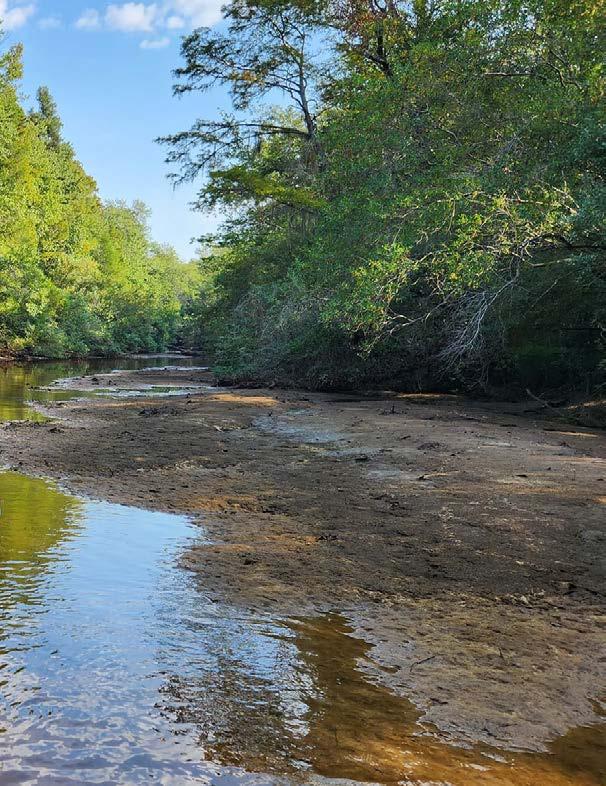
I’ve fished out of a lot of small watercraft. Twelve foot jon boats, canoes, kayaks, micro skiffs…even honest-to-god, handmade wooden pirogues. I’ve fished a lot of waterways, but I’ve always been at my happiest snaking up fishy-looking little creeks too small for conventional watercraft. The fish in these streams usually aren’t very big, but they’re plentiful and dumb, and a paddle craft is usually the best way to get at them.
The first time I saw a stand up paddle board, I was skeptical. “I guess that’s the new fad,” I snidely remarked to my wife as we watched a teen paddle one along the shore of Mobile Bay. But as is often the case, I’ve had to eat my words.
THE APPEAL OF FISHING PADDLE BOARDS
Last year, BOTE was kind enough to send Great Days Outdoors staff a paddleboard to test and review: a Rackham Aero 12′4″ Bug Slinger, to be exact, complete with all the fixings. Three large boxes showed up at the office, containing the inflatable board, pump, tackle rack, seat, paddle, and even BOTE’s drop-in pedal drive unit.
The first time I took it out for a spin, I left my fishing gear at home. To be honest, I was more than a little skeptical of the integrity of the inflatable hull. My home river is full of cypress knees, shell banks, and old debris, and I figured if I sprung a leak I’d rather not be scrambling to save a rod or tackle box.
First impressions were begrudgingly positive. Aside from a bit of a struggle to fit the pedal drive unit into its port, the drive system functioned well. I was able to cruise at 3-4 mph comfortably, which I thought was acceptable for a paddle craft. I worked up the nerve to stand and paddle, and was really blown away with how secure I felt in doing so. Paddling was much slower, but from a standing position and wearing polarized lenses, I had an excellent view of the bass, pickerel, bowfin, buffalo fish, and panfish that inhabited the small creek I was exploring.
The appeal of paddle boards started to dawn on me. I was able to stealthily glide across the creek, making very little noise. Combined with my higher vantage point, I was seeing fish that I usually wouldn’t have been aware of.
That evening I purchased a sand spear to use with the board, and packed a tackle bag, Engels bait cooler, and medium spinning rod. Come sunrise the next morning, I was back on the creek. I tied on a long, fluorocarbon leader and a 2/0 bait hook, and nose-hooked a live shiner to freeline at any fish I saw. I placed the rod in the rod holder on the tackle rack, and let out just enough line to let the shiner swim in the water. I picked up my paddle, and started easing down the creek looking for fish.
What followed was one of the best mornings of creek fishing I’ve ever had. From a standing position, I was able to quietly cruise up the creek looking for fish in the clear water. Once I spotted a target, I could quickly stick the paddle in the paddle holding slot in the bow of the board, grab the rod, and flip a shiner towards my target. The fish were hungry, and the result was usually a strike within seconds of presenting the bait. Fighting and netting the fish was much easier on the board than it was sitting down in a canoe or kayak, and if I saw a deep hole or sunken log that warranted slower, more careful fishing, it was easy to quickly stick the anchor spear through the well-thought-out hole. The paddleboard effortlessly floated across shallow spots that were barely ankle deep, and in some places I simply anchored the board and stepped off to wade fish the sandbars.
877.314.1237 // GreatDaysOutdoors.com // May 2024 21
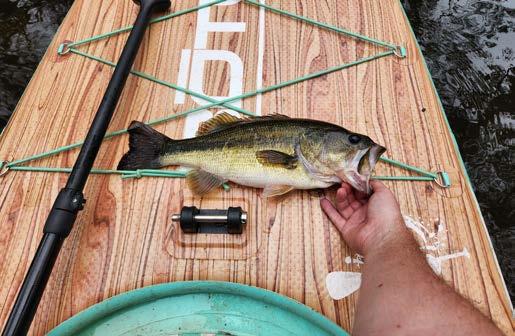
I fished through my live bait, catching plenty of bass and pickerel, as well as a nice bowfin and a couple of channel cats. I then switched over to a ned rig, and caught fish on that until a hankering for lunch set in. As I paddled back to the launch, all I could think about were how many little creeks and ponds this board was going to let me float and fish.
FISHING SUP FACTORS TO CONSIDER
I realized that day that stand up paddle boards (SUPs for short) were surprisingly practical for freshwater anglers, especially those who like to fish “skinny.” Over the past year, I’ve put that Rackham Aero in a lot of water, and have caught a lot of fish both on conventional and fly fishing tackle. I’ve grown to love the open floor plan, the well thought out rack and accessories, and the soft, comfortable, and quiet hull. My canoes and jon boat have largely sat neglected in my yard, because in addition to being very fishable, the SUP is just plain fun to paddle around!
With that in mind, there are a few things you need to keep in mind before deciding if a fishing SUP is right for you.
PHYSICAL FITNESS AND BALANCE
SUPs scare a lot of anglers, but fishing-specific models are surprisingly stable. The Rackham I have measures 38” wide at the beam, which is wider than any canoe or kayak on my rack. It’s even wider than the floor of my small jon boat. With this generous width and a 400 lb weight capacity, the Rackham Aero is bigger than it looks, and fishes well in small, calm water.
That said, your center of gravity is much higher on a SUP than in most paddlecraft. After a day of fishing on mine, I usually wake up a little stiff. Keeping your balance for hours on end will activate muscles you didn’t know you had if you’re a keyboard jockey like the author. Paddleboard fishing is definitely a more active form of fishing, which is something to keep in mind. I enjoy it, but there are some evenings where I’m looking for relaxation on the
water instead of exercise.
TYPE OF FISHING AND WATER BODIES
While I see lots of promotional material showing paddleboards out in open water, I would not personally want to take one out in areas that might be exposed to strong winds or currents. Even a light chop results in soaked feet as waves wash over the board, and it’s hard to make headway into the wind with your body acting as a sail. The skeg on my board definitely helps with tracking (as I found out on a trip where I forgot it) but making strong headway in a straight line in wind and current is more difficult for me in a SUP than in a canoe or kayak.
Open water just requires much more exertion, both physical and mental, when fishing from a paddleboard. I fish much more effectively from mine in calm water. Think small, protected lakes; ponds, and moderately flowing creeks and smaller rivers. A paddleboard shines in these areas, particularly if there’s no boat ramp access to them. My board is much lighter than a fishing kayak with equivalent deck space, and even when fully inflated it’s much easier to transport into remote fishing spots than a kayak or canoe.
I haven’t tried it yet, but I think a SUP would also make a great vehicle for an overnight float on a sandy river. There’s definitely enough deck space for a dry bag with a tent and sleeping bag, and I suspect I could use the inflatable board as a sleeping mat with a little planning.
STORAGE AND TRANSPORT
Perhaps the most unique feature of the Rackham Aero is the ability to deflate it for storage and transport. Many anglers drive small vehicles and live in small homes with small or non-existent garages and yards. Storing a boat, even a kayak, can be difficult in these circumstances. An inflatable paddleboard can be tucked away into a closet, making it perfect for storage space challenged anglers.
Is a Fishing Paddle Board Right for Me?
22 May 2024 // GreatDaysOutdoors.com // 877.314.1237
ACCESSORIES
The demo model paddleboard we were sent came with “all the fixin’s.”
Something that I feel like BOTE really has in-the-bag is their accessories, which seem really well thought-out. The Tackle Rac that came with mine is really slick, and makes it easy to store and access a rod, a landing net, a life jacket, and a tackle bag. I can’t imagine trying to fish from the board without it. The Rackham Aero is also compatible with BOTE’s Bucket Rack and KOOLA cooler, which doubles as both an ice chest and a seat. These addons are spendy, but they do a really good job of solving basic storage needs in a streamlined manner. Whichever direction you go, definitely take some time to consider how you’ll organize your tackle and must-have gear. A SUP is surprisingly roomy, but space fills up quickly and it’s easy to inadvertently knock gear into the water when fighting a fish.
FISHING PADDLE BOARD PROS AND CONS
After several months of fishing, I feel like I’ve got a pretty solid grasp of what my specific paddleboard can and can’t do.
For starters; the good. An inflatable paddle board like the one I have is super quiet, weighs very little, and drafts almost nothing. I really feel like it’s a perfect watercraft for the type of fishing I like the most; small, intimate streams. It’s easy to launch in those little out-of-the way places under bridges or at dead-end dirt roads, and it lets you easily fish those creeks that are too small to get a “real” boat in but too deep to wade. It is also much easier to fish out of than a kayak or canoe, especially in shallow water where “dropping anchor” is as simple as shoving a sandbar spike through an integrated hole in the board and into the bottom. It also takes up almost no space in storage when deflated.
Now for the bad. I feel like you sacrifice performance with an inflatable paddleboard as opposed to a hardshell. My board has no “glide;” if you’re not paddling, it’s not moving! It also has no keel, relying instead on rear skegs to keep the board tracking straight. A long distance cruiser the Rackham Aero is not, in my opinion. The modest performance gets worse when wind and current are introduced.
Of course, the Apex Pedal Drive system does mitigate this drawback a bit. The prop-driven system propels the boat with a bit more power than you can achieve from a standing position, and has been problem-free for me as long as I was diligent about keeping the set screws on the steering cable system tight. If you find yourself traveling further than a mile or two on a trip, I think the drive system is a good investment.
However, to use the pedal drive you have to sit down, and I’m not a huge fan of BOTE’s inflatable seat. It doesn’t agree with my back at all, and the vinyl doesn’t breathe at all, which makes for a…swampy…backside after a few hours in warm weather. But I like the idea of the seat, which allows you to use the board as a paddle board, sit-on kayak, or pedal drive boat.
CONCLUSION
I feel like the Rackham Aero really shines for anglers who don’t have the space requirements for a bigger hull, who travel a lot, or who really enjoy stealthily fishing skinny water. While I initially dismissed it as gimmicky, you can tell that BOTE has put a good bit of effort into making a very fishable little craft. The drive system is unique and functional, the Tackle Rack is superb, and little details like the sand spear sheath, paddle slot, and MagnePod tumbler holder are well thought out.
Overall, I’ve been pretty impressed with the board. I find myself deliberately looking for new creeks to fish with it, and leaving my other boats high and dry on the trailer. The truth is that small creeks often provide simpler, more productive, and more enjoyable fishing than bigger bodies of water. The Rackham Aero is the perfect tool to fish those intimate bodies of water.



CAMPER CITY TRUCK ACCESSORIES Specializing in Truck Toppers + Accessories • Spray-in/Drop-in Bedliners • Bug Shields • Gooseneck & 5th Wheel hitches • Vent Visors • Running Boards • Warn Winches • Bed Covers Mobile 1051 N. Schillinger Rd. Mobile, AL 36608 (251) 633-9004 1-800-431-6692 Pascagoula 1340 Denny Ave. (Hwy 90) Pascagoula, MS 39567 (228) 762-6082 1-877-732-8782 hattiesburg 7166 Hwy. 49 N. Hattiesburg, MS 39401 (601) 296-1800 1-888-730-0432 And MORE!
Is a Fishing Paddle Board Right for Me? 877.314.1237 // GreatDaysOutdoors.com // May 2024 23
Investing in
artificial fish attractors
will pay off for landowners with ponds or small lakes.
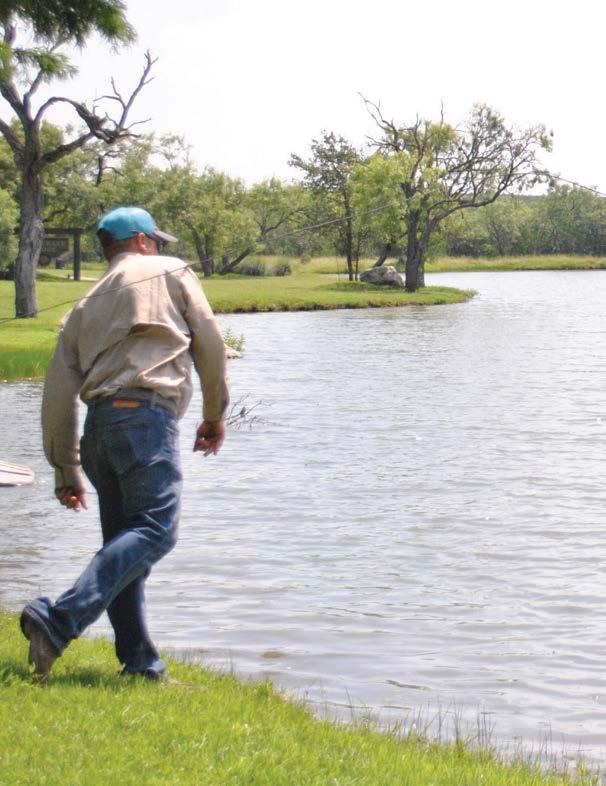
Fish Grass made by Texas Hunter Products gives fish a place to hide that doesn’t rot or have to be replaced. It’s also snag-proof.
24 May 2024 // GreatDaysOutdoors.com // 877.314.1237
Which Fish Attractors Are Right for Your Pond?
BY JOHN E. PHILLIPS
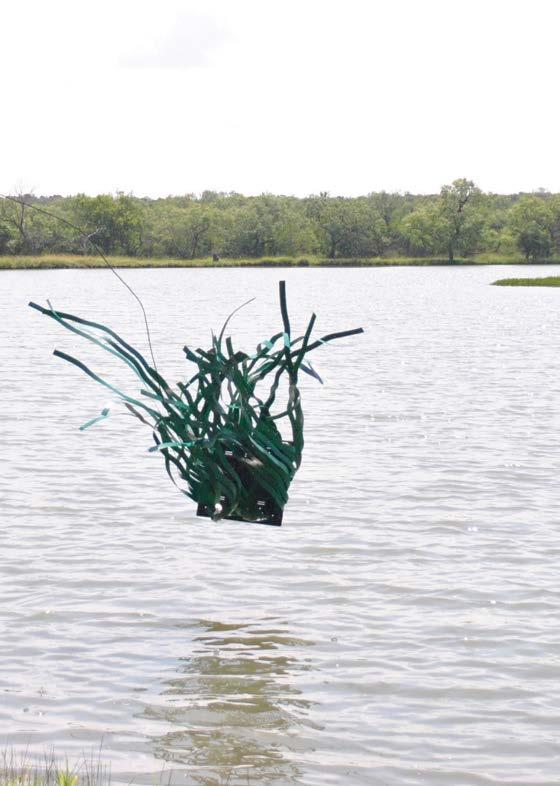
When a fish spots a lure, oftentimes it can’t tell whether that lure is an artificial lure or a live baitfish. If it swims like and is colored like a live baitfish and is in a place where a live bait may be, the fish will attack that lure. Some of the advantages of using artificial structure like fish attractors in a lake or a pond include that you can place a lure in that structure, and it will look natural. That structure doesn’t have to be replenished or replaced but does provide the type of habitat where bass, bream and/ or crappie want to live. You also can place that artificial habitat in areas where fish will feed, making locating fish to catch much easier.
WHY DEVELOP ARTIFICIAL FISH ATTRACTORS
Great Days Outdoors talked with Cody Borgfeld, the general manager for Texas Hunter Products, a company well-known for its directional fish feeders and deer feeders. “Our company wanted to develop more products for the fishing community that would help anglers locate fish easier and quicker and provide habitat for fish that didn’t have to be replaced like wood structure did.”
“Chris Blood with our company started working with the design and engineering teams at Auburn University in the Industrial Design and Fisheries departments to develop numerous ideas. The most-innovative designs were field tested by top fisheries biologists with leading lake-management companies across America. Then their feedback was incorporated into the final patent-pending designs. Collectively, they developed four, different types of artificial fish attractors in various sizes.”
Artificial fish attractors come with a bunch of cool perks for folks who love fishing in ponds and lakes. First off, they’re like a magnet for sportfish, making them super popular among anglers. But it’s not just about attracting the big fish; these structures also serve as a home for algae, plankton, and other tiny critters that baitfish munch on. This means they help keep the food chain buzzing by protecting, conserving, and boosting the production of these smaller fish. Plus, they’re built to last, using materials that are friendly to the environment and won’t get beaten down by the sun’s rays or fall apart over time like natural hideouts can. You can either anchor them down or hang them up, and they’re designed to create cozy spots of shade that bass and other sportfish can’t resist. The design is also pretty neat because it won’t snag your fishing line, making for a smooth fishing experience. These attractors are made to withstand the test of time, proudly produced in America. And they’re simple to assemble, meaning that you won’t need to pull out your toolbox.
FISHING 877.314.1237 // GreatDaysOutdoors.com // May 2024 25
Spawning habitat can be placed in shallow water and used by both bass and bream

WHAT TYPES OF FISH ATTRACTORS ARE AVAILABLE FROM TEXAS HUNTER PRODUCTS?
Lily Pads
As Borgfeld explains, “Most of our company’s artificial fish attractors are underwater, but we do manufacture lily pads that are designed to mimic real lily pads. With these artificial lily pads, a pond owner doesn’t have to be concerned about controlling pond weeds. The lily pads are the only design for our artificial fish attractors that are above water. They actually float. Bass like to get under lily pads, especially in the hot summer months, to find shade and ambush points. Our lily-pad fish attractors are extremely productive for anglers fishing with topwater lures.”
Fish Pyramids
“The most-popular fish attractor we offer is the fish pyramid, which is a protective habitat that has multiple holes where bluegills and other forage fish can congregate and be protected,” Borgfeld says. “These fish attractors have what we call shade blades that pass through the attractors and collect algae. So, besides protecting the forage fish, this fish attractor provides food in the form of algae for smaller baitfish. These attractors give forage fish a chance to grow and reproduce more forage fish before the bass feed on them.”
“We offer two sizes of fish pyramids: a small fish pyramid and an XL fish pyramid. The pyramids are our midwater fish attractors. You actually can sink this device to the bottom though, or you can suspend it in midwater. Then the pond owner will have a fish attractor at the depth he prefers it to be.”
“The advantage of having a fish attractor that you can suspend is that you can suspend that device along the thermocline where the bass often hold.
The thermocline is the transition layer between warmer, mixed water at the surface of the pond and the cooler, deep water below. In ponds, you really don’t want your fish attractor any deeper than 8 feet, because in the summertime there’s generally not much oxygen below that depth.”
Spawning and Escape Habitat
Borgfeld reports that, “Our spawning and escape habitat allows the pond owner to put gravel in it in shallow water. One advantage the spawning habitat has is there are holes underneath the bottom of this device that enables young bass and bream to escape under the habitat, to keep from being eaten. Both bass and bluegills will spawn on this type of fish attractor.”
Fish Grass
Some of Texas Hunter’s shallow-water fish attractors are composed of artificial fish grass. As Borgfeld emphasizes, “Algae will grow on this artificial fish grass, and fish will attach their eggs to this artificial grass. By using the artificial grass, you don’t have to worry about weeds growing in certain areas of your pond. This grass is a good place for bass and other fish to hide out and ambush prey fish. This type of fish attractor works best, if you put the fish grass where grass normally will grow in a pond. If your pond has fairly-clear water, grass naturally will grow in it.”
WHICH ARTIFICIAL HABITAT IS BEST FOR YOUR LAKE OR POND
Borgfeld says he’s often asked, “How does a pond owner determine the type of habitat he needs to purchase for his pond?” Borgfeld explains that, “Most pond owners prefer the fish pyramids to protect their forage fish and increase their forage for the bass. The lily pads are more of an attractant, so you can target an area where bass should be holding. Regardless of whether you choose artificial or natural habitats, you need to provide some type of cover and ambush points for the bass in your pond.”
Which Fish Attractors Are Right for Your Pond?
26 May 2024 // GreatDaysOutdoors.com // 877.314.1237
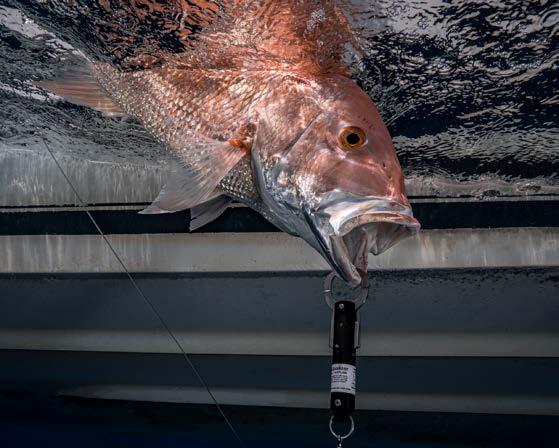
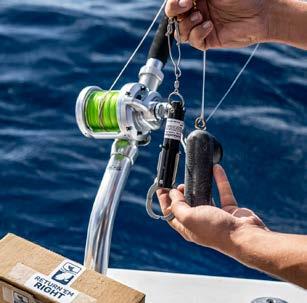
Do you love offshore fishing in the Gulf of Mexico? Learn to improve survival of released reef fish through our 15-minute training and receive $100 worth of fish release gear for FREE. GET FREE GEAR. BE A RESPONSIBLE ANGLER. HELP REEF FISH SURVIVE RELEASE. Join the community at ReturnEmR ight.org. 877.314.1237 // GreatDaysOutdoors.com // May 2024 27

28 May 2024 // GreatDaysOutdoors.com // 877.314.1237

Fish Cleaning Table Troubleshooting Before You Buy
BY TANNER DEAS
Before purchasing a fish cleaning table, it’s important to consider several factors to ensure that it meets your needs and works effectively. Have you ever owned a fish cleaning station before that just wasn’t up to par? Not durable enough, not easy to clean, or maybe you’ve owned one that you loved at first, but it just didn’t stand the test of time. How about coming home from a long day of fishing and simply dreading going through the process of cleaning the day’s fish; has this ever been you?
Or maybe coming home ready to clean the fish, fired up about the day’s catch, but it’s simply too dark to see out there anymore without getting out the shop lights and three or four extension cords to make it happen? Picture this. You’re coming home from a nice morning of fishing, whacking on them with the boys, ready to get your filets ready before a shower so you can go be with the family and boom, and the next thing ya know it’s beaming down 102 degrees, so hot it takes the breath out of ya.
If you’ve ever found yourself in any of these scenarios, or maybe you’re just a first time buyer; here are some troubleshooting considerations and tips to keep in mind before purchasing your fish cleaning station.
FISH CLEANING TABLE FACTORS TO CONSIDER
When it’s time to spend money on a fish cleaning table, you want to make the best decision possible with your money. Let’s discuss each of these factors and highlight a little bit of why they may or may not be a dealbreaker for certain brands or designs when making your decision.
Quality of material
If the fish cleaning table you’re interested in isn’t composed of quality material then it will have a short lifespan. There’s no doubt about it, you get what you pay for, and purchasing a fish cleaning station that’s made of cheap materials will lead to purchasing another one down the
road, most likely much sooner than you think.
Size
The fish cleaning table’s size is another thing to consider. Inadequate size of the fish cleaning station leads to a crowded workstation, making the fish cleaning process harder and last longer than it needs to be. Not only do you want to prevent an overcrowded cleaning area, you also want to be able to process larger species of fish like Tuna, Swordfish, Red Snapper, etc. A small table will not allow a certain caliber of fish to be cleaned easily.
Stability
The next thing is the table’s stability. Cutting fish on an unstable table is not only extremely dangerous, but also far less effective than doing it on a nice, hard, and stable surface that’s not wobbling around with every move of the fishmonger’s cuts.
Durability
Related to table stability is fish cleaning table durability. A durable surface allows for solid, clean cuts every time it is used. Not only does it offer proper cuts, a durable, robust construction and strength of surface and frame means that the fish cleaning station will last a long time, weathering many storms and many cleaning sessions.
FISH CLEANING TABLE MAINTENANCE
Maintenance and cleaning are the next things to consider. Clean tables equal clean hygiene. When it comes to a food surface, said surface should always be cleaned and maintained before, during, and after the fish cleaning process. If a table is properly designed, maintaining your fish cleaning station against bacteria and gross leftovers is much easier.
Design
Which brings us to our next factor, fish cleaning table design. Table design takes into account many small factors that can really make or break the quality of your
LIFESTYLE 877.314.1237 // GreatDaysOutdoors.com // May 2024 29
fish cleaning station.
To start are accessories and attachments. A fish cleaning station with proper accessories like leg drains, water hose attachments, and built-in cutting boards aids towards maintaining a truly clean fish cleaning table without unnecessary hassle. Not only that but cup holders, sink accessories, and knife sharpeners can also be game changers when considering having everything you need at your fingertips right in front of you on the same fish cleaning station.
The next thing that goes into fish cleaning table design is table height and ergonomics. No one wants to come home from a day of fishing and start working on the filets just for the table to be too low, causing them to excessively bend over, which leads to back pain. If your fish cleaning station is set to the proper height and designed specifically for you and your needs, it will be an absolute game changer and make using your fish cleaning station much more enjoyable.
Last but not least is reviews and ratings. Before purchasing your fish cleaning station, do a deep dive and research multiple brands in order to determine which brand and design may be best suited for you and your needs as well as the designs that will be worth your money. Someone else’s story and experience may have cost them money and a negative experience that you don’t have to go through yourself and on the other hand, someone’s positive experience with a certain brand or design may lead you in the direction you need to go in order to find what you need.
Each one of these factors goes into the happiness of the customer’s purchase as well as the quality of the customer’s use of the fish cleaning station. There are plenty of brands out there on the market today. However, Killerdock seems
to be the company that has set themselves apart from everyone else. Keeping up with the latest technology and constantly coming up with new accessories or designs, Killerdock manufactures some of the best, USA made fish cleaning tables available, while offering unbeatable customer service to match.
Material and
Durability
Strength and durability are at the top of the list that sets Killerdock apart from other fish cleaning table manufacturers. A Killerdock fish cleaning table should be the last fish cleaning station you have to purchase and if properly maintained, Killerdock’s “Upscale” and “Slam” series fishing tables are built to last a lifetime.
Killerdock fish cleaning tables are made of marine grade aluminum (5000 series aluminum) and protected with a resin based anti-corrosion clear coat that covers the entire unit in order to combat the saltwater and salt air of saltwater fishing environments and would function extremely well in freshwater environments too. A King Starboard cutting board is applied to the top of the fish cleaning station and offers an optimal cutting surface for cleaning fish.
Ease of Cleaning
Killerdock’s sleek seaward design makes for easy cleaning after getting the table bloody and fishy with the most recent harvest. A patented water intake system and patented leg table draining system makes for the perfect “spray and drain” scenario, toss a little bit of scrubbing and soap on the table, give her a quick rinse and Killerdock’s resin based clear coat will make cleaning as easy as one, two three. Also, the solid surface of this fish cleaning station doesn’t allow for any chunks of meat or fish scales and slime to get stuck inside the slots on the table, and no chunks of fish or blood will fall on you and your feet
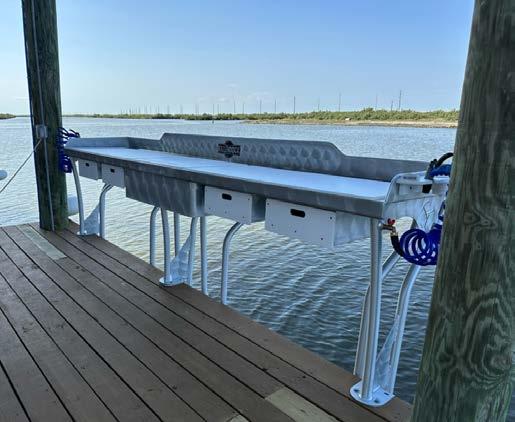
Fish Cleaning Table Troubleshooting Before You Buy
30 May 2024 // GreatDaysOutdoors.com // 877.314.1237
A durable surface allows for solid, clean cuts every time it is used
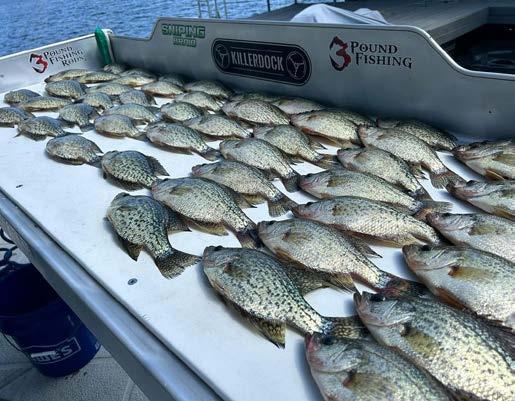
while cleaning fish. Another pro of the solid surface is that no filets will be lost to the cracks in the tables; falling to the water or onto the dirty ground.
Additional Features to Consider
There are several features that come installed on every station. A cup holder, knife holder, and knife sharpener can be found on each side of the table. Additional features include a fish cleaning sink, drawers, and umbrella holders. The fish cleaning sink is perfect for a quick washing of the hands when cleaning fish, and can also serve as a clean area to put processed filets or drinks on ice until you go inside. Fish cleaning sinks are adaptable with the Killerdock tables and can be added on even after purchasing one of their fish cleaning tables without one at first.
Drawers being added to the station makes the perfect space for extra storage for any tools related to fishmongering, or even extra lines for someone who needs to dock up. Umbrella holders can be a great addition on the “Upscale” table as it doesn’t come with the canopy like the “Slam” fish cleaning station does. These umbrella holders will hold an umbrella up to 9’ in diameter. The “Slam” fish cleaning station canopy can also be customized with your choice of canvas color. Not only does the “Slam” table have the canopy, but it also boasts a workstation light for those late night fish cleaning sessions. It’s also nice for relaxing on the dock at night when needing some light around.
INSTALLATION ON YOUR DOCK
Killerdock offers the biggest and strongest base plate for fish cleaning stations on the market. Even though the fish cleaning station is much stronger than others that are available, your station can only be as strong as the surface it is bolted to. With a good and proper foundation Killerdock can withstand winds upwards of 150 mph without flying off the dock.
REPLACEMENT PARTS AND WARRANTY
Killerdock’s excellent customer service, design and manufacturing quality guarantees that any fabrication aspects of the table (bends, welds etc) are covered for the duration of the table’s lifespan. There are several maintenance upkeep tips offered by Killerdock upon purchase and if followed, your warranty will never be voided and your fish cleaning station should last forever. If required, new hose coils and nozzles are offered by Killerdock but they aim to build these things to truly last forever. The only part they should need to be replaced after years of abuse is the cutting board surface. Over time, many fish are cleaned; knicks, cuts and scratches take their toll and the King Starboard Cutting Surface will need to be exchanged for a new one. Contact Killerdock for a simple correspondence and they’ll get it handled.
CONCLUSION
In conclusion, Killerdock seemingly has THE nicest fish cleaning station market and checks off everything you’d be wary of and everything you’d be looking for in a fish cleaning table. With their willingness to work with any budget and customer, Killerdock is able to create any table size needed from 3.5-12’. The sleek and professional design of their tables are patented and more stylish than other fish cleaning stations on the market. Keeping up with technology, adding accessories for the table and manufacturing such a quality fish cleaning station has been what Killerdock is all about. From strength and durability to quality materials and manufacturing to patented designs and added accessories, once you’ve purchased a Killerdock you’ve purchased the fish cleaning station to last a lifetime. Whether saltwater or freshwater, if you’re an avid fisherman Killerdock has the ability to provide you one of the most useful tools around. If in the market for a fish cleaning station then look no further, Killerdock and their amazing employees have got you covered with everything you may want and need.
Fish Cleaning Table Troubleshooting Before You Buy
877.314.1237 // GreatDaysOutdoors.com // May 2024 31
Height and ergonomic factors are things you should consider when choosing fish cleaning tables.
Best Tractor for Small Farm Needs
BY JOE BAYA
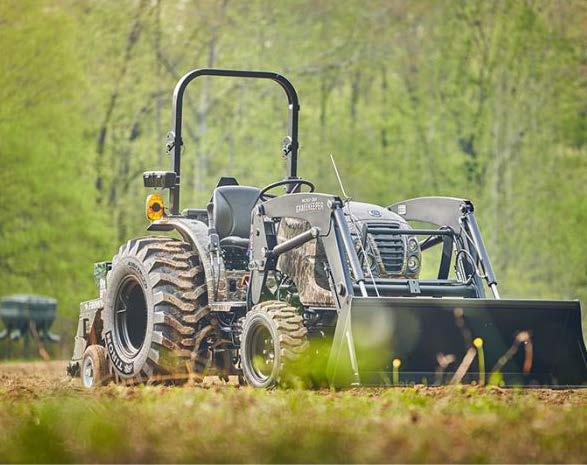
32 May 2024 // GreatDaysOutdoors.com // 877.314.1237
On my farm, on the journey to cross one thing off the to-do list, I often add two more. I quite commonly overestimate what I am going to be able to accomplish in a given period. For that reason, just about any tool that regularly saves me time will pay for itself over the life of ownership. A tractor is no different. Around my small farm, there are some jobs that I just couldn’t complete without it. Other jobs could be, but not without a significant dose of my blood and sweat complemented with teaching my young sons some words I don’t want them to know yet. The bottom line is you need a tractor, but getting the best tractor for small farm needs means you’re going to need to see around some corners.
SIZING THE BEST SMALL FARM TRACTOR
Small is a relative term so while I consider my 200+/- acre farm small, you might not. To get us heading in the right direction on size for small farms you are going to be looking into sub-compact or compact tractors. Utility tractors are most likely going to be overkill for your needs. You can confuse yourself trying to decipher the perfect size tractor so here is a simple framework to help you determine what you need. You need to first figure out what types of work you are going to do, then find a tractor whose specifications solve that problem. The best tractor will handle everything you throw at it, and if it doesn’t, you’ll find yourself back at the dealership before you know it.
SMALL FARM TRACTOR SPECIFICATIONS TO CONSIDER
I have a fairly analytical type of mind. When I pack for a trip I start with my socks and work my way up till I get to my hat. I like to look at a tractor the same way. Let’s start with the front-end loader and work our way to the 3-point hitch to determine what you might need.
FRONT-END LOADER CONSIDERATIONS
At my farm, we have an off-grid setup. Right now, that means hauling water from town in a 275-gallon IBC tote. A full load weighs 2,200 lbs plus the weight of the tote. Add to this that the manufacturer’s specifications for front-end loader lift capacity are measured “at the pins” so this means that the further something sticks out from that point, the more your lift capacity is diminished. When we want to move that tote off the trailer and into it’s resting position, it’s more than my current tractor can handle. This means having to offload water into a second container which takes this job from a 10-minute job to a 45-minute job. Add that up and over the years a tractor with a higher lift capacity can save me a ton of time.
While most of my needs on the farm could be solved with something like the LS MT122 Sub-Compact Tractor, The lift capacity on that tractor is 1,007 lbs. For my needs, something like the LS MT357 Compact Tractor with a lift capacity of 2,680 pounds would be better. Your mileage may vary, but when you are thinking about your farm, ask yourself what the heaviest load is that you will need to pick up, both now and into the future.
In addition to the lift capacity, it is vitally important to assess if you will need hydraulically operated front-end loader attachments. You can certainly add a third function to a front-end loader, but you might want to go ahead and have that equipped from the factory if you know you will want to operate something like a grapple. And why wouldn’t you? Tractor grapples are awesome.
SMALL FARM TRACTOR ENGINE EVALUATIONS
Moving back from the front-end loader we arrive at the engine and transmission. One thing that has always confused me is tractor horsepower. I’ve always heard people talking about “powerful tractors” with horsepower ratings that wouldn’t push a car fast enough to get a state trooper excited. So What gives? Tractors may lose 30% of their engine horsepower at the power take-off, so you must ensure that the 3-point implements you intend to run do not require more horsepower than the tractor has at the PTO.
Have a look at the spec sheets for the aforementioned LS MT357 and LS MT 125. As you can see, they do an excellent job of spelling out the power loss at the PTO. Make sure your tractor will get the work you want done in a reasonable time frame by making sure you’ve got enough power at the PTO. Remember, despite the

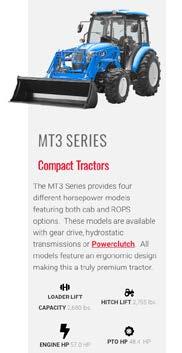
HUNTING 877.314.1237 // GreatDaysOutdoors.com // May 2024 33
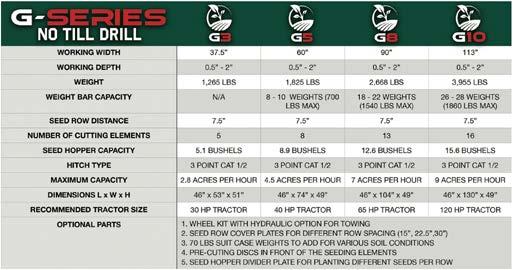
therapy that a day of tractor work provides, the time savings in getting your jobs done is what makes purchasing a tractor make sense.
WHAT’S THE BEST SMALL FARM TRACTOR TRANSMISSION?
All that power does you no good if it isn’t mated to a transmission that delivers it in a way that you are comfortable with. I didn’t grow up on tractors, so a hydrostatic transmission was user-friendly for me to get started with my work on day one. I can’t see a reason why I’d ever want to switch but the work you need to do is likely different than mine. Most sub-compact tractors come with a hydrostatic transmission, but if you want options like a gear drive or Powerclutch you may need to step up to a compact tractor.
WHO DOESN’T WANT 4WD?
Every vehicle I own is four-wheel drive, so I’m a bit biased. That being said, you don’t know you’re about to get stuck until you’re already stuck. I’d rather have 4WD and not need it than not have it at all. And I can’t say for sure, but it seems the market feels the same. In fact, every tractor that LS makes has 4WD.
SMALL FARM TRACTOR CABS
I recently hired out some destumping work on my property to an excavator and bulldozer team. Early on in the job, the operator sent me a video of a swarm of yellow jackets attacking his excavator cab with an intensity that left me pretty frightened. It’s moments like these when I start to think about upgrading to a tractor with a cab. Maybe it’s the extreme cold in the North or heat in the South, or maybe it’s just keeping the elements “out there”, but either way, if you need a cab you’re likely going to need to step up to a compact tractor.
WHAT’S THE BEST 3-POINT LIFT FOR A SMALL FARM TRACTOR?
Just like with the front-end loader example, a tractor that can’t lift all of the 3 point implements you want to own is likely going to put you back at the dealership. So on the quest to find the best
tractor for your small farm, research what the implements weigh that you might want to run. Say your goal is implementing no-till planting practices on your farm. If this is the case, you are going to want to purchase a no-till drill. Looking at the capacities in the PH Outdoors G-Series no-till drills below, you can see that as the width of the drill increases, the weight increases, and the acres planted per hour increase.
Another area to consider in your 3-point lift is what you want to do with the implements. Do you have a lot of roads or a long driveway to want to create or maintain? You’re first day of attempting to adjust the top and tilt on your box blade might have you begging for rear remotes. This functionality gives you the ability to run hydraulically operated 3 point implements like a hydraulic top and tilt kit. Again, it all adds up to time savings.
OTHER POINTS TO CONSIDER IN A SMALL FARM TRACTOR
You are going to break your tractor. You are going to need to maintain your tractor. The final things to consider are the tractor’s overall weight and whether or not there is a dealership fairly close to you. Because my tractor exceeds a safe towing and payload capacity on my truck, I’ve often needed to have my local dealer come out to my property and haul my tractor in for repairs and maintenance. While this is a necessity for me until I upgrade my tow vehicle, it’s also really convenient when needed. When considering your next tractor, make sure to take a look at the service locations and make sure you’ve got enough truck to haul it around.
Tractors are awesome. They are useful, fun, and I think they make you cool. Heck, you can even make a statement and show your support for wildlife conservation by buying one wrapped in Mossy Oak Camo. They are also not a toy. They should be operated with the utmost care and an eye on safety. By thinking about the work you want to do, and making sure you get a tractor built to that standard as well as with all of today’s modern safety equipment, you can ensure that your days spent tractoring end with a sense of accomplishment and not frustration.
Best Tractor for Small Farm Needs
34 May 2024 // GreatDaysOutdoors.com // 877.314.1237
Raw Land Loan Rates 2024
BY JOE BAYA

Investing in raw land can be an exciting opportunity for those looking to build their dream home, start a farming venture, or develop a hunting property, amongst other things. Purchasing raw land often requires a substantial financial commitment, and many individuals may need to secure a raw land loan to make their vision a reality. In this article, we will explore the world of raw land loans and discuss the current raw land loan rates in 2024. We will also provide tips for choosing the best loan option, and outline the process of obtaining a loan for raw land.
RAW LAND LOAN RATES
Since its founding over 100 years ago, First South Farm Credit (FSFC) has been financing all types of rural land. FSFC now has grown to over 40 branches with 9,000 members in Alabama, Louisiana, and Mississippi. First South Farm Credit basically lends money to people for pretty much anything that they want to do “in the dirt”. That could be row cropping, raising livestock, growing timber, farming for wildlife, or raw land. We catch up with them frequently on the Huntin’ Land Podcast to learn about all aspects of land financing as well as keep an eye on the current raw land loan rates.
As of the time of this writing, raw land rates are in the high 7% to 8% range depending on the financial position of the borrower and the terms of the loan. When you borrow money from FSFC, you become a member and that means you own part of the business. That ownership entitles you to share in the profits through their Patronage Refund Payment Program. In other words, First South Farm Credit gives its members money back. While it can’t guarantee payments back to you or the exact rate of return, as long as it remains profitable and well-capitalized, FSFC is committed to sharing its profits and has made patronage payments for the past 23 consecutive years.
RAW LAND LOAN OPTIONS
Raw land loans, by definition, are land loans for tracts that are unimproved, meaning, in general, there are no sewers, roads, electricity, etc. While many lenders will not have anything to do with raw land loans, lenders who are affiliates of the National Farm Credit System, such as First South Farm Credit, are well-versed in providing financing for these types of properties.
The National Farm Credit System is a network of borrower-owned lending institutions, and First South Farm Credit specializes in providing credit for farming operations that include crops, livestock, land, and timber. FSFC is also chartered to help with financing lifestyle farms, rural home sites, or rural land tracts for enjoyment or investment purposes.
“First South can make loans for anything a landowner wants to do to develop his property or its habitat or the amount of wildlife there. If you’re playing in the dirt, we
want to be in there with you, as long as you’re improving the value of the dirt, which is the collateral of the loan,” says Taylor Hart, the branch manager of First South Farm Credit in Opelika, AL.
“First South Farm Credit can make construction loans and, if needed, can turn those loans into long-term loans. Some landowners are building secondary homes, hunting cabins or lodges, and others want to put their primary residences on 20 to 30 acres. Perhaps that person wants to sit on his or her back porch and look at a pond and we make loans for pond construction as well,” Hart said.
HOW TO GET A LOAN FOR LAND
While you may have heard that getting a land loan is more arduous than other loan applications, the fact is that when working with the right institution it is not much different than how you may have gotten other loans such as those for your primary residence. Down payments are typically in the 20% range and there are even options for buyers who want to buy land with no money down. Be prepared to share the following with your lender:
1. Current Financial Statement Information
2. Balance Sheets for Entities you own or are a major shareholder of
3. Complete tax returns or another form of Income verification such as recent paystubs
4. Balances of Investment and Liquid Asset Accounts
THE IMPORTANCE OF LAND PRE-APPROVAL
In my time as a land real estate agent, I have seen the heartbreak from willing buyers when they miss out on their dream property. The most common reason I see buyers miss opportunities is because they do not have their financing in order. When a landowner is ready to sell their property, they want to go under contract with a buyer who is almost 100% guaranteed to close. When you come to the offering table and are in competition with another buyer who has fewer contingencies (or none at all) the landowner is more likely to go with the sure bet, even if that buyer’s purchase offer is slightly lower than the other with all of the contingencies.
Today’s land market is more competitive than ever. Drone Tours, interactive mapping, and stunning online photography mean that shoppers are more prepared than ever to make an offer as soon as they confirm a property is what it looked like online. Don’t let a simple bit of paperwork be the reason you miss out on your dream. If you are considering buying raw land, do yourself a favor and reach out to your local National Farm Credit Affiliate like First South Farm Credit, and get approved before you are ready to make an offer. In addition to financing land, FSFC can finance your land improvements, new and used tractors, and other equipment that is used to maintain and enhance your rural property.
877.314.1237 // GreatDaysOutdoors.com // May 2024 35
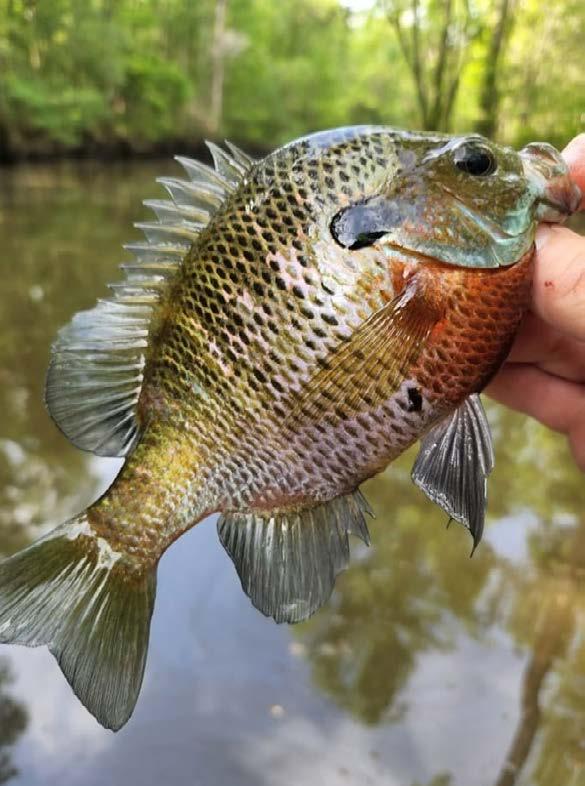
36 May 2024 // GreatDaysOutdoors.com // 877.314.1237
Catching Big Bluegill Using Sidescan Sonar
BY NICK WILLIAMS
Wanna know a secret in the world of outdoor media? Covers sell magazines. Specifically, pictures of monster bucks, huge fish, and sweeping, scenic vistas.
“Big secret,” you’re thinking to yourself. But for real, do you wanna know a secret?
People. Love. Pictures. Of. Big. Bluegill.
It gives me hope for the world that a picture of a colored up, “bull” bluegill sells magazine copies just as well and often better than pictures of a trophy buck or slob bass. It proves that at least some outdoorsmen still have an appreciation for the little, childish joys in life. Therefore, it is with extreme pleasure that I present to you an article on how to catch more and bigger bluegill this month.
UNDERSTANDING BLUEGILL SPAWN
Bluegill (Lepomis macrochirus) typically begin spawning when the water temperature approaches 70-75 degrees. When it’s time to spawn, male bluegills start to get busy creating beds, which are circular depressions in the lake or riverbed. They usually choose shallow areas with sandy or gravelly bottoms for these nests. The males use their tails to sweep and clear out debris, creating a clean and protected area for the female to lay her eggs.
After the nests are made, the males defend them aggressively and try to attract females by swimming around the nest and displaying their bright breeding colors. The females, when ready, will choose a male and nest, then lay thousands of tiny eggs in the chosen nest. The number of eggs can vary greatly, often ranging from a few thousand to over 50,000, depending on the size and age of the female.
Once the eggs are laid, the male bluegill takes over, fertilizing the eggs and then guarding the nest against predators and other threats. These large, mature males become easy targets for anglers. Bedded bluegill are tightly clustered, and extremely aggressive. If you’ve ever had the chance to observe them in shallow, clear water, then you know that they are constantly fanning their eggs, chasing off smaller bluegill who try to eat their eggs, nipping at other males who venture too close, and just generally acting peevish.
In southern Alabama where I live, I’ve observed spawning activity as early as March and as late in the year as October. Basically, as long as there is a healthy bluegill population, suitable spawning grounds, and a stable water temperature between about 70 and 75 degrees, bluegill will spawn. But May is generally regarded as “peak spawn.” Specifically, many old-timers insist that the best fishing is to be had on the day of, or immediately before and after the full moon in May. This year, for the curious, that moon will fall on May 23rd. Go ahead and mark your calendar!
WHERE TO CATCH BIG BLUEGILL
Traditionally, I’ve located my bluegill beds with polarized lenses or my nose.
Nothing beats the first sight of moon craters and fleeing fish as you drift over shallow, sandy-bottomed backwaters off of the main river channel or lake bed. Occasionally, you can catch a subtle but distinct whiff of a fishy smell in deeper or more opaque waters, revealing the presence of spawning bream on the bottom.
While bluegill typically spawn shallow, “shallow” can be relative. I’ve seen bluegill spawn in water barely a foot deep in ponds and small creeks, and I’ve caught them in eight feet of water on larger rivers. But last year, a buddy of mine sent me photo after photo of big, “bull” bluegill that he caught spawning in twenty feet of water on a lake in Texas.
Deep water spawning has its perks for bluegill. For starters, deeper water protects fish from predators. Birds like Ospreys, herons, and cormorants can’t prey upon bluegill in deeper waters, but deep water also does a great job protecting bluegill from angling pressure. Deep water is also more temperature stable, which means that late frosts or heat waves are unlikely to interfere with egg development. I have witnessed many shallow water bedding grounds spring up overnight, and then immediately die due to that infernal pre-Easter cold snap.
Fish are firm believers in the idea that, “might makes right.” Big fish assert their right to the best of everything. Big catfish live in the best holes in the riverbank. Big trout hog the best pocket of stillwater in a stream. Big bluegill hog these deep water spawning grounds, leaving the easily located and fished shallow beds to smaller specimens. Oftentimes, if you can find these deeper beds, you can have lots of big bluegill all to yourself.
LOCATING BIG BLUEGILL BEDS ON SIDE SCAN SONAR
To do that, you’ll have to rely on side scan sonar technology. If you’ve never bluegill fished with the aid of side imaging, you’re missing out! The first time I ever glanced over at a buddy’s display while we were cruising past a bedding flat, I knew immediately what I was looking at. There’s often some skill and art in translating a sonar graph into a mental image of what’s happening under the water, but a properly calibrated side imaging unit is very intuitive to understand. Craters show up cleanly and clearly, and occasionally you can even make out bigger bluegill hovering a few inches over individual beds.
In order to learn more about how to dial in your side scan unit and use it to locate deep water spawning grounds, we sat down on an episode of the Alabama Freshwater Fishing Report to interview Steve “The Graz’’ Graziano. Graz is a well-known big-bass angler on Lake Eufala who has learned that big bass often relate to bluegill spawning grounds. He rarely fishes for bluegill, but he makes it his business to keep tabs on as many deep water spawning grounds as he can so that he can consistently put his clients on bass that are feeding on spawning bluegill.
“Sidescan shoots a signal out to the side of the boat,” Graz explains. “It shows you a lot of ground, and you don’t have to drive right over something to see it
FISHING 877.314.1237 // GreatDaysOutdoors.com // May 2024 37
As you can see, sidescan (or in this case, Hummingbirds 360 sonar) clearly shows the characteristic “moon crater” bluegill beds on this flat.
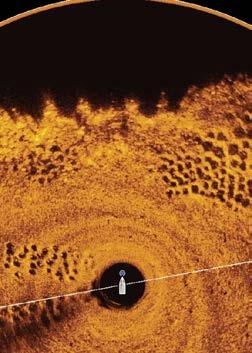
like on downscan. When I’m scanning, I set my unit to show me 100 feet out to one side of the boat. A lot of people will set it to scan both sides, but you only have so much display screen, and by focusing on just one side you can see more detail on the display. Plus, if you’re cruising parallel to the river or lake bank, you’re really not interested in what’s happening in the middle of the river. You’re much more interested in looking towards the bank.”
the money spent on turkey permits, which is part of the licensing requirement to hunt turkeys in Florida, goes into that fund.
“Many hunters and NWTF members are heavily involved in raising funds for the wild turkey and its habitat by participating in NWTF hunting heritage banquets, whereby a portion of those funds raised goes into the cost-share program,” Nicholson said. “Hunters’ purchases of hunting equipment also helps support wildlife conservation through the Wildlife and Sport Fish Restoration Program, which brings federal grant funding to state wildlife management agencies such as the FWC.”
He continues, “All of the sonar companies, Garmin, Lowrance, Humminbird…they make good side scan units. I’m personally partial to Humminbird because they’re a local company, but also because of their 360 technology. They’re the only ones who have it, and I’m addicted to it. When I’m anchored up, it lets me see 360 degrees around my boat. It’s a big advantage. I haven’t really got on board with forward facing sonar, because I’ve just gotten so used to sidescan and 360.”
So where do you find deep water bluegill beds?
Through this combined effort from the NWTF, FWC, FFS and Florida turkey hunters, the wild turkey population is healthy and flourishing in Florida. And, if you’re a turkey hunter, then you must be getting excited because spring turkey season and the youth turkey hunt weekends are just around the corner.
“There’s really no one magic place,” Graz says. “A lot of the time, if you know where shallow beds are, you can look around nearby. If there’s a good substrate on the bottom you’ll also find clusters of beds deeper. Sometimes if you have a flat, there’ll be a ditch that runs through it and there’ll be beds in that ditch. You’ll find them on lake points going out into deeper water too, if the bottom is right.”
Contact Information
Wild Turkey Cost-Share Program
Florida State Chapter of the National Wild Turkey Federation (NWTF)
One of the neat things about modern side scan units is that they offer tremendous resolution and image clarity. Graz says you can go beyond locating beds and identify old vs new beds, identify bigger beds, and even target specific fish on specific beds.
Florida Fish and Wildlife Conservation Commission (FWC)
Florida Forest Service (FFS)
Green Swamp Wildlife Management Area (WMA)
Gulf Coastal Plain Ecosystem Partnership
Wildlife and Sport Fish Restoration Program
“It’s hard to describe, but new beds really ‘pop,’” he says. “The older ones get kind of smeared. And what I”ve found is that you can’t depend on them bedding in the same place year after year. You can see old beds for a season
 Catching Big Bluegill Using Sidescan Sonar
Catching Big Bluegill Using Sidescan Sonar
Managing Wild Turkeys Through Teamwork 42 APRIL 2020 // GreatDaysOutdoors.com // 877.314.1237
38 May 2024 // GreatDaysOutdoors.com // 877.314.1237
or two after they were created, especially if they’re in a place where there’s not a lot of flow to wash them away. Sometimes, you see fresh beds mixed in with them, but sometimes for whatever reason they don’t choose to bed there this year. It really just depends.”
He continues, “You can also occasionally see fish on the bed. Sometimes it’ll be a big bluegill, but sometimes it’ll be a big bass laid up in a bluegill bed!”
While most of the time anglers think of bluegill bedding grounds as being an area of the bottom that is pockmarked with clusters of tightly-packed beds, Graz says that sometimes bluegill spread out. Side scan lets you identify loosely strung out beds, and fish those beds one-at-a-time. Such isolated beds often hold bigger bluegill than the ones you’ll find crammed together.
HOW TO CATCH BIG BLUEGILL
Using Graz’s insight, you should be able to easily capitalize on your local bluegill spawn if you have sidescan. It’s worth taking a trip without the poles in the boat to just ride around and mark good looking bedding areas on your sonar unit. Once you have a list of places that you know you can go back to and find bluegill, grab the ultralight rods, toss some ice in the coolers, and call a buddy. One who has a few kids, ideally, because your next trip has the potential to create some first-class memories for young anglers.
When I go fishing for bluegill, I prefer a 7 ft, ultralight, fast-action, spinning rod paired up with a small, 1000-size spinning reel. I’m partial to the Daiwa Fuegos, because they have a really smooth drag and are light enough to balance well on ultralight rods.
Most bluegill fishing is done relatively shallow, either with live bait suspended under bobbers, or with small artificials such as beetle spins, underspins, micro crankbaits, or small soft plastics. But if you’re targeting bluegill that are bedded in eight to twenty feet of water, that requires a slightly different approach.
I like to tie a small (1/32-1/16 oz) jig head directly to 6 or 8 lb braid with a simple clinch knot, and send a red worm, cricket or soft-plastic straight down to the bottom. This is a sensitive and super-simple rig that is deadly effective once you find a bed. Bait anglers can use the standard size 8-12 aberdeen hook with a split shot rig, but jig heads offer better sensitivity and hookups. It’s harder for a bluegill to swallow the lead head on a jig, and typically the fish I catch on one are hooked in the top of the mouth and easily released without having to break out the forceps.
Bait up, cast out, and let the jig head settle to the bottom. I like to let it set for a few seconds with the bail open but the line pulled somewhat taut between my fingers. Usually, you’ll feel a “tap…tap…tug” if you did a good job marking a bed, anchoring on it, and casting. If nothing hits, I will slowly drag the bait across the bottom, hoping to drag it into an irritable “bull” bluegill’s nest. If you get hung, pull loose and tie on another jighead. A clinch knot on braid holds fast enough to hoist in bluegill, but will generally pull loose if it’s snagged.
If you switch over to shallower beds in 2-6 ft of water, it’s simple enough to add a bobber. Clip-ons are convenient and fine for these depths, and I typically set mine just a foot or two off the bottom when fishing beds.
For fly anglers, a 2 to 4 wt rod can provide a lot of fun if the fish are shallow. Bluegill can be reluctant to come off of bed to hit topwaters, but almost anything that you can drag along the bottom or slowly strip past their nose will get hit.
CONCLUSION
However you fish for them, spawning bluegill are one of springtime’s greatest treats. In addition to being excellent table fare and sporty fighters, spawning males are gorgeous fish. So grab a couple of kids or an old-timer, dust off the cricket cage, and go hunt up some big, deep water bluegill this full moon!

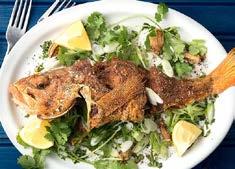
Hmong Style Crispy Fish
Prep: 20 mins • Cook: 20 mins • Total: 40 mins
Ingredients
FISH
• 2 to 4 plate-sized bluegill, scaled and gutted
• Salt
• 1 cup peanut or other vegetable oil
• 3 to 5 garlic cloves, smashed
• Freshly ground black pepper
• 1 or 2 lemons, cut into wedges
• 4 green onions, sliced on the diagonal
• Cilantro, torn into 1-inch pieces, for garnish
DIPPING SAUCE
• 3 to 5 small hot chiles such as Thai, or 1 habanero
• 1 tablespoon minced lemongrass, white part only
• 3 tablespoons minced cilantro
• 3 tablespoons minced green onion or chives
• Juice of a lemon
• Grated zest of a lemon
• A pinch of salt
• 1 teaspoon sugar
• 2 tablespoons fish sauce
Instructions
1. Take the fish out of the fridge and rinse it under cold water, checking for any remaining scales. Remove the gills if they are still there. You can snip off the fins with kitchen shears if you want. Use a sharp kitchen knife to slash the sides of the fish perpendicular to the backbone. Make the slices at an angle, from the tail end toward the head end. This opens up the fish to the hot oil and makes it cook faster. Salt the fish well and set aside.
2. Make the dipping sauce by combining all the ingredients in a bowl. Make sure everything is chopped fine. Set aside.
3. A wok is the best thing to use for cooking these fish, unless you have a deep fryer. I have both, and still prefer the wok. A large frying pan will work, too. Heat the oil until it is between 330°F and 350°F. Fry the crushed garlic cloves until they are a lovely brown and remove.
4. Gently put one or two fish into the hot oil. It’s OK if the tails and heads are not submerged. It will sizzle violently, so watch yourself. Use a large spoon to baste the fish with the hot oil as it cooks. Fry like this a solid 6 to 10 minutes, depending on how thick the fish is. You want it very crispy and golden brown. Carefully flip the fish -- I use two spatulas to do this. Fry another 5 to 8 minutes. Repeat with any remaining fish. If you do have to do this in batches, let the cooked fish rest on a rack set over a baking sheet in a 200°F oven.
5. To serve, lay the fish down on plates and grind a healthy portion of black pepper over them. Black pepper is a signature flavor in this dish so be generous. Arrange the fried garlic and the remaining garnishes alongside. Serve with the dipping sauce and white rice.
Recipe by Hank Shaw, Photo by Holly A. Heyser • https://honest-food.net
Catching Big Bluegill Using Sidescan Sonar
877.314.1237 // GreatDaysOutdoors.com // May 2024 39
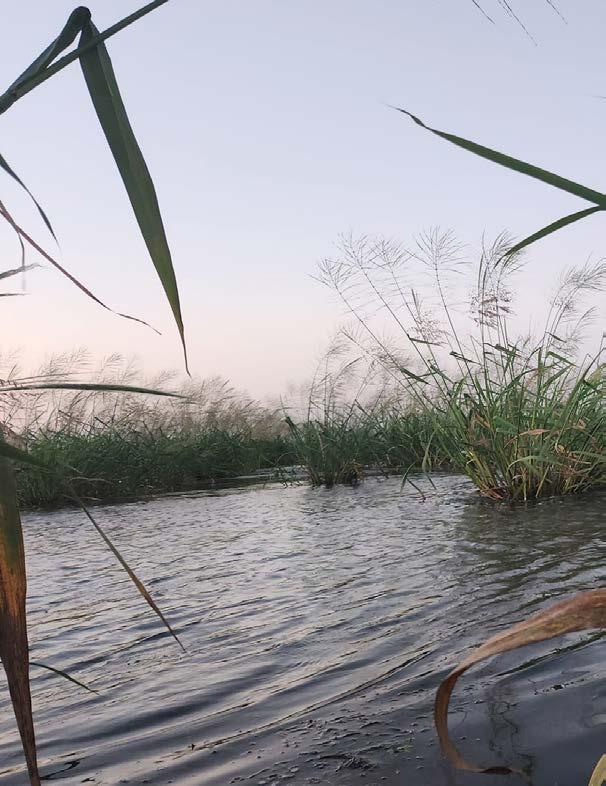
DOG STANDS for Duck Hunting
BY NICK WILLIAMS
I’ve had to learn some mental tricks to help me avoid buying every cool piece of gear that I come across. Usually, I can dissuade myself from a purchase by asking myself, ‘How many extra fish/ducks/deer/turkeys will this put in my freezer this year?’ Usually, the answer is, ‘Probably none.’
But every now and then you make a purchase that really does put game in your freezer. For me, the “most productive” money I’ve ever spent on duck hunting was on an eight-week-old Labrador Retriever named Amos Moses. Ole Amos wasn’t cheap, and I’m still paying for dog food and vet bills, but he has put a lot of cripples on my game strap that would have been lost if not for his keen nose, 4Lo capabilities, and extreme “can-do” attitude. I have hunted with a lot of good people, but Amos is at this point probably my favorite hunting companion. He never runs late, he never has to work that morning, he’s always in a good mood, and he never tries to claim he shot a duck that I obviously hit. If only he’d buy breakfast for once…
If you have a duck dog, or if you’re looking at getting a duck dog (and you should totally get a duck dog) then you need a platform stand for that duck dog. In this article, we’re going to explain why that’s so, discuss common shortcomings in stands, and look at some old favorites and exciting newcomers on the stand market. The goal is to put your buddy in stand that will be safe and comfortable for him, and easy to use for you.
WHY YOUR DOG NEEDS A DUCK HUNTING STAND
First off, you may not need a dog stand. I only put Amos on a stand once last year, and that was only because he was hunting with new faces on opening day. I brought the stand as “insurance” against an excited young dog, but it was completely unnecessary. The Mobile-Tensaw stayed very dry for most of the season, so Amos and I spent most of the season on dry ground, with him calmly sitting next to me.
If you hunt a lot of dry creek or beaver pond banks, a stand may just be extra weight. Likewise, if you spend 100% of your time hunting out of a boat or permanent stand, a blind probably isn’t necessary.
But most waterfowlers will benefit from a platform. Even if your dog is a big, burly, thick-haired brute like mine, they won’t enjoy and don’t deserve to sit with their butts in cold water or mud all morning. Prolonged soaking while remaining stationary isn’t just uncomfortable, on cold days it can be harmful to your #1 hunting bud. Unfortunately, dogs are short compared to people, and can’t wear waders. Water that you can comfortable sit or stand in with waders on is usually too deep for your buddy to be comfortable in. Sometimes you get lucky and can park a dog on a dry hummock of grass or a fallen tree, but it’s inconvenient at best to let terrain dictate where you can hunt. Most of the time, you have to let the birds dictate where you set up, and having a stand means that you can make a dry place for your dog to sit wherever you need to.
Comfort and safety aside, your dog will perform better from a platform. Getting up in the air, even just a little bit, can give your dog a better chance to see what’s going on. Being elevated is especially important if birds start hitting the water in fog, or in conditions where grass, lily pads, or other “junk” obscures the water. The better he can mark a fallen bird, the easier a time he’ll have with the retrieve.
Being on a stand, as mentioned, is also an obedience aid. A young or excitable dog is less likely to break the “place” command if he’s up off the ground. It’s also hard for them to “creep” out of position over the course of a hunt. If you’ve suffered through a hunt spoiled by your dog knocking over coffee, following you around as you set decoys, or deciding to move as birds worked, a platform may be worth its weight for you and your bud.
COMMON ISSUES WITH DUCK DOG PLATFORMS
Most dog stands, like most treestands, are awesome when they’re set up. But like treestands, transporting them to your hunting spot and getting them ready for business can be a major pain. Steel models are worthless. Aluminum is not just lighter, but also resistant to corrosion. You also want something that packs as small as possible. Decoys and companions take up enough room in small boats, and if you’re slogging in waders you’ll quickly lose your cool with designs that hang up on brush.
Some sort of folding design is usually necessary, but hinges and pins can introduce their own frustrations. Manual dexterity and mental clarity are usually not particularly high at 3am on a 20 degree day, so it’s important that the stand be as easy to use as possible. Any
40 May 2024 // GreatDaysOutdoors.com // 877.314.1237
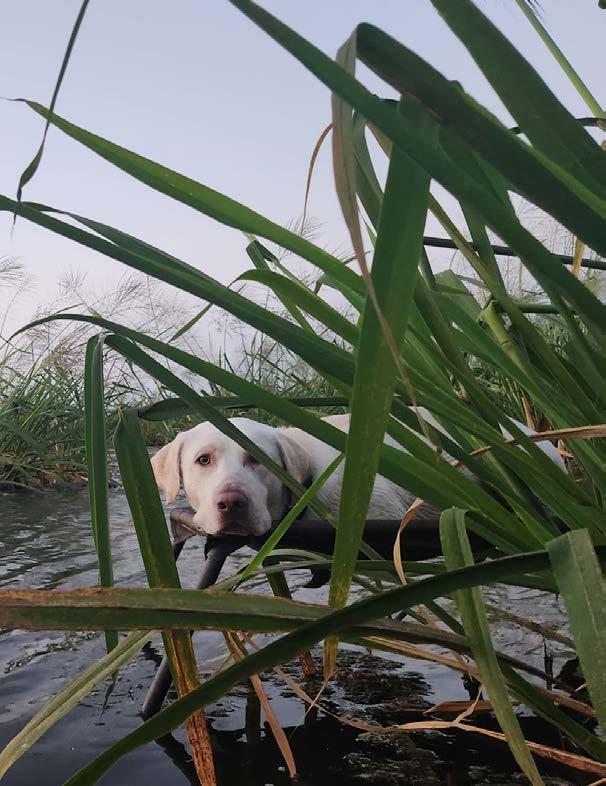
HUNTING 877.314.1237 // GreatDaysOutdoors.com // May 2024 41

design where it’s possible to lose the pins is worthless, obviously, but it’s also important that it be difficult to set the stand up in a manner where it doesn’t lock into place and can collapse once your dog goes to jump up on it. Finally, if the stand can’t easily be adjusted for uneven ground, it deserves to stay on the store shelves.
You also want a stand that can be used wherever you need to use it. Free standing platforms usually have a limit to both how low you can place them and how high. Most models get unstable with the legs fully extended, especially if you have a big dog perched on top of it. This is an issue if you hunt areas where you’re pushing the capabilities of your waders. If your stand doesn’t go low enough, it can also prevent you from being able to tuck your dog down into brush and grass, making it difficult to camouflage him. Tree mounted platforms can be awesome for timber hunters, but they’re useless in many marshes and flooded fields.
POPULAR DOG STANDS FOR DUCK HUNTING
If you hunt with a dog, a good stand is essential. I did a good bit of research when I bought Amos’ stand, which is one of the more popular models on the market. In this section, I’ll share what I like and what I dislike, and talk about why I’ll probably end up buying a second stand to complement it.
MO’MARSH DOG STANDS
When you start shopping for dog platforms, it’s impossible to miss the ones made by Mo’Marsh. Mo’Marsh actually makes four dog stands currently: the Final Stand, The Invisilab, Field House, and the Ramp Stand. I ended up buying their Final Stand for Amos. Their Field House blind is very short and designed for field hunting, which we don’t do. Their ramp stand is meant primarily to either be attached to a tree trunk or strapped to a boat. While we hunt a lot of timber, we also hunt some marsh and I wanted a “do-all” stand.
I almost purchased their Invisilab, and if I had it to do over again I’d go with that model for one simple reason. The Invisilab incorporates a blind onto a platform stand, and while you can modify the Invisilab to make the blind detachable, you cannot purchase and add that blind to the Final Stand. I didn’t initially think I’d want a blind, but after a couple of seasons, I’ve realized that when you need one, you really need it. Especially when your wife chose a white dog.
Other than that, the blind has worked well. Amos is a pretty lean eighty pounds, but the stand holds up well to his weight and is, if anything, a bit bigger than it really needs to be. All four legs can be independently adjusted, and the pull cable that releases the leg pins is easy to use and hasn’t given me any issue.
Dog Stands for Duck Hunting
42 May 2024 // GreatDaysOutdoors.com // 877.314.1237
While the stand is surprisingly light given its dimensions, it’s bulky to carry in if you’re walking. It comes with a shoulder strap, but I’ve found it unsatisfactory, and I’m yet to find a good way to get backpack straps on it. Even if I did, the stand is wide and tall enough that I imagine it would snag a lot walking through the woods.
Ultimately, while the stand works a charm once you’re at the honey hole, transportation is a bit of an issue, especially if you have a long walk without the benefit of a road. This describes most of our hunts, so Amos and I are still on the market for something a little easier to carry deep into the swamp.
RIXEY DOG STAND
This off-season, while shopping around for a better stand to carry into remote places, I came across a new design that caught my attention. To learn more about it, I picked up the phone and called Todd Ezzi, avid duck hunter and the owner of Rixey Dog Stands. Todd apparently had the same issue I’m currently having with stands, and decided to take matters into his own hands to solve it.
“I was in the middle of Bayou Meto,” he explained during our call, “in a walk-in area called Government Cypress, and I was about a mile back in there. I’ve always tried to walk and get away from people as much as I can when I’m hunting. It’s a little bit harder now with mud motors, but there’s still some places where you can make it happen. And I was back there carrying a traditional dog stand. It was just my dog and myself, and I was standing by the tree thinking, ‘There’s got to be a better way to build a dog stand that’s collapsible and easier to carry in.’ And so when we got back from hunting, I went out to the shop, and started welding and cutting, and I made my first prototype. I showed it to some friends, and they were all impressed with it. So then I showed it to some engineering buddies that helped me tweak it and redesign it a couple times until we got to the product that we
have now. So it was one of those inventions that sprang from necessity; the need to have something that was portable and easy to get in and out of the woods.”
What makes the Rixey stand so interesting is just how compact and lightweight it is.
“The stand ships in a 6x10x25 inch box,” Todd says. “So that tells you how compact it packs up. The current model weighs only eight pounds, and we’re experimenting with a lighter prototype that is only five pounds. The standard is already lighter than most stands on the market, but what really makes it stand out is its size. You can clip it to the outside of a backpack, or even put it inside a backpack or a decoy bag. There are a lot of really great dog stands already on the market, but there’s just not one that small, something that you can stick under the truck seat or in a boat box.”
All well and good, but as I mentioned, Amos is a pretty big dog. I asked Todd if he thought it’d hold up to big, bullish, male retrievers.
“We advertise a 120 lb weight limit,” he told me confidently. “It’s strong enough and has enough room to hunt a big Chesapeake or Labrador Retriever off of it, absolutely. We’ve tested it to 350 lbs, actually. And it sets up quickly too. It’s super user-friendly, you can set it up in about 15 seconds.”
CONCLUSION
While the Final Stand has been good to Amos and me, it’s hard to ignore the appeal of a stand that can fit in a backpack for those long-haul timber hunts. If you’re looking at picking up a dog stand this year, I’d encourage you to give either Mo’Marsh or Rixey a good look. It’s hard to imagine, but duck season is just a few months away, and you and your dog will both need time for training sessions to get used to a new piece of gear before season starts.
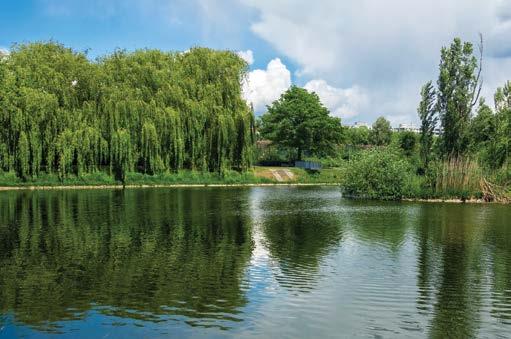


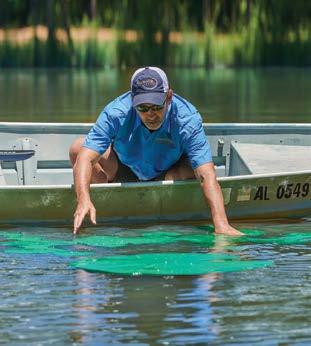

FISH HABITAT & ATTRACTANTS FOR PONDS & LAKES www.TexasHunter.com • 800.969.3337 Request a Brochure A full line of Fish Habitat & Attractants by Dog Stands for Duck Hunting
877.314.1237 // GreatDaysOutdoors.com // May 2024 43
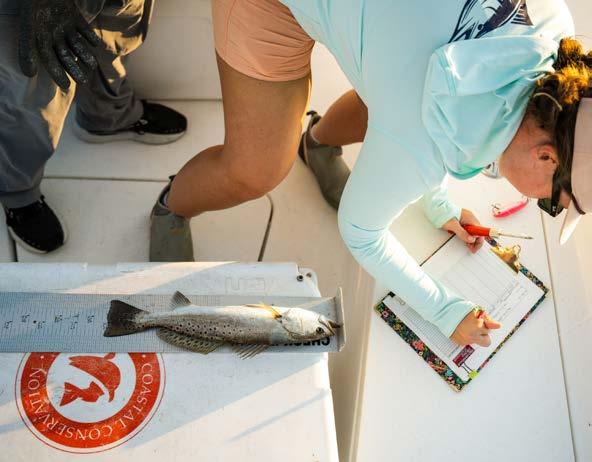
WHAT IS FISH TAGGING TEACHING US?
BY FRANK SARGEANT
Fish tagging is a powerful tool for coastal fishery management where ever it’s used, allowing fishery scientists and fishery managers to keep tabs on the growth, mobility and to some extent the mortality rate of various fish.
When anglers recapture a tagged fish and report the info, researchers can track the movement of the fish and also see how much it has grown from the time when it was tagged to get an idea of the general growth rate of that species of fish in that given estuary.
The rate of tag return also gives fishery managers some idea of fishing pressure and angler success—if all the fish that are tagged are re-caught, it’s likely fishing pressure is so high that management measures will be needed, while if only a few are re-caught, assuming good survival rates after tagging, it’s likely the fishery does not need restrictions.
Seasonal migrations can also be tracked—overall, tagging gives fishery managers some important tools in managing fish populations.
KEYS TO SUCCESSFUL TAGGING
The process of tagging and the tag itself shouldn’t influence the fish’s behavior or increase its chances of dying from handling or predators, of course. Also, the tag needs to stay put in the fish. Good tags and proper tagging methods avoid these issues for the most part, researchers tell us.
Captain Richard Rutland, a Mobile Bay guide who helped researchers get the current Alabama inshore tagging program funded by the Coastal Conservation Association of Alabama (CCA-Alabama) underway, says successful tagging depends on preparation and working quickly to tag and release each fish. (Rutland is consistently the top tagger in the program, it should be noted.)
44 May 2024 // GreatDaysOutdoors.com // 877.314.1237
“I’ve got two needles, one for reds, one for trout. I’ve already got the tags loaded in the needles before we start fishing. The tag numbers are already recorded so all I have to do is pop the fish with a tag, get a measurement on it, and then get it overboard. Then I record the length and the location. It just takes a few seconds on most fish.”
Without this rapid process, more of the tagged fish are likely to die, and this negates a part of the information the study could provide. Rutland notes that seatrout are particularly sensitive to handling, and must be tagged and released quickly.
TYPES OF FISH TAGS
Floy or anchor tags are the type used in most angler-tagging efforts. Small lengths of number-coded nylon tubing are “anchored” to the back of a fish with a T-like end, usually inserted near the dorsal fin. This tag is similar to the type of tag that attaches a price label to a piece of clothing. The advantages of anchor tags are that they can be seen outside the body of a fish, they’re relatively inexpensive, and require only moderate instruction for successful insertion. The tags include a phone number or email address to contact so recaptures can be reported.
PIT tags are similar to tags used by veterinarians to return dogs and cats back home. They are about a half-inch long and must be read with a magnetic reader. PIT tags must be placed in the fish by a trained biologist, so are not suitable for use by weekend anglers.
Acoustic or sonic transmitter tags are the most complex and most useful tags, allowing tracking of tagged fish. They allow researchers to map migrations and seasonal movements of fish. But, the transmitters are relatively large and must be placed inside the body cavity of the fish via minor surgery by a trained biologist, so they’re not suitable for use by volunteer anglers. They’re also very expensive compared to anchor tags.
FISH TAGGING PROGRAMS
Anglers are doing their part in the Southeast to assist in tagging research. TAG Louisiana, for example, is a joint program between the Recreational Fisheries Research Institute and the Coastal Conservation Association of Louisiana. Since it’s inception in 1985, program volunteers have tagged more than 300,000 fish, and reported more than 15,000 recaptures.
The University of Southern Mississippi also sponsors a fish tagging program for Mississippi anglers—see details here: https://www.usm.edu/fisheries-research-development/tag-release-program.php. Georgia’s DNR also hosts a program-- https://coastalgadnr.org/Fishtag , and Florida keeps tabs on their snook population via an angler tagging program: https://myfwc.com/research/ saltwater/fishtags/snook.
Alabama now has a vigorous inshore tagging program thanks in large part to input from volunteer anglers and the Coastal Conservation Association-Alabama working in concert with the Fisheries Ecology Lab at the University of South Alabama and Dauphin Island Sea Lab.
Tag Alabama gives anglers the opportunity to participate in collecting data and research on spotted seatrout, red drum, Atlantic tripletail and Atlantic tarpon in coastal Alabama by doing what they love most; fishing.
Each tagger attends a training workshop where they receive a tagging kit, instructions on handling and tagging, and support for data entry in a web logging system (https://tags.usouthal.edu). Since 2018, Tag Alabama has grown to include 1100 participating anglers (over 900 recapture anglers,193 taggers) resulting in over 10,017 fishes tagged and 1,385 recaptures reported.
“There’s no way we could get this kind of data with paid researchers catching and tagging fish,” says Dr. Sean Powers, director of the School of Marine and Environmental Sciences at the University of South Alabama . “The CCA funding has been a huge help, but even
more so the volunteer taggers are fish-reporting anglers have made it a success because so many participate ”
With the help of anglers, researchers report identifying patterns of movement, particularly in red drum and seatrout, which make up 95% of the fish tagged.
Red drum recapture rates (18%) and days at liberty (152 ± 182 days) were higher than seatrout (9% recapture rate; 84 ± 94 days at liberty).
Distance traveled from the initial capture location was similar between both red drum (17 ± 28 km) and seatrout (14 ± 17 km) with 52% of red drum and 45% of seatrout recaptured within 3 miles of their initial location.
MOVING WITH THE SEASONS
Broad-scale seasonal movement patterns were also apparent between cooling (September - February) and warming (March - August) seasons for these species. As most coastal Alabama anglers know, the majority of trout and reds head for the back country, dredge holes and rivers in cold weather, moving back to the flats and bays in warm weather.
Richard Rutland reports that, while the fish make large movements seasonally, some hardly move at all from day-to-day.
“I once tagged a trout by Dauphin Island Bridge, recaptured it two years later a quarter mile away and it had only grown from 20” to 21” Rutland recalls. “I caught one 16” trout three times in four days within 100 yards of the same spot, but that’s unusual, trout usually do move quite a bit day to day.”
He says reds are often more homebodies.
“I’ve recaptured a lot of reds, sometimes in the same spot, literally on the same docks. It might be six months later—he’s still there. But sometimes they take off and go 50 miles, too.”
Knowing whether the fish stay or go would be impossible without the tagging program.
THE TAG ALABAMA PROGRAM
This program receives much of its funding from the sales of CCA specialty vehicle license tags, and when a driver buys a CCA tag, their fees go a long way to support this vital program.
Anglers who are members of CCA are automatically eligible to take part in the Tag Alabama program, and there’s an in person training session to demonstrate how fish can be safely tagged, how to keep and maintain data from the fish, and how to submit data to the researchers so it can be entered into the program’s data base. There are annual contests for anglers who have tagged the most fish and categories and rewards for professional guides and for non- professional anglers.
CCA covers the cost of the tagging kits, tags, tag needles, seminars, recaptured fish reward fulfillment, sending out the hats or shirts for anglers who catch and report a tagged fish.
“The two requirements for taking part in the Tag AL program are simple,” says Blakeley Ellis, executive director of CCA-Alabama. “You must be an active member of CCA and the angler must attend a tagging seminar either in person or online.”
Interested anglers can contact CCA-Alabama at info@ccaalabama.org or call the CCA State Office 251-478-3474.
WIN STUFF BY REPORTING TAGS
All tags are reported through a web portal tags.southal.edu. Anglers reporting fish receive a Tag Alabama hat or t-shirt. In September and October 2023, $250 high dollar reward tags were also released. These bright yellow tags (as opposed to the traditional green and orange tags) entitle fishermen to a $250
FISHING
877.314.1237 // GreatDaysOutdoors.com // May 2024 45
A wide variety of sizes show up in the catch, allowing researchers to estimate growth as well as migration and recapture rates . (Univ S. Alabama)

In order to tag em, you first have to catch em . CCA members contributed an impressive effort in landing, tagging and reporting their fish. (Univ S. Alabama)

value reward in addition to the signature hat or t-shirt. Anglers also get a personalized report of where their recaptured fish was originally tagged. The high-reward tags are good until Oct. 1, 2025.
For more information on Tag Alabama and the University of South Alabama’s marine fisheries research program, click here to listen to a podcast explaining the program on a recent outdoor show (FM1065 Outdoors with Sean Sullivan).
High dollar reward tag (yellow)–Limited time to claim $250 reward (before 10/1/2025). Please clip tag and follow directions at reporting web site.
Regular Tag Alabama tag (orange or green) require the angler to record the code number and length of fish. You can keep or release as you would normally do with your fish. Follow directions at reporting web site to claim your t-shirt or hat.
If it’s a redfish or seatrout with a yellow $250 value tag you need to clip the tag and send it to address below to receive reward:
Dauphin Island Sea Lab
Attn: Crystal Hightower 101 Bienville Blvd
Dauphin Island, AL 36528
Bottom line is anglers can score some rewards for themselves at the same time they’re helping the future of their fishery by participating in the Tag Alabama program.
What is Fish Tagging Teaching Us?
46 May 2024 // GreatDaysOutdoors.com // 877.314.1237
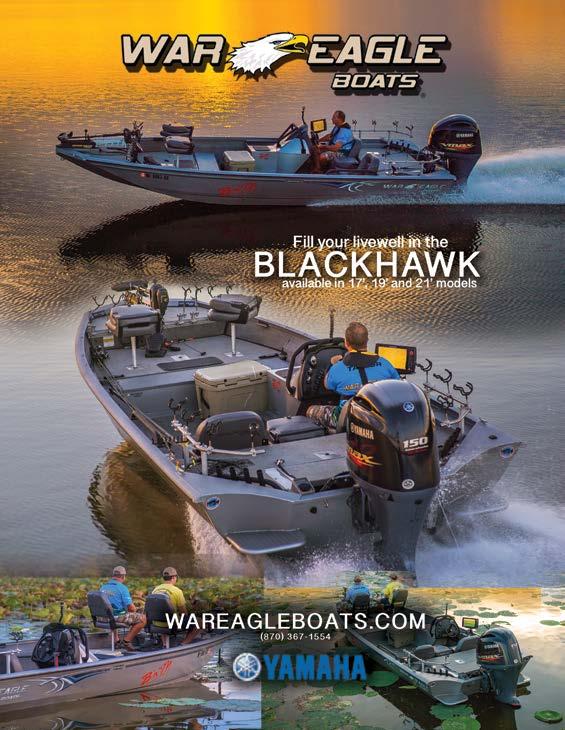
877.314.1237 // GreatDaysOutdoors.com // May 2024 47
Why You Should Go Blue Lining
BY MATT LEWIS, PHD
Photo by Dorsal Outdoors
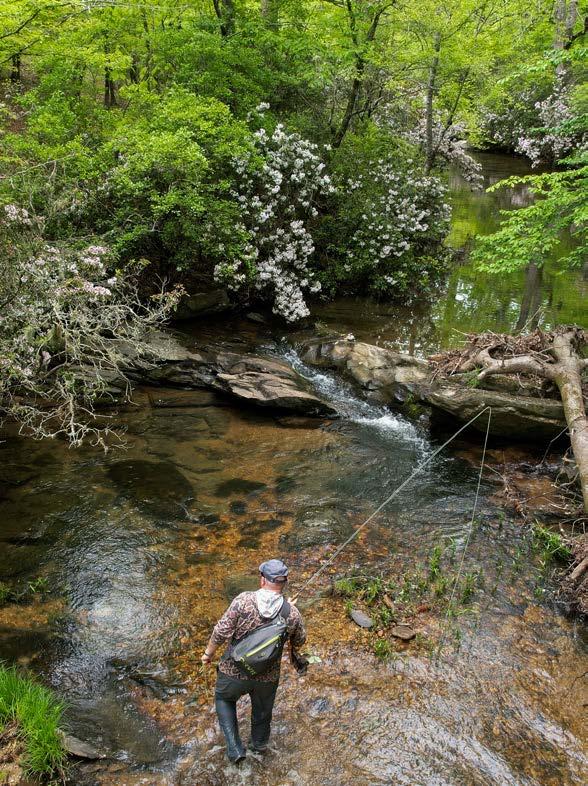
48 May 2024 // GreatDaysOutdoors.com // 877.314.1237
Have you ever driven to the lake to get away from it all only to find a traffic jam at the boat ramp? What do you do once the summer sun takes hold in Alabama, and the exposed nature of lakes and ponds makes the heat unbearable?
You can pontificate on the best windows to catch a fish in the day or obsess over moon cycles, or you can find less-pressured water.
Many anglers take refuge in the rivers and streams that coarse over Alabama’s diverse landscape. These streams offer shade, solitude, and an unrivaled biodiversity, allowing the angler to escape the many pressures of life. Alabama has over 130,000 miles of streams, each represented by “blue lines” on a map. Many anglers spend hours looking over these blue lines in search of an access point.
Once a likely spot has been located, the thrill of the chase begins as you drive down gravel roads and blaze new trails to scout your next honey hole. Often this tactic involves climbing into canyons and bushwhacking through laurel bushes and other herbaceous streamside guardians. Although you will encounter many sinuous serpents that will have you on full alert, the front row seat to all the flora and fauna is well worth the price of admission. This method of exploration of remote waters by fishing is often referred to as “blue lining”.
In a world where there is so much emphasis on connectivity, many anglers are looking to get away from the crowds and find a more secluded and undisturbed spot. Maybe it’s the possibility that a lunker bass is hiding in that stream, or the chance that an arrowhead will be discovered sitting on that gravel bar. The latter reminds us that we are not the first to explore these backcountry streams. However, this is as close as we can get to the days of old where unpressured waters were the norm.
Anglers often post on social media hoping to find help or advice into the mysterious ways of blue lining. Instead, they are often met with frustration that the newcomer is not willing to discover it themselves, or that the novice might reveal a “secret” spot. Experienced anglers often spend hours scouting maps before burning gas money and shoe leather to learn by trial and error which spots provide the best bang for their buck. This hard-earned knowledge often makes serious blue-liners a tight-lipped lot. Just like turkey hunters are not willing to drop coordinates to a gobbling bird or crappie anglers refuse to share the locations for the best filets, the precise access points to watery nirvana are highly guarded.
But while information may not be freely handed out on social media, new technologies make it easier than ever to locate good blueline streams. Paper maps have been largely replaced by electronic versions with aerial imagery. This technology provides crisp imagery to evaluate the presence of shoals, bridges, and other features of interest that serve to drastically reduce the need to physically drive to every spot. It’s hard to discover truly new water anymore, but you can spend a lifetime fishing water that is new to you!
To start blue lining, you need to first decide on what you want to catch. In many cases the type of water features you will search out will differ based on the species you wish to pursue. Do you want to catch stream-dwelling bass, or do you want to go after more exotic options for the fly angler, such as chain pickerel? Your preferred target species determines everything from fly rod weight all the way down to the type of flies and what water features you want to look for.
Once you have located the waterbody, look upstream for tributaries. Scout for features that you want to find depending on the target species. Note, some streams are seasonal, and you may arrive to what was a blue line on a map only to find a gravel trough in real life.
Once you have located a potential spot, if a trail or road provides easy access, you may consider putting in a little more effort to get to the truly good water. Once you get into the stream, hike a half a mile upstream or downstream before fishing, or drive until you find a spot where the creek parallels the road and do a little hiking to get to the water. Both tips will ensure that you put in a little more work than the average angler and will hopefully be rewarded with unpressured fish.
Be mindful that sometimes, despite how skilled we think we are, fishing can be
tough. The old cliché of “that’s why they call it fishing and not catching” comes to mind. Fish a stream a few times before making a final judgment on its merits as the time of day, season, and other factors might have impacted the one small window of your visit. I have been skunked on the very same streams that have also provided me with some of my most memorable catches. Depending on the species, certain weather patterns and spawning seasons may shut down the bite.
A few items are essential to the blueliner pack. Drinking water is the most important consideration and a filtered straw will allow you to drink from the creek without risking a Giardia infection. You can also pack in a water pack or water bottle, but you need a way to obtain clean drinking water. Firestarter is one of those things that you don’t need until you do, and you would rather have it and not need it than need it and not have it. Packing a compass will also allow you to navigate if your cell phone runs out of power and you lose the ability to know your location or call for help.
Now that you have found some water to explore and know what to bring along, how do you approach fishing these waters? Fishing tributary streams usually results in finding yourself in small, remote streams with a lot of cover. This cover is not necessarily conducive to fly casting, so a short fly rod is usually best. A six to seven and a half foot rod is typical and will allow you to effectively side arm cast or roll cast in these tight quarters. The shorter rod length is also beneficial as you hike through thick brush. A two- or three-weight rod with a weight-matched reel and weight-forward floating line is recommended for many small-stream species such as panfish, chubs, shiners, and redeye bass.
An added perk of blue lining is the simplicity of the gear required. In addition to the fly rod and reel, a simple box of flies and some extra tippet will all fit into a shirt pocket. If you are on a longer adventure, a lumbar or sling pack will allow for sunscreen touch ups, water bottles, and a safe spot for your phone. Don’t ask me how many phones I’ve contributed to the stream bottoms.
Blue lining is typically a seasonal venture, spring through fall, when air temperatures are pleasant. This allows anglers to wet wade and ditch the cumbersome waders and enjoy the refreshing cool waters in what is sure to be warm air temperatures. Quick-drying long pants will provide some protection from sun, leeches, and ticks. Add a quick-drying bamboo hoody, a hat and some polarized sunglasses and you are set.
Fishing in an upstream direction usually allows you to approach fish from their blind spot as they are typically facing upstream to look for food washed into the current. Don’t be afraid to utilize the tree or rock cover to minimize your shadow and break up your outline. These waters are typically clear, and fish are well adapted to avoid aerial predators such as ospreys and eagles. Fly selection is less important than stealth on these remote streams as the fish are accustomed to a scarce food supply and rarely turn down a well-placed offering. Many of these fish are opportunistic and will eat anything that resembles a potential food source.
Once you find that magical creek, you will likely already be prone to secrecy, but in the interest of being thorough I’ll caution you to be careful who you share your new fishing spot with. Before you share photos of your catches and click that “post” button, consider a few final tips.
Make sure there are no defining features in your photos. Waterfalls, characteristic rock formations, and other easily identified landmarks will give away a lot more than you think, and this is why you sometimes see angler holding a fish with the background blurred out. Secondly, be careful who you share information with. I’ve shared spots with my very best friends that have quickly been shared with a few other close friends and before you know it, your spot looks like the crowded boat ramp you were trying to get away from. When this happens, you will finally understand why the experienced anglers kept their streams close to their chest.
Lastly, there is always a need to identify and discover new spots, so don’t stop searching once you find that one special creek, chances are in a state like Alabama, there are dozens of those special creeks!
FISHING 877.314.1237 // GreatDaysOutdoors.com // May 2024 49
Whether It’s Law Or Not, You Need to Descend Your Fish
BY TANNER DEAS

50 May 2024 // GreatDaysOutdoors.com // 877.314.1237
When fishing offshore have you ever experienced fish floating on the surface upon release? Wondering to yourself, “Why won’t that fish go down?” or, “Welp, that’s sharkbait…” Maybe you’ve reeled a fish in from the depths and seen its stomach sticking out of its mouth.
This happens when a fish has experienced barotrauma injury. Using a vent tool or descending device is the best way to avoid killing fish that could be potential trophy offshore catches, and to prevent needlessly killing a trophy fish that could pass on key genetics. It may not be the law, but it is a good idea to release these fish properly so that the amazing God-given resource we have in the Gulf of Mexico and other systems across the world is never depleted.
For this article, we took the time to discuss descending fish with Return ‘Em Right’s Nick Haddad, who broke down the pros and cons of descending fish and how it can impact the marine sciences as well as our fisheries.
UNDERSTANDING BAROTRAUMA
Nick gave an amazing explanation and broke down barotrauma and gave some science behind what is happening to the fish as they experience this injury when being reeled in from depth. A key thing to understand is that not all fish species experience barotrauma, such as Tuna, Wahoo, Mahi Mahi, and Mackerel. Barotrauma commonly occurs in reef fish like Triggerfish, Snapper species, and Grouper species as well as deep water species like Tilefish, Bearded Brotula, and Long Tail Sea Bass. Barotrauma is the expansion of gasses inside of the fish’s swim bladder when coming from bottom to surface which causes a rapid decrease in pressure. Signs of barotrauma injury include raised scales and rough looking patterns along the fish’s body, bulging eyes, and the most common, the stomach being pushed out of the mouth. When seeing the large bulge of tissue protruding from the fish’s mouth, most assume this is the swim bladder. But Nick Haddad explains that what is observed is actually the stomach, pushed out of place by the expanded swim bladder.
When a fish experiences this expansion of the swim bladder, it cannot swim back down to depth upon release. When the swim bladder expands it’s like trying to swim down with a life jacket. A fish’s swim bladder must be vented in order to release the fish properly.
ETHICAL CONSIDERATIONS WHEN RELEASING FISH
There are several ethical takes worth considering when talking about releasing these offshore fish, especially with a descending device. The first of them is avoiding unneeded injury to the fish’s internal organs by venting the swim bladder when a descending device is onboard. A venting tool is an excellent piece of equipment to have on hand, especially when a descending device is not present. However, venting tools poke holes inside the fish’s swim bladder causing injury that changes the fish’s behavior and requires some time to heal until they are back to one hundred percent. Nick Haddad gives some science to support this theory saying that there have been several acoustic telemetry tags that suggest fish after venting will stay on bottom longer than usual waiting on the healing process to occur. Usually, the fish heal up just fine, but there is always risk of infection when injuring the internal organs.
Another thing to consider is stewarding the resource. As highlighted in the intro, we as fishermen are here to steward what was given to us by God and passed on from generations before. It’s our duty to ensure its sustainability, as well as make it better if possible. Releasing these fish properly ensures fish have a higher chance of living to fight another day rather than allowing them to float on the surface for shark bait. Another facet of stewarding the fishery is having the ability to allow trophy sized fish to be released to breed again and pass on their special genetics. Some fish are meant to be harvested and may not release well, but it is important to keep in mind what a healthy trophy fish can do for our fishery if healthy enough for a release. To guarantee a quality release it can be best to have both tools on board, the venting tool and a descending device.
BENEFITS OF DESCENDING FISH
Let’s go over some of the benefits of descending fish for release rather than using a vent tool or using nothing at all. When a fish that has experienced barotrauma isn’t vented or released properly and an angler does nothing to fix that issue, the fish is guaranteed to float on surface and never make it back down to depth, almost certainly becoming shark bait or bird food. Doing nothing is never the right option.
Venting has traditionally been the most popular way of releasing fish that have experienced barotrauma. By poking a hole inside of the fish’s swim bladder with a sharp pointed vent tool, an angler is able to relieve the gaseous pressure the fish is experiencing, allowing it to swim back to bottom where he was retrieved from. Venting is a great method and gives the fish the ability to fight another day, but may cause internal injury or infection as mentioned above.
A descending device, on the other hand, prevents further injury to the fish by bringing the fish back to depth without causing bodily injury. The descending tool brings the fish back down to bottom with a weight, which allows it to then regulate its internal pressure and decreases the pressure on the swim bladder thus causing it to regain its ability to swim and guarantees the smoothest release and healthiest release for fish that have experienced barotrauma injury. Another positive of the descending device is that it doesn’t require extra injury to the fish by a possible miss with the venting tool needle on a day with rougher seas.
TECHNIQUES
FOR DESCENDING FISH
The four most popular techniques for releasing fish are the venting tool and three different descending devices. The first of these descending devices are the Seaqualizer, a lip grip type of gripper rigged on a fishing pole that descends the fish with a heavy weight and opens up when pressure is taken off of the line after descending to bottom.
The second of these are a device that uses the same fishing pole/weighted method with an inverted barbless hook that releases the fish easily. The third of these is a hand made, net-style releasing device that traps the fish with a weighted descent and releases them when the net is retrieved.
Seaqualizers and inverted hook descending devices can be obtained for free by taking a fifteen minute education video on returnemright.org. This descending device pack has a $100 value and could be a major contribution to properly releasing fish and stewarding your local resource. Return ‘Em Right initiative has now deployed over 30,000 descending devices in less than two years and plans to increase those numbers to impact our fisheries for years to come.
CONCLUSION
In conclusion, whether or not it is required by law, there is just no reason not to descend a fish. Not only does it guarantee a better release and chance for the caught fish’s survival, but it also gives the angler the ability to contribute to a positive fishery for years to come. It also reduces internal injury to the fish which can be caused by the “old reliable” venting tool. Finally, in addition to preventing barotrauma, a descending device can be used to quickly return a fish to depths where they are safe from sharks and other predators.
The Return ‘Em Right project seems like a positive initiative for all offshore and nearshore anglers to be a part of and could be the reason your next released catch gets a good release and swims back home. Don’t forget to check out returnemright.org to get your free descending device today!
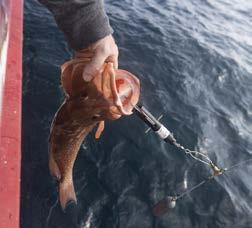
FISHING
877.314.1237 // GreatDaysOutdoors.com // May 2024 51
Are AFTCO Fishing Shorts Worth It?
BY NICK WILLIAMS
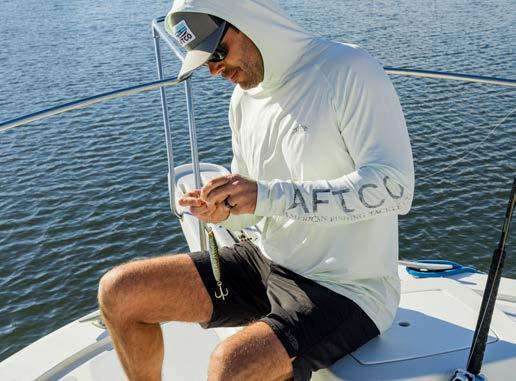
Angling as a hobby has steadily increased in popularity and cos t in the last 100 years. As American GIs returned from WWII eager to relax and forget the horror of war, corporations who made fortunes supporting the war effort, such as Abu Garcia and ZEBCO (Zero Hour Bomb Company) turned from producing armaments to producing fishing gear. Relatively quickly, a simple hobby was turned into an arms race of sorts as competing companies promised better and better performing rods, reels, fishing electronics, and other gear.
Fast forward to today, and the “premium” tag has been applied to everything from sinkers to skiffs. Premium hooks are chemically sharpened and will catch more fish. Premium reels have magnesium alloy bodies and will resist saltwater corrosion. Premium coolers are rotomolded and will hold ice longer. As nice as all of this sounds, there’s a catch. We all know that premium products demand, of course, premium pricing.
In this article, we’re going to dive into the nitty-gritty details on a very popular premium product, AFTCO fishing shorts. Are they worth the extra cost for hard-fishing anglers, or are they just the “in” thing to have for folks with disposable income who want to look the part?
THE HISTORY OF AFTCO FISHING SHORTS
While you’ve most likely seen AFTCO shorts “in the wild,” you may not be familiar with the history of the company behind them. AFTCO shorts have been around for a surprisingly long time. AFTCO originally referred to the Axleson Fishing Tackle Company, and the company specialized in high-end roller guides. The company was founded in 1958, and purchased by Milt Shed (who, among other ventures, co-founded Seaworld) in 1973. Milt’s son, Bill Shed, launched the company’s clothing line in 1989.
It’s easy to forget in a world awash in sport-specific, technical clothing, but 35 years ago there was no such thing as a pair of “fishing shorts.” If you were fishing, and you were wearing sho rts, those were fishing shorts! AFTCO changed the game with their Original Fishing Short, and while in recent years they have become their own fashion statement, at heart the shorts are made for and by people who fish hard.
EVALUATING FISHING SHORTS
Fishing shorts should be three things: comfortable, durable, an d functional. Comfort is an obvious criteria because shorts are, after all, casual wear. Durability is another obvious concern for most anglers, because fishing apparel is exposed to stray dock screws, filet knife blades, barbed hooks, salt spray, sun, and a variety of
52 May 2024 // GreatDaysOutdoors.com // 877.314.1237
unsavory liquids.
“Functionality” is trickier to evaluate, because it’s often marketing-speak for “gimmicky.” Anybody who has owned a multitool knows that in many instances, half of the tools on it are non-essential and merely thrown in so that the tool can boast 17 functio ns instead of 8. How many times in your life have you really neede d a corkscrew, for example, and not been standing in a kitchen next to one? Fishing specific features on clothing need to be actual ly useful to win points for functionality, and above all they shouldn’t interfere with the first two criteria or artificially raise the price point.
COMFORT
Shorts are generally more comfortable than pants because they breathe better and bind less when moving. If it wasn’t for this, most anglers would have moved on by now to wearing UV-resistant pants when out on the water. Fit is, of course, paramount to a good-fitting pair of shorts. There are a wide variety of short styles on the market, from uber-short and tight running shorts, to belowthe-knee cargo shorts.
AFTCO’s Original Fishing Shorts are built, according to AFTCO Design Director Jillian Hidalgo, to allow for comfort and mobility, without appearing “baggy.”
“The M01 is a classic style, and it’s been very popular over the years,” she says. “We try not to touch that one too much, because people have been wearing them for so long and love them so much.” While these shorts fit fairly loose in the hips, thigh, and leg openings, and have an elastic waistband for added comfort, they’re sharp enough to look “Gulf Coast Business Casual” for many outdoorsmen.
“The Original looks great on a lot of guys,” Jillian continues, “but we do have a “Big Guy” cut as well. As one of our field testers told us, some anglers are ‘vertically challenged, but horizontally blessed.’ We also have the new Tactical Fishing shorts, which are more of what we call a ‘deckhand cut.’”
Anybody who, like the author, has fished a lot in cotton shorts and denim jeans knows that there’s nothing more uncomfortable than clothing that gets wet and stays wet. Most “fishing shorts” are no longer made from cotton, thank goodness, but there are definitely better and worse synthetics to use in construction. Polyester is cheap and fast-drying, but doesn’t have great abrasion resistance and is prone to feeling “plasticky.” Nylon is more durable and feels more like a natural fiber, but is not hydrophobic like polyester.
DURABILITY
Part of what you pay for with AFTCO shorts is the material used in construction: 3-Ply DuPont™ Supplex® Nylon. Like Gore-Tex, Supplex is a patented fabric material that offers big advantages to outdoorsmen. Supplex utilizes a much finer fiber than the generic nylon used in cheaper garments, which makes it up to 30% softer. It looks and feels more like cotton, but also has a DWR (durable waterproof coating) applied to it at the factory that makes it extremely water-repellent. Supplex nylon is also extremely resistant to color fading and shrinkage. This material is a big part of the legendary durability of AFTCO shorts. Thanks to Supplex, AFTCO shorts are soft but durable, and highly resistant to soaking or staining.
In addition to using premium material, AFTCO takes a little extra care when stitching their shorts together to ensure maximum durability. High-wear seams are double stitched, and the seat of their shorts are double layered to ensure maximum durability.
Another often overlooked factor when durability is considered i s the quality of the stitching. During our conversation, I bemoaned to Jillian that I had a pair of shorts in my closet that were out-of-commision, waiting on a spare afternoon to restitch a button that
popped off not due to a heavy lunch, but a simple trip through the washer and dryer!
“Yep, that happens a lot,” she nodded. “People don’t understand that a lot of aspects of garment construction still have a big human element. A lot of it is automated, but some stuff, like buttons, you have to have a skilled seamstress to do that right. If you’re not making enough stitches through something like a button, it won’t hold. It takes time to make the extra passes, and sometimes manufacturers get in a rush to meet quotas, and that’s when those issues pop up. We keep a good relationship with our manufacturers and the people doing that work, but we also have a very stringent QC program to ensure that little things like that don’t happen. ”
FUNCTIONALITY
Aside from being comfortable and durable, when you buy premium, sport-specific garments, you typically expect something “a little extra.” When I bought my first piece of Sitka gear (their Duck Oven jacket) I was mainly interested in the Primaloft Silver insulation and Gore Tex windbreaker material, but I was pleased by a couple of small design choices they made that made the garment better for duck hunting than a similarly-priced garment that was geared to say, ultralight backpackers. The jacket has more insulation in the top half and less on the bottom, which is perfect for duck hunting because any insulation in the bottom would just get compressed by my waders. It also has two chest pockets that ride high, allowing me access to them when I’m wearing waders. The more I wear the jacket, the more I appreciate those little features. Far from being gimmicky, they’re actually incredibly useful.
Similarly, AFTCO shorts introduced an often-imitated but rarely well-executed feature that is specifically geared towards anglers. In addition to the standard 6 pockets found on most cargo pants ,
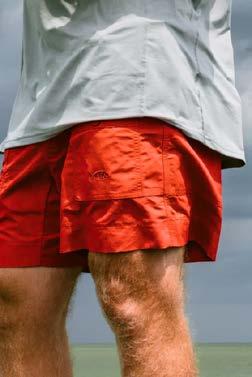
FISHING
877.314.1237 // GreatDaysOutdoors.com // May 2024 53
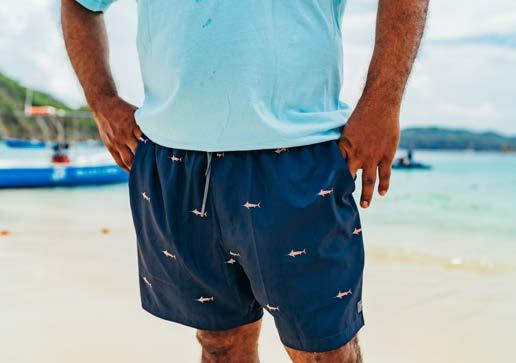
they also include a cordura-reinforced pliers pocket. Whether I’m fly fishing for panfish or pursuing big, toothy, saltwater species, a pair of pliers or hemostats is a constant companion. Having a designated place for them means that they’re never left in the back of the boat when you need them on the front of the boat, or (worse yet) left on a rock somewhere on a bank-fishing trip.
Plenty of companies offer a pliers pocket, sure, and for a long time I was of the opinion that sticking them in the back pocket worked just fine. But as you know if you’ve gone that route, pliers are hell on most fabric. The extra stitching and layer of cordura means that you can actually use AFTCOs pocket without wearing a hole in it. In and of itself, the pocket isn’t a huge selling point, but it’s the icing on a pretty well-baked cake.
CHEAP VS ECONOMIC FISHING SHORTS: A COST BREAKDOWN
“All of that’s well and good,” you might be thinking, “but I’m still not paying that for a pair of shorts.” Fair enough. AFTCO shorts aren’t cheap, and nobody I know can afford to buy all premium gear, all the time, for all their hobbies and interests. But are they really that expensive?
Compared to other premium outdoor clothing brands, not at all. Peruse any of the other “high-end” performance brands, and AFTCO’S offerings are very middle-of-the-road price-wise. And none of those brands have been offering angling-specific products for as long as AFTCO.
“That’s great, but I can buy a pair of shorts for $29.99 at the local big box store,” you reply. Also a fair point. But how many seasons are you getting out of them? Personally, I’ve bought my fair share of house-brand, Black Friday specials. Without fail, they’re trashed after two to three seasons of hard use. Ignoring everything we’ve
talked about concerning durability, comfort, stain resistance, etc., are AFTCO shorts capable of competing on value?
To answer this question, I posed a simple question to a couple of friends who are avid fans of the M01 shorts. “How many seasons do you usually get out of a pair of AFTCOs?”
“I actually just tossed a pair last year that I’ve had since 20 07,” one said after a few moments of reflection. “The elastic wore out in the waistband, but other than that, they were still good.”
“Yeah, I’ve got a buddy who has been wearing a pair that he got on his 21st birthday back in 2003.”
Let’s do the math on that. If you buy a cheap pair of shorts for say, $25 and you wear them for twice as long as they usually last fo r me, you’ll spend $25 on a pair of shorts every four to six year s. By the time you trash them, you’ve spent around four to six dollars on shorts per year. Not bad.
By contrast, if you buy a $70 pair of AFTCOs and use them for seventeen to twenty-one years, like mentioned in the example above, you’re spending three to four dollars on shorts per year.
Go ahead. Check the math. AFTCOs are actually cheaper than “cheap” fishing shorts.
CONCLUSION
To summarize, AFTCO shorts really are a case of “you get what you pay for.” Yes, they aren’t the cheapest shorts on the market. But when you consider the fact that they’ll last longer and perform better than cheaper alternatives, they’re the definition of “va lue.”
Are Aftco Fishing Shorts Worth It?
54 May 2024 // GreatDaysOutdoors.com // 877.314.1237
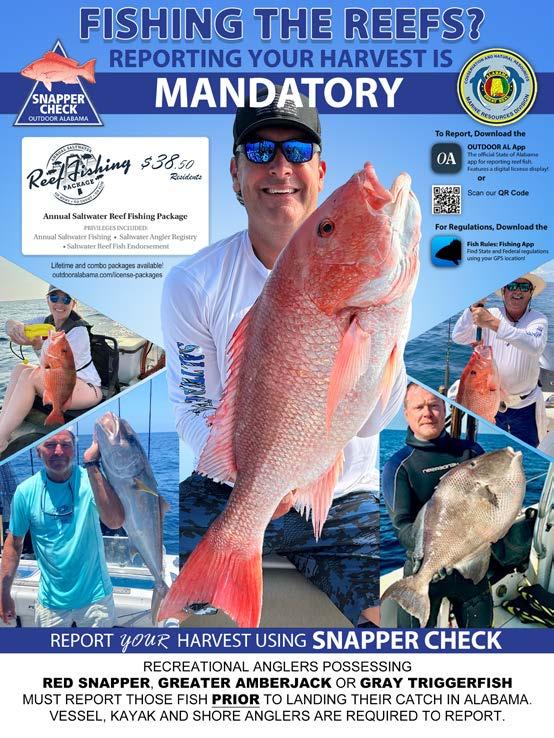
877.314.1237 // GreatDaysOutdoors.com // May 2024 55
Conservation Minded Ways To Make Money With Land
BY JOE BAYA
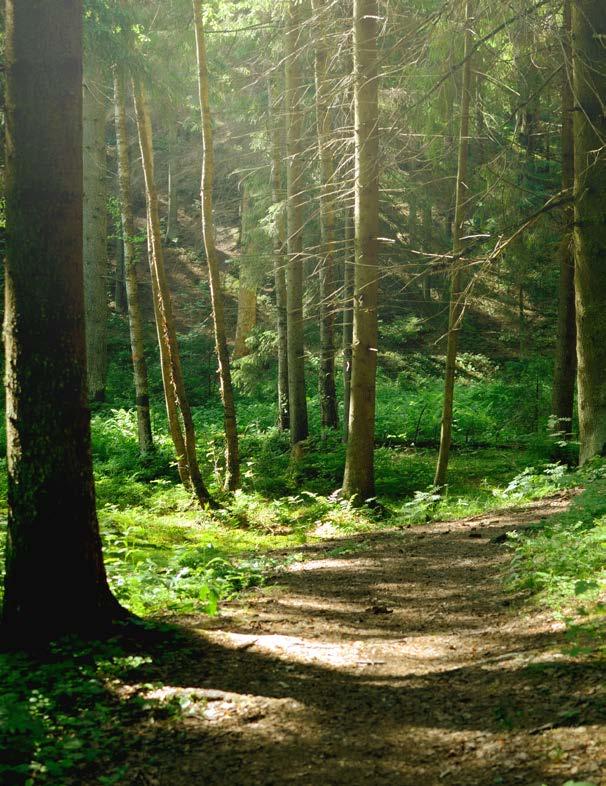
Camping, and fishing leases are all possibilities for landowners who are looking to generate income
56 May 2024 // GreatDaysOutdoors.com // 877.314.1237

Learning ways to make money with land often seems like a tradeoff with my property’s conservation-minded and wildlife habitat-oriented stewardship. When I learn about new habitat management techniques or sustainable land management methods, the end result more often than not is less money in my pocket, not more.
I’ve heard of various private and public landowner assistance programs, but the process of determining which programs I’m eligible for and which programs can be used together is arduous at best. I have a family, and a full-time profession, and my land gets whatever time I have left and this means it’s hard to find the time to dig into the various programs that are available to me.
NEW WAYS TO MAKE MONEY WITH LAND
There’s a new solution for landowners who want to sustainably manage their land from both an economic and ecological perspective. NCX (Natural Capital Exchange) is a new platform that has become a one-stop shop for landowners who are looking for public and private landowner assistance money that is available to them. The platform helps landowners determine which money they are eligible for, and how to compare if the structure of the program matches their individual land stewardship and investment goals.
Over 22,000 landowners have received more than $20,000,000 in payments thus far and the platform and available programs are
I recently created an account (completely free) and I was surprised to learn that I am eligible for 36 different programs that can provide me with cash to perform land management activities (and in some cases do nothing at all). With over 100 programs available to landowners across the nation, you are almost certainly eligible for programs that can help you make money without having the tradeoffs so common with generating income from your land. Let’s take a look at some of the potential opportunities for you.
HOW CAN I MAKE MONEY WITH MY LAND WITHOUT HARVESTING TREES?
On properties with merchantable timber, harvesting trees is a common way to make money with land. While lowering the basal area of a timber tract and introducing prescribed fire is a great way to improve wildlife habitat, clearcutting, especially for smaller landowners, can decrease the aesthetic value of the property as well as the soil health of the forest stand. Along with this, depending on the method of management, plantation forests often leave large spans of time where the tract has very low wildlife benefit.
There are many programs, both private and public, that want landowners to defer their timber harvest to sequester more carbon from the atmosphere. Many corporations are willing to pay these landowners to do this to reduce the organization’s carbon footprint. And these programs aren’t just for rural landowners, there are even programs for protecting small-scale urban forests. The bottom line is that you don’t have to cut down your trees to make money off them anymore. The market is changing and organizations want to be associated with this kind of practice and are willing to pay good money to do so.
HOW TO MAKE MONEY FROM LAND WITH TREE
If you’ve owned a timber tract for very long, you understand that the cost of reforestation is significant. NCX has a multitude of programs that make cash available to landowners who want to do everything from restoring Longleaf pine in the Southeastern Coastal
Plain to Bottomland hardwoods in the Mississippi Delta to wildfire and pest-affected forests in the West and Community forests in the Northeast. These programs exist for a variety of reasons from carbon sequestration to wildlife habitat improvement to soil health and water quality improvement. If your land needs to be reforested in any way, there’s a good chance that money is available to you for that effort.
HOW TO GENERATE INCOME FROM LAND WITH RECREATION
Many landowners are familiar with the potential to lease their property to hunters as a way to make money with land. But for many landowners, hunting is a major driver of land ownership in the first place. Did you know that there are whole markets of people who are looking for more recreational experiences than just hunting? Farm and Ranch tours, fishing experiences, Camping, and fishing leases are all possibilities for landowners who are looking to generate income.
USING LAND TO MAKE MONEY THROUGH RENEWABLE ENERGY
Have you looked closely at your power bill lately? Aside from the increasing costs per kilowatt hour, you may have noticed your energy provider offering a choice of solar energy. More and more energy companies are starting to develop large solar farms that are being used to help power the country. You may be positioned to turn unproductive or unused land into a revenue-generating asset by allowing a solar development on your property. This can mean big bucks in perpetuity.
WHAT TO DO WITH LAND TO MAKE MONEY –CREATE BIODIVERSITY
Websters Dictionary defines Biodiversity as the “biological diversity in an environment as indicated by numbers of different species of plants and animals.” Just as there are a diverse number of plant and animal species, there is a diverse range of programs available to put money in landowner’s pockets who promote biodiversity on their land. Want your oaks to produce more acorns? There’s money for that. Interested in improving your Bobwhite Quail numbers? There’s money for that. Is your spouse big into birds? There’s money for a host of songbird species habitat improvements. What about bats? Prairie Chickens? Sage Grouse? Black Ducks? Thinning your timber? Rehabbing hardwoods? You guessed it, there’s money out there just waiting on you to apply for it.
WILDFIRE RISK
I recently had a neighbor’s prescribed fire jump a county road onto my property. These things happen. Luckily, a fire break just inside my property line stopped this fire from running wild on my property. Measures like firebreaks, understory height reduction, fuel load mitigation, and patch openings can all help reduce the risk of catastrophic wildfires. You owe it to your property and your neighbors to make sure you do what you can to prevent wildfire but instituting the above measures is not without expense. When wildfire risk is reduced, we all benefit, and some programs recognize this so that the total cost of these efforts isn’t on the landowner.
WATER QUALITY PROGRAMS TO CREATE PASSIVE INCOME
My property is approximately 30% wetlands. When I visit these areas, I am always pleased by the diversity of plant and wildlife species that I see there. In addition to this, these wetland areas are
LIFESTYLE 877.314.1237 // GreatDaysOutdoors.com // May 2024 57
critically important in preventing erosion and the runoff of nutrients that pollute our waterways. Sensitive areas on your property can earn you up to $50,000 in annual payments by implementing a conservation plan. You just have to see what’s out there and if your land is eligible.
STACKING PROGRAMS FOR PASSIVE INCOME FROM LAND
With all of the available programs, you might be wondering which one you should go for to generate the most income. The good news is, some programs can actually be stacked meaning you can have multiple programs underway on the same acre. All of the program requirements are different, so it takes a careful eye to know which combination of stacking will yield the results you want. NCX has included which programs are stackable so that you can be sure to generate as much conservation-minded income as possible.
MAKING MONEY FROM LAND DOESN’T HAVE TO COMPROMISE CONSERVATION
There are more ways landowners can make money with land without having to harvest and haul something away from it. Trying to determine all of the available programs, your eligibility, which programs can be stacked, and whether or not a program is a good fit for your objectives was once a process too arduous for a lot of landowners to accomplish. If you want to learn how you can do this, it’s completely free, and it’s really easy to find out. Go to ncx. com and follow their step-by-step guide for landowners and you’ll see the plethora of money that is available to you. They even offer cash bonuses when you get approved on your first program.



Cables · Transmission Parts · Ring & Pinions, Axles · 4X4 Drive Shafts & Differentials Custom Built Control Cables · Complete 4WD Services · All Types of Parts Specializing in Agricultural Clutches and Drive Shafts Time to Get Your 4x4 Ready for Hunting Season 1159 South Broad St. MOBILE, AL 36603 1-800-239-2191 OUR LOCATION 251-433-3696 www.clutchproducts.com DIVISION OF CLUTCH PRODUCTS INC. & POWERTRAIN Conservation Minded Ways To Make Money With Land
If your land needs to be reforested in any way, there’s a good chance that money is available to you for that effort 58 May 2024 // GreatDaysOutdoors.com // 877.314.1237
When it comes to red snapper, Alabama can do better OPINION:
BY DR. BOB SHIPP
During my 21 years as an Alabama representative to the Gulf of Mexico Fishery Management Council, I’ve seen just about every type of fisheries management dilemma imaginable. Our Gulf fish stocks are subject to myriad pressures and Council members must often grapple with profoundly complicated problems in their efforts to manage our marine resources in a sustainable fashion.
Perhaps the most controversial of all those marine resources is the red snapper fishery, and it is a job that could be made much easier with just a few simple changes to the federal fisheries management process.
For one thing, my years of research on red snapper has found that this species does not migrate. In my work at the University of South Alabama, we organized hundreds of research cruises to tag red snapper at reef sites all over the Alabama coast and found that the species demonstrates tremendous site fidelity. In some instances, we recorded tag recaptures for 20 years at the same reef site! The research demonstrates that red snapper could be managed much more effectively as a resident species according to the population and habitat characteristics off our coast.
Instead, the federal management process treats the red snapper fishery as a single entity, from the Florida Keys to Brownsville, Texas. That approach ignores the vast differences in habitat and fishing pressure that exists across the five Gulf Coast states and instead applies a one-size-fits-all management strategy. Treating a fishery spread across such a diverse ecosystem as a single population with a single quota is bound to produce unnecessarily disparate management measures and opens the door for a lot of mistakes.
Similarly, recreational catch is one of the crucial data streams at the heart of every management decision, and yet federal efforts to accurately quantify it have failed miserably for decades. Just this past August, NOAA Fisheries announced that a study of the mailed survey it uses to estimate recreational fishing effort may be over-estimating recreational effort by 30 to 40 percent. In an endeavor that desperately needs hard data to function, this kind of failure has a devastating impact on the legitimacy of the entire federal fisheries management system.
Fortunately, in 2020, after decades of frustration over Gulf red snapper management, the Gulf states were given the responsibility to collect data on what their state’s recreational anglers are catching. Alabama developed the Snapper Check data system which uses an electronic reporting system and dockside surveys to gather trip information, as well as length and weight measurements from landed fish. The new system is significantly more accurate than the federal system and
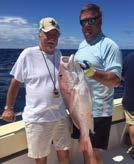
allows for almost real-time management of recreational quotas.
Unfortunately, because Alabama still operates within the federal recreational data system, the state’s data are required to be recalibrated back into the federal data system…the same one that was just declared to be incorrect by 30 to 40 percent. The entire reason for the states to develop their own systems was to provide faster, more accurate, reliable information. Recalibrating back to the broken federal system is an unnecessary step backwards.
The simple solution is for Alabama to leave the federal recreational data program altogether and there is precedent for this. The West Coast states left the federal system decades ago, for the very same reasons Alabama and the Gulf states were compelled to develop their own data programs - they determined the federal data program was simply beyond salvaging. They built their own better systems, just as Alabama has.
The Alabama Department of Conservation and Natural Resources should be commended for the work it put into Snapper Check. It is one of the finest data systems in the Gulf and infinitely more capable of managing this state’s recreational fishing sector. Now it is time to take the only logical next step and declare independence from the federal data system once and for all.
Management of red snapper and our other offshore fisheries doesn’t have to be an ongoing train wreck, fraught with uncertainty from year to year. Regionalizing management and abandoning the federal recreational data program are two relatively easy steps that would inject some much-needed stability into the management of our Gulf marine resources.
Dr. Bob Shipp (1943-2024) served on the Gulf of Mexico Fishery Management Council for 21 years, and was considered one of the foremost experts on red snapper, triggerfish, and other species of importance to recreational fishermen of the Gulf Coast states. He was the Chair Emeritus of the Department of Marine Science at the University of South Alabama and was a former member of the Alabama Conservation Advisory Board, which advised the Commissioner of the Department of Conservation and Natural Resources and the Governor of Alabama on conservation-related issues. He was the long-time judge of the Alabama Deep Sea Fishing Rodeo, the largest fishing tournament in the world, and had more than 50 years of experience in the fisheries in the Gulf of Mexico. We at Great Days Outdoors are greatly saddened by his recent departure, but take comfort knowing that his work in conservation is being continued by countless individuals that he inspired over the course of his long career
FISHING
877.314.1237 // GreatDaysOutdoors.com // May 2024 59

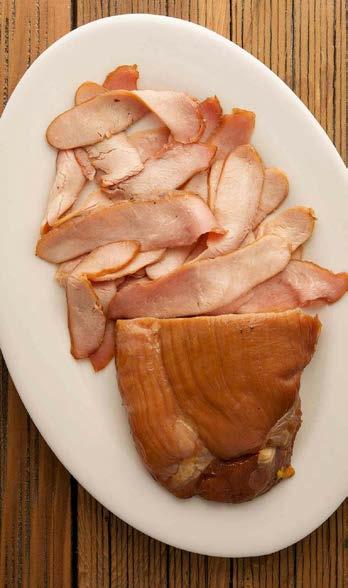
Smoked Wild Turkey Breast
To trim, I slice off the thin triangle of turkey breast that lays over the tail end of the breast -- you will notice that all bird breasts have a thick and a thin end, and you are trimming the turkey’s breast so you have, more or less, a big cylinder of meat that smokes better.
Prep: 20 mins • Cook: 4 hrs • Total: 4 hrs 20 mins
Ingredients
• 1 skinless turkey breast, trimmed (see note above)
• kosher salt (see note above)
• 1/4 cup brown sugar
• 1/3 cup honey, maple syrup or other syrup
Instructions
1. Mix together the salt and sugar. Massage the mixture into the meat and, ideally, vacuum seal it. If not, put the salted turkey into a freezer bag. Set in the fridge for at least 3 days to cure.
2. Remove the turkey breast from the bag and set it in the fridge, uncovered, for an hour or three to form the pellicle, a sheen that allows the turkey to take on smoke better. Turn the turkey over a few times while you do this. Don’t skip this step!
3. Smoke the turkey slowly at about 200ºF until it reaches an internal temperature of about 160ºF -- this takes about 4 hours with my smoker. Let the turkey smoke undisturbed for an hour, then paint it with honey every 45 minutes or so until it’s done. When the turkey is ready, take it out of the smoker and set it on a rack. Paint it one more time with the honey and serve any way you like it: Warm for dinner, or cold for sandwiches.
Note: Once made, the smoked turkey will keep in the fridge for a week or so, and can be frozen (vacuumsealed is my preference) for up to a year.
60 May 2024 // GreatDaysOutdoors.com // 877.314.1237
Smoked Oysters
Prep: 1 hour • Cook: 2 hours
• Total Time: 3 hours
Ingredients
• 40 to 50 oysters in the shell
• 1 cup dry vermouth or white wine
• 1 cup water
• About 1/4 cup high quality olive oil or other oil, such as walnut or hazelnut
Instructions
1. Make sure all the oysters are clean by running them under cold water. Bring the vermouth and water to a boil and add some oysters in a single layer. Cover and steam until they are open, which should take between a minute and 3 minutes. Move opened oysters to a bowl or baking sheet and add more fresh ones until you’ve steamed them all open.
2. Strain the cooking liquid through a paper towel or cheesecloth (to remove all the debris) into a bowl. Set aside.
3. Use a small, sharp knife to remove the oysters from the shells, trying your best to get the little “scallop” muscle that holds the oyster in its shell -- it’s tasty! When it’s done, drop each oyster into the strained broth. Make sure all the oysters soak for at least 20 minutes.
4. Fire up the smoker. I use alder or cherry wood, and I like the temperature to be around 145°F. Keep in mind oysters are small, so you will need a fine grate to prevent them from falling through. I use dehydrator mats. Smoke the oysters for 90 minutes to 2 hours -- you don’t need a whole lot of time here, just enough to get a smoky flavor without overcooking them. Don’t let the smoker get too hot!
5. When they are done, toss the oysters in the oil and eat, or store in a glass jar in the fridge for up to a week. Freeze what you don’t eat.
Note: Once made, these oysters are excellent in a mixed seafood chowder, stew or pasta -- at the last minute, remember they are cooked. You can also just eat them as an appetizer on crackers.
Something acidic, like minced shallot or chile soaked in lime juice, is an excellent accompaniment.
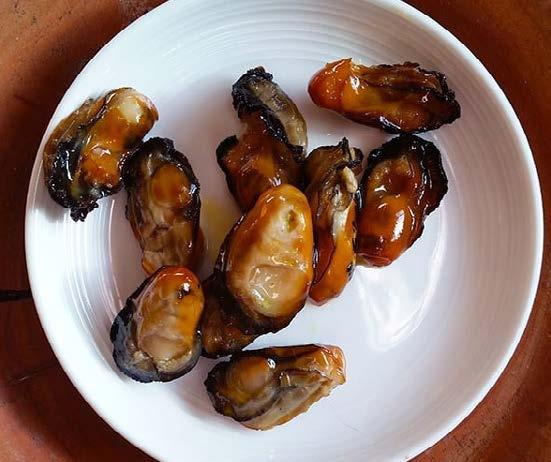
CAMPHOUSE KITCHEN 877.314.1237 // GreatDaysOutdoors.com // May 2024 61
NEW & Cool gear
BY NICK WILLIAMS
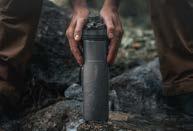
Grayl Geopress Ti Filter and Purification Bottle
Designed for hikers, hunters, anglers, overlanders, international travelers, and survivalists, the GeoPress Ti represents a new pinnacle in portable versatility. Crafted from premium CP4 Grade 1 titanium, with durable oversized handles, a wide cooking surface, and OnePress® global purification capabilities, the GeoPress Ti serves as a water collector, filter, purifier, drinking vessel and cookpot all in a single, compact bottle.
Northland Fishing Tackle Tungsten Crappie
King Fly
For a long time, anglers have loved using Northland Fishing Tackle’s Gypsi Jig and Fire-Fly Jig to catch crappie, and these jigs have become essential items in their fishing gear. The new Tungsten Crappie King Fly is now hitting the scene and is set to be even better at catching panfish. This jig has a natural, flowing action that attracts fish and is made of tungsten, so it casts farther and sinks faster, helping anglers detect bites more easily. The Crappie King Fly, with its hand-tied feather and tinsel tail, is available in eight colors, including three glow-in-the-dark options, allowing fishermen to match the lure color with the preferences of fish in different waters.
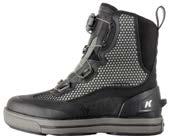
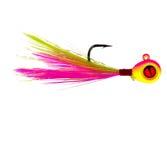
Korkers Chrome Lite BOA
Unique to the Korkers’ line, the new Wade Lite™ Collection features a fixed sole construction (non-interchangeable) incorporating their new Kling-On Rock™ performance outsole. Kling-On Rock™ is a new proprietary sticky rubber sole compound that is light, flexible and provides positive grip on both dry and wet rock. The Macro-Lug™ design allows for solid performance on softer terrain such as mud and wet grass, while the razor- siped tread sheds water and provides sure-footed confidence with every step. Embedded nylon anchor plates allow for retention of Korkers new XTRA-BITE™ carbide screwin cleats if additional traction is desired.
Timber Ninja Ridge Runner Waist Belt
The Timber Ninja Ridge Runner Waist Belt - Mobile Turkey Hunting Kit is perfect for turkey hunters who prefer a minimalist approach, enabling them to swiftly cover more ground without being weighed down. Weighing just 14 ounces, this waist belt is designed for ease of movement, allowing hunters to chase gobblers from ridge to ridge without unnecessary bulk. It features a Molle webbing panel across the top for customizable gear setup, reinforced loops for attaching a shoulder strap, and a two-way tightening system to ensure the belt stays snug. Additionally, it includes an integrated mudflap for carrying extra layers or a seat pad. Made from NinjaMax material, the kit is not only lightweight but also water-resistant and tear-resistant, showcasing its American-made quality.
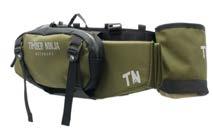
62 May 2024 // GreatDaysOutdoors.com // 877.314.1237

Argali Outdoors Sawtooth Knife
Nested Z8 Treestand System
The Nested Treestand System is the first packable treestand system that integrates a pack, lightweight hang-on, and a set of climbing rails into one streamline design. The key is how all three components work seamlessly together. When combined with the Z8™ Hang-On the Core Pack™ creates an easy to carry frame pack where the gear bag nests within the Lite Rails™. With Nested®, every piece is designed to have a precise place, so the entire system is quiet, secure, and easy to carry.
Made in the USA with premium Magnacut Steel for long lasting edge retention and corrosion resistance, the Sawtooth features a full 4” handle with textured G10 and a blade shape ideal for those that want a lightweight knife without sacrificing a full length handle and blade. The Sawtooth still registers as a lightweight knife at 2.3 ounces that is equally at home in the backcountry or the front country.


Slick Trick Revival Broadhead
Part of the new premium Slick Trick Line, the Revival stays true to its name by improving the strength and efficiency of a proven broadhead design. Featuring over 4.8’’ of total cutting surface, the Revival consists of a fixed, cut on contact double bevel main blade with ½’’ bleeder blade. The Slick Trick Revival broadhead creates devastating wound channels for increased blood loss and decreased arrow drag, resulting in increased penetration.
Phelps Morgenstern Signature Bubinga Red Slate Pot Call
Steve Morgenstern, a master call maker with nearly 18 years of experience in crafting custom calls, uses a unique method to create highly authentic turkey calls, earning him recognition as an award-winning competitive caller and builder. Working from his Kirksville, Missouri shop in collaboration with Phelps Game Calls, Morgenstern meticulously assembles each pot call, using highquality materials like red slate and African Bubinga wood. Red slate, chosen for its hardness akin to crystal and sound quality similar to traditional grey slate, when paired with the durable and visually appealing Bubinga wood, produces authentic hen sounds with great raspiness and sharpness. These calls, designed to enhance the calling experience for hunters of all skill levels, come with a laminated wood striker, creating sounds that effectively attract even the most elusive gobblers.

NEW & COOL GEAR FOR OUTDOORSMEN
877.314.1237 // GreatDaysOutdoors.com // May 2024 63
Plan to Visit the Inaugural EcoWild Outdoor Expo in Mobile in May
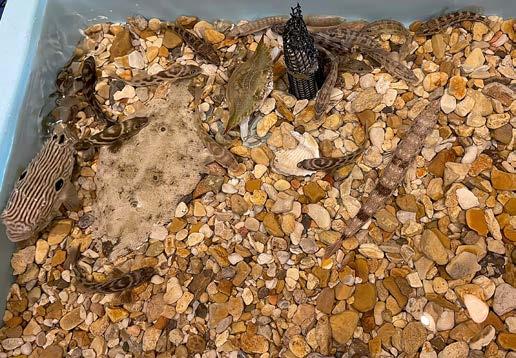
 BY CHRIS BLANKENSHIP Commissioner of the Alabama Department of Conservation & Natural Resources
BY CHRIS BLANKENSHIP Commissioner of the Alabama Department of Conservation & Natural Resources

Mark your calendars for May 10-12 for the inaugural EcoWild Outdoor Expo at the Mobile Convention Center on the banks of the Mobile River. The Alabama Department of Conservation and Natural Resources (ADCNR) has a designated area in the convention center to share information and fun activities about the four ADCNR divisions – Wildlife and Freshwater Fisheries, Marine Resources, State Parks and State Lands.
The ADCNR is proud to be a partner in this Expo adventure that showcases the Alabama Gulf Coast, where I grew up. Everyone who attends can meet our ADCNR Conservation Enforcement Officers, Park Rangers, Park Naturalists and biologists and find out how important their work is to the protection and conservation of Alabama’s abundant natural resources for today’s outdoor enthusiasts and future generations.
Partnering with organizations who host events like the EcoWild Outdoor Expo is crucial to the mission of ADCNR. As our population moves to more urban areas, we lose our connection to our natural resources and the numerous recreational opportunities that are available. ADCNR looks for unique ways, like the Expo, to spread the conservation message and encourage people to explore Alabama’s great outdoors, which is open to everyone.
The EcoWild Outdoor Expo is the brainchild of the folks at PMT Publishing and Mobile Bay Magazine, who have published magazines in Alabama for the past 40 years and are experts on everything that concerns the Alabama Gulf Coast. The Expo is designed to share the numerous opportunities to explore and enjoy our amazing natural resources in Alabama, especially the unique ecosystem of Mobile Bay and the Mobile-Tensaw Delta.
Visitors to the Expo can check out the Alabama Marine Resources Division touch tank .
64 May 2024 // GreatDaysOutdoors.com // 877.314.1237
ADCNR photo
EcoWild’s goal is to set the standard for this type of expo on the Gulf Coast by bringing outdoor enthusiasts the best in lifestyle gear, accessories and information as well as information on ecological initiatives that make our Gulf Coast such a special place. Visitors to the Expo can check out everything from outdoor activities and lifestyle vendors, educational sessions and guest talks, recreational exhibits, family-friendly activities, outdoor-themed art gallery, food trucks and more.
As the PMT Publishing team puts it, EcoWild is a full weekend devoted to updating your hunting and fishing gear, finding new activities, meeting outdoor lifestyle experts, and supporting conservation efforts to keep hunting, fishing, camping, boating and other outdoor activities ecologically balanced, safe, and accessible.
Stephen Potts said the Expo team was formed after realizing there was something missing on the Alabama Gulf Coast, where many people from Alabama and other areas come to visit and enjoy the outdoors.
“We see the enthusiasm for hunting and fishing and conservation around here,” Potts said. “We saw a gap where there wasn’t any kind of show like this in the area. We went and looked at events like SEWE (Southeastern Wildlife Exposition in Charleston, S.C.), and we thought we’d love to bring that to the Mobile Bay area.
“We want to make this an annual event and grow it into something really big that people are looking forward to and thinking about all year.”
Activities at the Expo include:
Butterfly House – Attendees can observe different species of butterflies while walking among them in this screened-in exhibit
Rock Wall – Challenge yourself and compete with friends as you scale a 26-foot-tall wall with all the gear needed to participate safely.
Touch Tanks – Aquatic species will be on display, including one from ADCNR’s Marine Resources Division with numerous saltwater creatures to observe and touch.
Junior Explorers – Young outdoor enthusiasts can experience outdoor education, displays and activities.
Art Gallery – See a curated collection of outdoor-themed paintings, sculptures and photographs.
Bees Exhibition – Watch live honey harvesting and check out an exhibition hive to learn more about how bees are so critical to our ecosystem.
Raptor Show – On Saturday of the Expo, expert handlers will display numerous majestic birds of prey.
Auburn Eagle – On Sunday of the show, the Auburn eagle will be on the Exhibit Hall Stage.
Axe Throwing – In the Grizzly Axes Booth in the Exhibit Hall, grab an axe and try to hit the bullseye.
Freedom Fidos – From shelter dogs to service dogs, this exhibit will showcase the training and learned skills of these canine partners.
Archery – Archery experts will be on hand to provide hands-on tips on improving your archery skills.
BB Gun Range – Firearm safety and basic marksmanship training are available at this indoor inflatable range.
Kids’ Fishing Tank – Young anglers can gather around the fishing tank and cast for the numerous fish that are swimming around.
BayMobile – Explore the wonders of the Gulf of Mexico and Alabama coastal waters without getting wet in this science classroom on wheels.
The Expo is presented by the Poarch Band of Creek Indians, the only federally recognized Tribe in Alabama. Kristin Hellmich, Director of External Communications for the Tribe, explained why the Tribe was interested in sponsoring the Expo.
“We have developed mutually beneficial relationships with Alabama communities to encourage service, education and development,” Hellmich said. “EcoWild Outdoor Expo matches our goals of local community economic expansion, as well as support for land and water conservation programs that impact all of us and our use of these resources, recreationally and otherwise. We look forward to working with the EcoWild team to celebrate outdoor activities in the beautiful Gulf Coast region and to educate the public about ways to keep Alabama and the Gulf Coast wild, accessible and safe.”
Visit https://ecowildexpo.com/ for more information and a link to purchase tickets. We’ll see you there.




FROM THE COMMISSIONER
visit us at www.pureflats.com Checkout special deals and promotions at Pure Flats.com… Shop – Specials & Promos for our latest deals and discounts. Specials & Promos 877.314.1237 // GreatDaysOutdoors.com // May 2024 65
R3 in Alabama and the National Symposium

Alabama is a leader in R3 throughout the country .
 BY CHARLES
BY CHARLES
Like many of our counterparts in other parts of the country, the Wildlife and Freshwater Fisheries Division (WFF) of the Department of Conservation and Natural Resources relies on hunting, fishing, and trapping license sales to provide state dollars to match with federal excise tax dollars to fund WFF and provide services to the citizens of our state.
License sales have been steadily declining throughout the country over the past decade or longer. Even in Alabama, we have experienced declining sales, especially when talking about fishing and trapping license sales. Hunting has been declining at a much slower rate than the other two, nevertheless, WFF has changed our way of doing business in hopes of stopping that
downward trend.
Over the years, I have written several articles on R3- the recruitment, retention, and reactivation of hunters, anglers, trappers, and recreational shooters-and what we are doing in Alabama to involve more people in those forms of outdoor recreation. WFF has created the Adult Mentored Hunting Program, Firearms 101 Program, Adult and Youth Trapping Education program, Go Fish, Alabama! Program, Campus Conservation Program, and many others.
Our Adult mentored hunting program just completed its seventh year and focuses on teaching new and inexperienced adults the skills they need to become hunters. This
“CHUCK” SYKES Director of the Alabama Division of Wildlife and Freshwater Fisheries (WFF)
66 May 2024 // GreatDaysOutdoors.com // 877.314.1237
program provides the instruction necessary to equip this new group of potential hunters to be successful and self-sufficient in the field. In addition to basic and advanced hunter safety education, participants learn how to scout, identify game sign, find places to hunt, utilize a firearm or archery equipment safely, ethical shot placement, field care, process game, and most importantly prepare and cook their harvested game.
In response to the major national surge in gun ownership the past several years and the interest in target shooting, the WFF Law Enforcement section designed and create the Firearms 101 Program. Classes are taught by the WFF law enforcement section’s certified instructors and focus on firearm safety and marksman ship. The classes are low stress and perfect for those who want to learn more about firearm safety, handguns, shotguns, or rifles in a safe environment from trained professionals focused on providing quality experiences for new or inexperienced firearms owners.
The Trapper Education Program is an outreach program that gives participants the opportunity to learn and experience an outdoor skill that was integral to the settlement of this county and remains a viable wildlife management method today. The workshop teaches participants about the historical aspect of trapping, biological information concerning furbearers and furbearer management, and proper techniques for trapping safely, legally, and ethically. This prepares them to implement their own trapping efforts as an effective wildlife management tool that positively benefits wildlife and ecosystems of all kinds.
The WFF Go Fish, Alabama! Program provides adults and families with little-to-no fishing experience an opportunity to fish under the guidance and instruction of a skilled fishing mentor. The program is for adults and families interested in learning how to fish, socializing outdoors with friends and family, putting fish on the dinner table, or simply enjoying the thrill and challenge of the catch. Each event is conducted in a safe, welcoming, and constructive environment. Families and individuals leave events with new skills that enable them to take advantage of the abundant fishing opportunities around Alabama.
The Campus Conservation Program was developed to increase engagement and involvement with colleges and universities around the state to include Community Colleges, Public and Private Institutions, Historically Black Colleges and Universities, Culinary Institutes, and Trade Schools. The CC Program aims to increase campus involvement, awareness, and participation in hunting, fishing, target shooting, trapping, and other outdoor recreation activities so students prioritize conservation throughout their careers and lives.
In Addition to recruiting, retaining, and reactivating participants, this program serves as an important recruitment tool for future agency employees and personnel. This is an effort to increase participation in outdoor recreation among college and university students and streamline their career path toward conservation -specific employment. The intent is to provide pathways for students to graduate and immediately enter conservation careers as a means of filling vacant positions with skilled and passionate individuals in agency roles.
These programs, along with several other efforts and initiatives, put Alabama at the forefront of the national R3 conversation. Thanks to that national attention, Council to Advance Hunting and the Shooting Sports (CAHSS) chose to host the National R3 Symposium in Mobile from May 29 through June 1. The National R3 Symposium is a
product of the CAHSS. The CAHSS’s mission is to facilitate the promotion and growth of hunting and the shooting sports and the education of the public on the contributions that hunters and shooters make toward wildlife conservation. It is the primary national advocate and leading facilitator of R3 work around the country. Alabama is proud to host this year’s National R3 Symposium, and we look forward to welcoming people from across the country to our beautiful state.
The National R3 Symposium made its debut in May 2018 in Lincoln, Nebraska, resulting in a groundswell of national focus and efforts to increase the recruitment, retention, and reactivation of participants in hunting, shooting sports, angling, and boating. After taking a few years off, the Council once again engaged the national community with the second symposium in 2022 in Broken Arrow, Oklahoma, and in 2023 in Albuquerque, New Mexico. This year’s symposium will grow on the success of past events and is primed to be the best one yet!
This year, participants can expect representation and participation from across the outdoor and conservation industry as well as from; national, state, and local agencies, and multiple conservation focused nonprofits, including the National Wild Turkey Federation, Ducks Unlimited, Delta Waterfowl, Rocky Mountain Elk Foundation, and The National Deer Association, to name a few.
So, if you work with a company that can benefit from increased participation in hunting, fishing, trapping, or recreational shooting or you just have an interest in knowing more about R3 and how you can help, go online at www.cahss.org and sign up for the symposium. We will see you there.
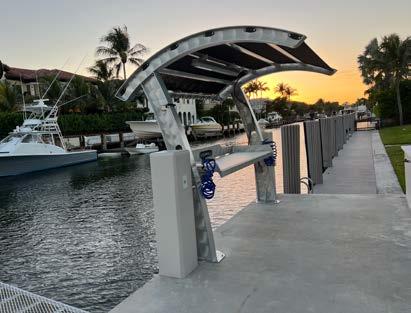




Made In The USA Built-In Hose Stations Ceramic Coated Aluminum WWW.KILLERDOCK.COM The greatest fish cleaning stations known to mankind. Table and Canopy Models Table widths from 42” to 90” King Starboard Cutting Surface (251) 207-1743 FROM THE DIRECTOR
877.314.1237 // GreatDaysOutdoors.com // May 2024 67
AL & NW Florida Saltwater Fishing Forecast
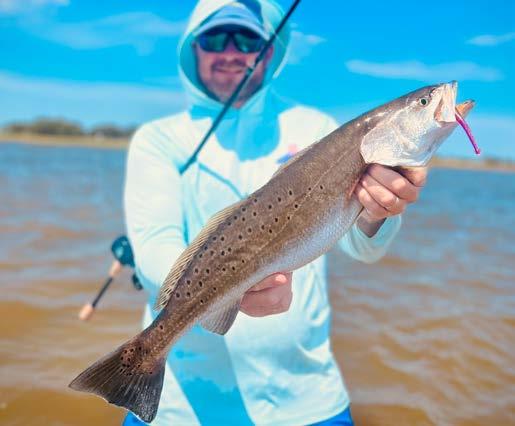

May is here, school is almost out for summertime break, and it’s time to hit the beach. Both air and water temperatures are continuing their warming trend and fishing should still be some of the best of the year. The diverse fishery of the Alabama Gulf Coast will have plenty to offer: Speckled Trout, Pompano, Tripletail, King Mackerel, Yellowfin Tuna, Swordfish, Grouper, and more. The mild weather is still allowing safe boating, and proper fishing conditions existing on the day of your trip is the only limitation to what’s possible in the Gulf of Mexico, Mobile Bay, and Mississippi Sound this time of year.
INSHORE
The barrier islands and beach fronts will be the place to be this month. Speckled Trout, Redfish, Flounder, Pompano, Spanish Mackerel and many other species will be roaming the surf. When they’re not cruising the waves the fish can be found making their way in and out of deep water troughs, deeper holes, posting up on sandbar points, and hanging out on slopes. These areas will consistently hold
bait, which leads to these spots consistently holding fish. Just like last month, the month of May still leaves a high potential for one of those trophy fish to show up.
Walking the beachfront, using the boat for wade fishing access, or even fishing some of these deeper areas out of the boat is the best way to approach these fish right now. When targeting Speckled Trout, Redfish and Flounder, live baits like Croaker, Menhaden and Finger Mullet are prime choices when rigged on bottom or freelined.
Catching these fish on artificial lures can be considered even more fun and rewarding by some. A good range of lures to have on hand right now are, topwater lures (Rapala Skitterwalk, Mirrolure She Dog, Heddon One Knocker), twitchbaits (Pure Flats Slick Lure, Paul Brown’s Corky, Yo-Zuri Inshore Twitchbait, Mirrolure MR17, MR18, MR27, MR28) and soft plastics/grubs (Coastal Brew Baits Dart, Down South Lures Super Model, Fishbites
BY TANNER DEAS
Photos by Tanner Deas
68 May 2024 // GreatDaysOutdoors.com // 877.314.1237
Butt Kicker/Brawler KWigglers Ball Tail).
Jack Crevalle and Pompano can also be targeted along the beaches. Large Mullet, Croaker or Menhaden are great live bait options for Jacks, but Tuna Poppers (Yo-Zuri Bull Pop, Yo-Zuri Mag Pop), Large Jerkbaits (Rapala X-Rap, Yo-Zuri LC Hydro Minnow) and XL Swimbaits (Z-Man Fishing Products SwimmerZ, 7” DieZel Minnow, Fishbites 6” Grub, NLBN) make for some major fun when targeting these world class fighting fish on artificial lures. Be sure to beef up from your traditional inshore gear when targeting Jack Crevalle. Although they may be had as bycatch when fishing for other species, a long fight can tire these fish out and inhibit them from a healthy release.
A healthy sized medium-heavy or heavy rod paired with a 4500-6000 size reel should be more than enough to enjoy the drag-screaming fun these fish have to offer, while still giving the angler the backbone and strength necessary to ensure the fight doesn’t last longer than needed for the fish. A good example of this setup is the Ugly Stik Tiger Elite rod paired with a Daiwa BG 5000, your choice of 30-50 pound braid, and anywhere from 40-100 pound leader.
When targeting pompano, you’ll want to stick to your traditional, lighter inshore gear; or bring out the surf rods and set rigs and catch them from a chair at the beach. Pompano can be caught on shiny and colorful banana jigs or pomp jigs, as well as on live shrimp, pieces of fresh dead shrimp, pieces of Fishbites, sand fleas, ghost shrimp, fiddler crab and occasionally on a twitchbait or grub. When targeting these fish from the beach, Frisky Fins set rigs and Sputnik weights along with Fishbites EZ Baits and Fishbites Fish’N Strips paired with ghost shrimp, sand fleas or fresh dead shrimp is the way to go. Rod holders are recommended for this style of fishing, and Surf Hippie Phishing makes the best sand spikes in the game!
Tripletail, also known as Blackfish, is another fish that can be on inshore anglers’ radars this time of year. These fish should be showing up more and more as the summer sets upon us, and are known to be a prized fish throughout Mobile Bay and the Mississippi Sound. These fish can be found associated with structure or floating on a tide line, and although a traditional center console can target these fish just fine, a tower boat has an extreme advantage when spotting these fish floating on channel markers, crab pot buoys, debris, or even dead fish carcasses.
Many baits work when targeting Tripletail, but there’s nothing better than a live shrimp; either free lined in front of the fish’s face or under a slip cork when targeting those fish subsurface. When fishing heavy structure, anglers may want to beef up their set up with these fish as well, and go with something similar to what was mentioned for the Jack Crevalle earlier; maybe not quite as heavy on the rod, but still a size 4000-5000 reel.
NEARSHORE:
Spanish Mackerel and King Mackerel should be in good numbers further off the coast. Mackerel range anywhere from by the beach to way offshore, but seem to average about 15-100’ in depth. The best way to find these fish is associated with nearshore structures and bait schools. King Mackerel can be had multiple different ways. When trolling; bump-trolling live baits, trolling spoons, diving plugs, and duster/cigar minnows at 3-5 knots works best.
Local Captain and commercial fisherman, Capt. Cody Broughton says, “The best way to do it is to bump-troll live baits on a wire or cable stinger rig with three or so feet of wire or cable. Two hooks give you a better chance of sticking a fish when you’re doing the bump trolling. You can troll a couple of high baits further up in the water column, and you can put a couple on a down rigger to get two more baits further down in the water column and heighten your chances of getting a fish by covering more water at different depths.”
Capt. Broughton goes on to say another one of his favorite methods is live bait chumming.
“If you can get enough live baits to black out the well, and go out there throwing those things around, you will get them going nuts. As soon as that bait goes out there amongst the chum, it seems like the take is almost instant.”
Cody went on to specifically mention live hardtails, cigar minnows and small bonito as his favorite baits.
When asked about setups, Cody said, “We use 6’6” to 7’ Star Rods, paired with Shimano Speed Master 16s Lever Drag with 18-20 pounds of drag and sixty pound braid.”
If you’d like to get in touch with Capt. Cody about King Mackerel or other saltwater species, give him a call at 251-753-1077, or find him at “Cody Broughton” on Facebook and Instagram. You can also shoot him an email at Codybroughton427@gmail.com.
When casting on these fish, especially Spanish Mackerel, a spoon or shiny lure with a light wire leader to prevent breakoffs from those razor sharp teeth will work well. When working a lure for these fish, cadences may vary, since Spanish Mackerel are capable of reaching speeds upwards of 20 mph, and King Mackerel are capable of reaching 40 mph. It’s almost impossible to work it too fast for mackerel!
Another casting method is to fish light wire leaders and freeline live shrimp or small menhaden amongst large bait schools or near structures. This method is very consistent for Spanish Mackerel and these fast, drag peeling fish make for a special time on light, inshore tackle. King Mackerel can also be targeted by floating a live or dead bait out behind the boat under a large buoy or balloon. Be sure to turn the drag clicker on and secure the rod because when that bait gets eaten, that drag will start smokin’ and the fish will be off to the races. When using this method, sharks can be a common bycatch, as can Cobia, one of the most delectably delicious species that the Gulf of Mexico has to offer.
Cobia fishing should be on the rise as May progresses on to full summer. Nearshore gas rigs and structures like ships anchored up for port attract high numbers of baitfish and other life that makes for a perfect pit stop for these migrating Cobia to grab a meal. These fish can be targeted with live baits like Croaker, Menhaden, Crazy Fish, Cigar Minnows, Hardtails, even Catfish. Freelining or fishing on bottom with live baits seems to both work well depending on where those fish are in the water column. Bucktail Jigs and other feather jigs rigged with curly tails like the Fishbites 6” Grub are also a popular way to target Ling.
OFFSHORE:
Offshore continues to offer a plethora of species to harvest, and the weather will hopefully offer several windows that allow anglers safe access to the beautiful offshore fishery. Mangrove, Lane, and Vermilion Snapper will be on the artificial reef structures as well as Triggerfish.
Triggers, Lane, and Vermilion Snapper are best caught on two hook rigs with a small piece of squid or fresh cut bait. Vary your presentation depths until you find the species or desired size of fish that you’d like to find. There are multiple different tiers and layers of fish on the reef structures, and sometimes larger fish or different species are at different depths and areas on the reef.
Mangrove Snapper are best targeted by chumming and freelining with light leader, sometimes even down to 30 pound test. These Mangroves have proven themselves to be the smartest fish on the reef. They sometimes take some extra work and chumming to get them going, but once fired up, a good mangrove bite leads to some fun memories and an amazing harvest.
Further out, Tuna, Wahoo, Mahi-Mahi and billfish species will move in around debris, structures, and offshore platforms, as well as other popular bottom structures, such as The Spur and The Steps. It seems like the Yellowfin Tuna have been really dialed in on swimbaits (Z-Man Fishing Products Mag SwimZ, NLBN Tuna 4X), poppers (Yo-Zuri Bull Pop, Yo-Zuri Mag Pop) and jigs (Johnny Jigs Tuna Teaser, JygPro WYLD), be sure to be properly rigged out and ready for any scenario whether that be live bait, chunking, trolling or with lures to guarantee yourself the best chance to bring home a trophy fish.
Check Hilton’s Realtime Navigator for all of the latest water conditions, and use that amazing tool to help you determine the best direction to head when going offshore for billfish, tuna and wahoo. Hilton’s can also be useful to help you find new bottom structure to target when bottom fishing. The FADs will be holding Wahoo, Mahi-Mahi and billfish this time of year as well. Success can be found by trolling baits like Ilanders Lures, Yo-Zuri Bonito, jet heads, and chuggers as slow as 5-6 knots and as fast as 15-17 knots.
FISHING FORECAST
877.314.1237 // GreatDaysOutdoors.com // May 2024 69
Pier & Shore Fishing Outlook

Spanish mackerel are the most popular species for Panhandle pier anglers in May
.
Surf zones and back bays along the Alabama and Mississippi coast abound with speckled trout in May, as do the
lower bays in the Florida Panhandle .
 BY DAVID THORNTON
BY DAVID THORNTON
May signals the end of meteorological spring along the Emerald Coast as the weather gets progressively warmer and more humid. Gulf waters are warming through the upper 70s to around 80 by Memorial Day, making wading a viable activity. Not just surf casting in the Gulf, but wade fishing the back bays for speckled trout, redfish, and flounder are great pastimes that can include the whole family. While live shrimp are productive, the numbers of non-game, shrimp-eating species are getting very active. So, throwing lures is often more productive by allowing anglers the freedom to walk and wade to cover more water when searching for fish.
Neap tides will influence fish feeding activity around the middle and end of May, while the rest of the month basks with midday
high tides and longer daylight hours to enjoy available fishing options. Of course the daily weather is often the biggest factor influencing fishing, and we may well experience some blowing, rainy periods. But more often than not, clear weather with light winds prevail to aid the cause for fishermen to be successful.
Baitfish like cigar minnows, sardines, and herring are moving into shallower, warmer coastal waters en masse to spawn. The gamefish know this, especially pelagic species like spanish and king mackerel, jack crevelle, cobia, little tunny (bonita), and even tarpon (soon). Vast shoals of baitfish collect around the gulf beach piers to feed on abundant plankton, spawn, and seek refuge from the marauding gamefish. These fat and happy baitfish are the main
Photos by David Thornton
70 May 2024 // GreatDaysOutdoors.com // 877.314.1237
course for predators of all sizes including bluefish, ladyfish, redfish, plus the mackerels, plus other species. The outlook is good at press time, the pier at Pensacola Beach (damaged by huge waves from hurricane Sally in September 2020) will be open in May. But call ahead to check on the status. Meanwhile Alabama anglers will not be so fortunate, as repairs to the more heavily damaged Gulf State Park Pier will likely continue through the summer.
In the past, pier anglers simply snagged or gold hooked a live baitfish on light tackle, reeled it up and stuck it on a heavier combo to cast out past the edge of the school to catch gamefish. Live-lining bait is still a productive method for fishing to target king mackerel with bycatch of the other species, including late season cobia. But in recent years, repeatedly casting medium sized artificial plugs has made inroads into this fishery, adding more action and personal involvement for anglers. There are still plenty of “snobblers” too. Anglers who cast out a dead bait, hooked through the nose, let it sink, and then work it back to the pier. This action of making a dead bait look like a dying bait is often so irresistible to gamefish they may be reluctant to strike other offerings.
Large schools of spanish mackerel, bluefish, ladyfish (skipjack), and blue runners (hardtails) constantly migrate east to west just outside the longshore sandbar. They turn southward to swim around the pier, giving a lot of pier fishers strung out along the east facing rail a chance to cast to them. These fish respond well to a variety of small lures like the aptly named Gotcha plugs. That has two very sharp treble hooks, which sometimes catches fishermen as well as fish. A single hook leadhead jig is often just as, if not more effective to catch fish, and much safer for the angler. Plus fewer fish are foulhooked, facilitating unhooking the fish to drop in the cooler or release overboard. Using needle-nosed pliers not only makes the unhooking process safer, it makes releasing unwanted fish faster and less messy. Just grab the base of the hook, and with a twist of the wrist the fish falls off without even touching it. Discarding bycatch in this manner is much healthier and better for the fish to avoid knocking off scales and protective slime that cause infections and predation from sharks and dolphins. Throwing back dead or critically injured bycatch is strong positive reinforcement for these awaiting predators and makes them hang around the pier, taking even more fish while scaring away others, a very frustrating process for fishers.
Farther inshore, whiting and pompano are the main target species for anglers. These can be sightcast to with jigs or bait when the water is clear and calm enough to see them. The fish itself isn’t always seen, but the shadow it casts contrasts with the white sandy bottom making the fish and its movements more obvious, especially on a sunny day. Sometimes it is more difficult to see the fish distinctly, and other species such as mullet, a vegetarian fish may be confused with target fish. But with a little experience, and perhaps answers from other anglers can help improve your ability to tell them all apart.
Surf casting options from shore still abound in May though numbers of pompano are decreasing from last month’s seasonal high, as more of them move out of the surfzone to spawn offshore. There are enough to target though, along with plenty of whiting (Gulf and Northern kingfish). Depending on the weather and water conditions, these fish may be feeding close to shore, or holding farther out near the longshore sandbar.
Besides using set lines to target pompano, the Gulf waters are now warm enough to wade and cast pompano jigs for them. Of course there are a lot of bycatch species such as small jacks, plus some toothy species like bluefish and spanish mackerel which can bite through light line without a 30 pound mono or fluorocarbon leader. Such is the price we pay to play sometimes. Though that is when another lure, the so-called Goofy jig can be quite effective when it
is hopped along the bottom. The jig can even be sweetened with a piece of fresh shrimp or a short strip of Fishbites. Still, pompano often strike the free swinging fly, and even doubles (two fish at a time) are possible with this set up.
A similar rig with a Gulp shrimp on a weighted jig head and a second Gulp Shrimp unweighted on a 4/0 long shank bass hook can be very effective when slowly jigging for flounder or redfish around hard or soft structures. They work well around pier pilings, along seawalls or jetties, as well as parallel to sandbar drop offs when wade fishing near shore. When fished properly, just a slight twitch of the rodtip sends the unweighted shrimp up off the bottom where a flounder or other gamefish might see it and strike.
Surf zones and back bays along the Alabama and Mississippi coast abound with speckled trout in May, as do the lower bays in the Florida Panhandle. Calm mornings provide excellent conditions to throw top water lures like Heddon Spooks and Rapala Skitterwalk to locate feeding trout along drop offs. The barrier islands from Dauphin Island to Horn Island offer anglers excellent wading opportunities. As the sun rises, specks often settle deeper into the water column, but may still feed on subsurface walkers or jerk baits. MirrOlure’s MR 18, Heavy Dine is an excellent example of a twitchbait that reaches these suspended fish as well as the 52M series. They resemble small menhaden, LYs and mullet beach hugging speckled trout trout and other gamefish are actively seeking. Look for deep troughs or “holes” (3 to 6 feet deep) just off the beach to the beach sandbar.
With warmer conditions and such a cornucopia of species and venues to choose from, options abound for pier and shore anglers in May as they enjoy their great days outdoors!

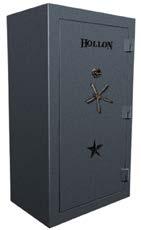



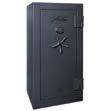

FISHING OUTLOOK WE SERVICE ALL BRANDS OF GUN SAFES BUT... WE PROUDLY
HOLLON GUN SAFES (251) 479-5264 457 Dauphin Island Parkway “At the Loop” Mobile, AL 36606 WE SERVICE ALL BRANDS OF GUN SAFES BUT... WE PROUDLY SELL ONLY HOLLON GUN SAFES (251) 479-5264 457 Dauphin Island Parkway “At the Loop” Mobile, AL 36606 WE SERVICE ALL BRANDS OF GUN SAFES BUT... WE PROUDLY SELL ONLY HOLLON GUN SAFES (251) 479-5264 457 Dauphin Island Parkway “At the Loop” Mobile, AL 36606 ON SALE NOW! 20% OFF ALL GUN SAFES IN STOCK. Ends 7/4/2024 877.314.1237 // GreatDaysOutdoors.com // May 2024 71
SELL ONLY
REGIONAL FRESHWATER
Fishing Outlook
BY ED MASHBURN
 Photos by Ed Mashburn
Photos by Ed Mashburn
72 May 2024 // GreatDaysOutdoors.com // 877.314.1237
Big bass will be off the beds and feeding up to recover from spawning .
Here in the Deep South, May is one of the finest months for fishing- both for the fish and for the anglers chasing them. The weather is usually settled and pleasant, and the fish are feeding to recover from their spawning duties of early spring.
We have some advice and directions from some of the best anglers in this region- let’s see what they can tell us.
ALABAMA WATERS
SIPSEY FORK
Randy Jackson of Riverside Fly Shop told us the trout bite at Sipsey Fork will, as always, be weather related, and if typical spring weather occurs, a caddis fly hatch will come off in May, and also lots of terrestrial bugs, especially ants, will be on the trouts’ menu.
Toward the end of May going into June, the first mayfly hatch should come off, and these will be larger mayflies. Dry fly fishing should be quite good.
Anglers can target the size of trout they seek by focusing on different parts of the river. Up close to the dam, the oxygen levels are higher and there are lots of smaller bugs, and the trout tend to be smaller and somewhat easier to catch. As anglers move downstream away from the dam, the trout tend to get larger, more like wild trout, and they eat larger bugs. At any point along the river, anglers can expect to catch trout from nine to sixteen inches long, with the bigger fish farther downstream.
If the skipjacks come up to the dam in good numbers this year, they should still be around in May, and they are loads of fun to catch on flashy, fast-moving flies.
Jackson said that Riverside Fly Shop carries a huge assortment of flies for anglers to select, and as a help in the choice, flies which have been productive recently are marked with orange tags.
To make trip planning easier for anglers, the generating schedule for the Smith Dam is posted every day on the Riverside Fly Shop website, or a call to the shop will provide current conditions.
LAKE EUFAULA
Big old Lake Eufaula can be a tough nut to crack for visiting anglers, but a veteran can make the fishing here much easier. Captain Sam Williams, long-time guide and veteran Eufaula angler, says that the topwater bite for bass at Eufaula should be very good in May. The frog bite in particular should be good. Fish around the grass and other growing structure. Don’t be afraid to throw a weedless frog into the roughest cover possible- some big bass will be up in the shallows.
In general at Eufaula in May, bass anglers need to start each day with gold colored lures. For whatever reason, Eufaula bass seem to prefer gold colored lures.
Crappie can be very good in May at Eufaula. Anglers can find the slabs with small jigs in a wide range of colors. Start with chartreuse, and then work other colors to see which color the crappie prefer on particular days.
It’s always a good day to go cat fishing at Eufaula, and May is one of the best months for catfish. Big chunks of cut bait fished on the bottom where feeder creeks run into the main lake are great spots to find some big cats.
WEISS LAKE
Captain Lee Pitts said, “May is about the tail end of crappie spawning, and this means that we’ll be shooting deeper docks as the crappie pull off their shallow water spawning waters and head out toward deeper open water.”
For about two weeks in May, the crappie will be stacked up under certain docks. Anglers may have to look around a bit to find the best deep docks, but when located, the crappie will be thick.
For bass anglers at Weiss Lake, May is a great time to be on the water.
Pitts told us that May is the kickoff of a great spinner bait bite. Also, the top water bite will really get going.
The bank grass at Weiss along the shallows will hold lots of bass, and Pitts said that anglers can catch bass just about anywhere on topwater lures- especially soft plastic frogs.
There will be hot jig and trailer bite on the grass, too. Pitts recommends the Gene Larue Wheeler Punchout Craw as a trailer on jigs.
In May, bass anglers can’t go far wrong by fishing very shallow water. The bass will be found in water much shallower than most anglers think possible. When the trolling motor starts throwing up mud, the angler is getting in good territory for Weiss Lake bass.
LAKE GUNTERSVILLE
Veteran guide Captain Jake Davis said that in the middle and later parts of the month, the shad will start their spawn, and this really gets the bass feeding. Throwing light colored willow leaf spinner baits over the flats where the shad gather to spawn is a good bet. Bass will be found on the main channel docks, and emerging grass beds will be places to find bass on the feed.
For the top water bait, anglers can try buzz baits or Spooks. Throw over emerging grass or along weedlines for good top water action.
The middle sections of the lake should be very good. The Goose Pond area can be hot in May.
Crappie will be back in the deeper creek mouths, and anglers looking for some real light tackle fun can find big shell crackers bedding up on deeper hard bottom areas and shell banks.
LAKE WILSON/PICKWICK LAKE
Big catfish specialist Captain Brian Barton tells us that catfish will be feeding heavily in the days leading up to their spawning. Fish can be caught from 2 to 70 feet of water this month depending on where you want to fish. To locate shallow fish, check out logjams in cuts along the main river bank on both sides of the river. Logs stack in the backs of these pockets and cats seek their cover for spawning. Barton said, “I fish these areas by rigging spinning tackle with 14 lb Vicious mono and a 3/0 Mister Twister Keeper red worm hook. I place a 1/16 or 1/8 oz sinker about 8 to 10 inches under the hook creating a dropshot rig.”
Barton advised that anglers should cast your bait up against or just under the floating logs and hold steady keeping a tight line. Worms, shrimp, shad, and skipjack all work well with this application. For larger fish, seek out 15 to 40 feet of water in the mid to
FISHING OUTLOOK
877.314.1237 // GreatDaysOutdoors.com // May 2024 73
Some extra large bluegills can be found in May

rear potions of sloughs on the south end of the lake.
Pickwick Lake, like Wilson, will be hot for cats throughout the month. Fish will be on top of and along river ledges as well as the tops and backs of humps and mounds in the river channel. Blues will be staging heavily at the base of Wilson Dam this month.
It’s not uncommon for local anglers to catch 50 to 75 fish each day along the tailrace. Eddy pockets and any slack water areas downstream of the dam are likely to be holding cats.
Barton said, “A favorite spot of mine this month is to fish the knees of cypress trees from Seven Mile Island downstream to the Sinking Creek area. Channel cats will often load up in droves under these trees for spawning. I cast worms, prepared baits, or chicken livers underneath the trees to catch the fish.”
MILLER’S FERRY
Joe Dunn knows the fishing at Miller’s Ferry quite well, and he told us that the crappie will be out of bedding areas and in five to twelve feet of water. Crappie can be caught on Road Runners and tube jigs vertically jigged around stumps and other wood cover. Many of the crappie will be taken on drop-shot rigs baited with live minnows out on the main river channels. Trolling the larger creeks will produce crappie in May if the angler uses live minnows and jigs.
Bass at Miller’s Ferry will be off the beds by May, and anglers should look around shallow grass with spinner baits. Major lake channels will be hot for bass when fished with crank baits and soft plastics on Carolina rigs.
A key point for Miller’s Ferry anglers looking for success is to try and plan trips around moving water. When the dam is releasing water and there’s some current in the lake, the bass just bite better. Anglers can call the Miller’s Ferry powerhouse at 334-682-
4896 to get water release schedules for each day.
FLORIDA WATERS
LAKE TALQUIN
Jeff DuBree of Whippoorwill Lodge on Lake Talquin says that the bream fishing will be very good as the bream really get going on the spawning beds in shallow water. For both bluegill and shell crackers, anglers who throw Beetlespins on light tackle will have success. Live crickets always work for bream here. Working the bream on full moon times can be very effective.
DuBree told us, “The bass will be post spawn in May, and there will be some schooling action. Bass anglers will want to fish main lake points early and late. The bass will move into deeper water in May, and anglers can catch them on crank baits and jigs if they work the sandy points.”
The white bass in Talquin will still be scattered, and anglers can look for diving birds which will show where whites are chasing shad in open water. Make a quick run to the birds and throw shadlook lures into the feeding area, and the whites will respond.
Catfishing on Talquin will be good in May. Using stink bait and pond worms, anglers can expect some good eating size catfish. Work water in six to twelve foot depths for best catfish action in May.
APALACHICOLA RIVER SYSTEM
Tony Poloronis of Outcasters Bait and Tackle in Apalachicola gave us some good tips for May fishing in the river system there.
First, a lot of the saltwater fighters such as redfish, trout, and flounder will be making their way up the river past the town of Apalachicola, and freshwater anglers should not be surprised to find these fish taking lures and bait sent for freshwater fish.
Regional Freshwater Fishing Outlook
. 74 May 2024 // GreatDaysOutdoors.com // 877.314.1237
Poloronis told us that bass anglers will find some good bass near cover using soft plastics, spoons with some flash, and especially Snagless Sally spinners. These should be worked close to the cover. If an angler can find some large minnows or shiners, the bass will jump all over them.
Shellcrackers will still be on the beds in places in the backwaters, but many of the big bream will have pulled back to deeper open water. Live worms are good when fished near the bottom.
SEMINOLE LAKE
Catfish anglers can fish drop off sand ledges where the catfish will collect in ten to twelve foot water after their spawning is complete. All kinds of live bait and prepared stink bait will work on the cats in May.
Captain Matt Batty, a long-time bass tournament angler and guide, told us,” Bass fishing is good. The fish are mostly post-spawn with some fish still spawning. There is also a shad spawn going on all over the lake. Target main lake grass lines with a ½ oz. Buddha Blade in sexy shad- the new one with serrated blades puts out more flash and seems to attract more strikes.”
Batty continues, “Also, a 3/8 oz. Buddha Bait buzz bait in white with silver blade works well for early morning top water shad spawn bites.”
There are also fish suspended in the timber in Spring Creek. Use a Lowrance Down Scan to locate schools of bass suspended next to stumps in the creek. A good bait to catch the suspended bass is a five-inch Big Bite Baits Suicide Shad in pearly shad pattern.
Important Contact Information
Joe Dunn Dunn’s Sports 334-636-0850
33356 Hwy 43, Thomasville, AL
Captain Sam Williams Hawks Guide Service 334-687-0400
Brandon Jackson/ Randy Jackson Riverside Fly Shop 17027 Hwy 69N Jasper, AL 256-287-9582
Riversideflyshop.com
Captain Lee Pitts 256-390-4145
www.leepittsoutdoors.com
Captain Brian Barton 256-412-0960
brianbartonoutdoors.com
Captain Jake Davis Mid-South Bass Guide Service 615-613-2382
msbassguide@comcast.net
Jeff DuBree Whippoorwill Sportsman’s Lodge Lake Talquin 850-875-2605
fishtalquin@gmail.com
Captain Matt Baty 229-726-0153
bassinboots@yahoo.com
Tony Poloronis Outcasters Bait and Tackle 631 Hwy 98, Apalachicola, Florida 850-653-4665
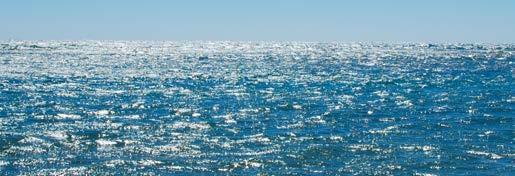
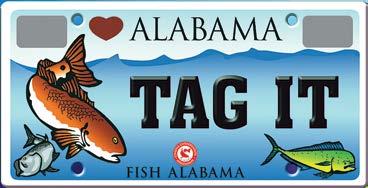
Regional Freshwater Fishing Outlook
Show Your Support for Alabama’s Coastal Fishing & Marine Resources. All proceeds from your TAX DEDUCTIBLE purchase are used for marine conservation in Coastal Alabama. For more info on the events or CCA Alabama www.ccaalabama.org 251-478-3474 877.314.1237 // GreatDaysOutdoors.com // May 2024 75
PRIME FEEDING TIMES Mobile / Tensaw Delta
This chart is specifically designed for fishing times in the Mobile/Tensaw Delta & other tidally influenced waters of South Alabama.
May 2024
Date Day
MOON TIMES
This chart is specifically designed for game movement for the state of Alabama & fish feeding times in non-tidal waters in the state. Inclement weather or rapidly changing temperatures can adversely affect feeding times. Moon Over & Under is the best feeding times for game animals & fish in non-tidal waters
May 2024
Shaded areas represent best days during the month.

30 Days 12.8 31 Days 12.4 K L L a b c d e e g j k l m n A B C D E F G H I J K L L a b c d e e g h i j k l m n n o p q r s t u v w x y z ; W Th F Sa S M T W Th F Sa S M T W Th F Sa S M T W Th F Sa S M T W Th F 1 2 3 4 5 6 7 8 9 10 11 12 13 14 15 16 17 18 19 20 21 22 23 24 25 26 27 28 29 30 31 1:59 AM 2:37 AM 3:12 AM 3:43 AM 4:13 AM 4:45 AM 5:20 AM 5:58 AM 6:43 AM 7:34 AM 8:32 AM 9:33 AM 10:35 AM 11:37 AM 12:35 PM 1:31 PM 2:25 PM 3:20 PM 4:14 PM 5:11 PM 6:10 PM 7:12 PM 8:15 PM 9:19 PM 10:18 PM 11:12 PM 11:59 PM --:-12:38 AM 1:13 AM 1:45 AM 7:09 AM 8:03 AM 8:54 AM 9:43 AM 10:33 AM 11:23 AM 12:17 PM 1:13 PM 2:11 PM 3:11 PM 4:10 PM 5:06 PM 5:57 PM 6:45 PM 7:28 PM 8:09 PM 8:48 PM 9:27 PM 10:07 PM 10:48 PM 11:33 PM --:-12:21 AM 1:14 AM 2:11 AM 3:10 AM 4:09 AM 5:05 AM 5:59 AM 6:50 AM 7:38 AM 12:23 PM 1:33 PM 2:42 PM 3:51 PM 5:00 PM 6:10 PM 7:22 PM 8:34 PM 9:44 PM 10:48 PM 11:44 PM --:-12:31 AM 1:10 AM 1:43 AM 2:11 AM 2:36 AM 3:01 AM 3:25 AM 3:50 AM 4:17 AM 4:48 AM 5:25 AM 6:08 AM 7:01 AM 8:01 AM 9:07 AM 10:16 AM 11:25 AM 12:32 PM 1:39 PM 7:36 PM 8:28 PM 9:18 PM 10:08 PM 10:58 PM 11:50 PM --:-12:44 AM 1:42 AM 2:41 AM 3:41 AM 4:39 AM 5:32 AM 6:21 AM 7:07 AM 7:49 AM 8:29 AM 9:07 AM 9:47 AM 10:27 AM 11:10 AM 11:57 AM 12:47 PM 1:42 PM 2:40 PM 3:40 PM 4:37 PM 5:33 PM 6:25 PM 7:14 PM 8:02 PM PHASE Date Rise Over Set PHASE Date Rise Over Set Under
MOON & FEED TIMES
1 2 3 4 5 6 7 8 9 10 11 12 13 14 15 16 17 18 19 20 21 22 23 24 25 26 27 28 29 30 31 Wed Thu Fri Sat Sun Mon Tue Wed Thu Fri Sat Sun Mon Tue Wed Thu Fri Sat Sun Mon Tue Wed Thu Fri Sat Sun Mon Tue Wed Thu Fri ★ ★★ ★★ ★★★ ★★ ★★ ★★★★ ★★★★ ★★★★ ★★★★ ★★★ ★★★ ★★ ★ ★ ★★ ★★ ★ ★ ★ ★★ ★★ ★ ★★ ★★★ ★★★ ★★ ★★ ★ ★ ★ 76 May 2024 // GreatDaysOutdoors.com // 877.314.1237
Fort Morgan
Fort Morgan
Mobile River
Perdido Pass




W Th F S Su M T W Th F S Su M T W Th F S Su M T W Th F S Su M T W Th F 03:08 PM / 0.93 04:00 PM / 0.76 09:07 AM / 0.43 08:18 PM / 0.61 09:01 AM / 0.57 09:25 PM / 0.49 09:18 AM / 0.74 09:34 AM / 0.91 09:28 AM / 1.06 09:31 AM / 1.18 10:00 AM / 1.23 10:38 AM / 1.22 11:22 AM / 1.17 12:09 PM / 1.08 12:56 PM / 0.98 01:43 PM / 0.86 02:29 PM / 0.73 03:01 PM / 0.60 08:40 AM / 0.45 01:46 PM / 0.46 08:01 PM / 0.47 08:29 AM / 0.56 09:04 PM / 0.40 08:47 AM / 0.68 09:03 AM / 0.78 08:24 AM / 0.89 08:31 AM / 1.02 09:00 AM / 1.12 09:34 AM / 1.20 10:15 AM / 1.23 11:03 AM / 1.23 11:54 AM / 1.18 12:44 PM / 1.08 01:34 PM / 0.93 02:19 PM / 0.72 12:59 PM / 0.50 02:06 AM / -0.13 02:38 AM / -0.02 02:59 AM / 0.13 11:24 AM / 0.42 01:30 AM / 0.28 05:01 PM / 0.29 01:11 AM / 0.37 05:49 PM / 0.06 06:28 PM / -0.13 07:11 PM / -0.25 08:06 PM / -0.29 09:57 PM / -0.29 11:17 PM / -0.28 12:20 AM / -0.23 01:15 AM / -0.17 02:03 AM / -0.09 02:43 AM / 0.02 03:15 AM / 0.14 02:43 AM / 0.28 11:29 AM / 0.43 05:47 PM / 0.40 12:09 AM / 0.35 06:08 PM / 0.26 11:11 PM / 0.37 06:17 PM / 0.13 06:18 PM / 0.01 06:37 PM / -0.09 07:04 PM / -0.16 07:40 PM / -0.20 08:51 PM / -0.22 10:23 PM / -0.24 11:17 PM / -0.24 12:00 AM / -0.21 12:34 AM / -0.12 12:56 AM / 0.01 11:41 PM / 0.17 11:24 PM / 0.26 1 2 3 4 5 6 7 8 9 10 11 12 13 14 15 16 17 18 19 20 21 22 23 24 25 26 27 28 29 30 31 PRINT, DIGITAL OR BOTH! SUBSCRIBE... 1) CALL 877.314.1237 2) ORDER ONLINE AT GREATDAYSOUTDOORS.COM Hunting & Fishing in Alabama & the Florida Panhandle GET YOUR SUBSCRIPTION TODAY! ALABAMA TIDE CHARTS
W Th F S Su M T W Th F S Su M T W Th F S Su M T W Th F S Su M T W Th F 04:31 PM / 1.54 05:23 PM / 1.33 06:45 PM / 1.05 11:46 AM / 0.83 11:24 PM / 0.86 10:36 AM / 0.96 09:41 AM / 1.21 09:51 AM / 1.45 10:26 AM / 1.62 11:09 AM / 1.71 11:57 AM / 1.74 12:50 PM / 1.71 01:44 PM / 1.66 02:35 PM / 1.57 03:19 PM / 1.44 03:55 PM / 1.27 04:19 PM / 1.07 11:31 AM / 0.92 10:14 AM / 0.96 09:15 AM / 1.10 09:06 AM / 1.26 09:23 AM / 1.40 09:52 AM / 1.52 10:30 AM / 1.61 11:13 AM / 1.68 12:01 PM / 1.74 12:52 PM / 1.77 01:44 PM / 1.77 02:33 PM / 1.68 03:19 PM / 1.52 03:58 PM / 1.27 04:23 PM / 0.96 04:01 AM / -0.11 04:45 AM / 0.01 05:16 AM / 0.23 05:10 AM / 0.50 04:39 PM / 0.71 03:59 AM / 0.74 06:46 PM / 0.41 07:45 PM / 0.17 08:39 PM / -0.01 09:41 PM / -0.09 10:57 PM / -0.12 12:16 AM / -0.11 01:21 AM / -0.08 02:12 AM / -0.03 02:53 AM / 0.05 03:21 AM / 0.17 03:29 AM / 0.32 03:12 AM / 0.49 02:27 AM / 0.63 07:58 PM / 0.59 07:23 PM / 0.40 07:40 PM / 0.24 08:10 PM / 0.11 08:50 PM / 0.02 09:42 PM / -0.05 10:47 PM / -0.12 11:54 PM / -0.17 12:50 AM / -0.21 01:37 AM / -0.18 02:15 AM / -0.08 02:40 AM / 0.11 02:35 AM / 0.36 1 2 3 4 5 6 7 8 9 10 11 12 13 14 15 16 17 18 19 20 21 22 23 24 25 26 27 28 29 30 31
W Th F S Su M T W Th F S Su M T W Th F S Su M T W Th F S Su M T W Th F 04:31 PM / 1.54 05:23 PM / 1.33 06:45 PM / 1.05 11:46 AM / 0.83 11:24 PM / 0.86 10:36 AM / 0.96 09:41 AM / 1.21 09:51 AM / 1.45 10:26 AM / 1.62 11:09 AM / 1.71 11:57 AM / 1.74 12:50 PM / 1.71 01:44 PM / 1.66 02:35 PM / 1.57 03:19 PM / 1.44 03:55 PM / 1.27 04:19 PM / 1.07 11:31 AM / 0.92 10:14 AM / 0.96 09:15 AM / 1.10 09:06 AM / 1.26 09:23 AM / 1.40 09:52 AM / 1.52 10:30 AM / 1.61 11:13 AM / 1.68 12:01 PM / 1.74 12:52 PM / 1.77 01:44 PM / 1.77 02:33 PM / 1.68 03:19 PM / 1.52 03:58 PM / 1.27 04:23 PM / 0.96 04:01 AM / -0.11 04:45 AM / 0.01 05:16 AM / 0.23 05:10 AM / 0.50 04:39 PM / 0.71 03:59 AM / 0.74 06:46 PM / 0.41 07:45 PM / 0.17 08:39 PM / -0.01 09:41 PM / -0.09 10:57 PM / -0.12 12:16 AM / -0.11 01:21 AM / -0.08 02:12 AM / -0.03 02:53 AM / 0.05 03:21 AM / 0.17 03:29 AM / 0.32 03:12 AM / 0.49 02:27 AM / 0.63 07:58 PM / 0.59 07:23 PM / 0.40 07:40 PM / 0.24 08:10 PM / 0.11 08:50 PM / 0.02 09:42 PM / -0.05 10:47 PM / -0.12 11:54 PM / -0.17 12:50 AM / -0.21 01:37 AM / -0.18 02:15 AM / -0.08 02:40 AM / 0.11 02:35 AM / 0.36 1 2 3 4 5 6 7 8 9 10 11 12 13 14 15 16 17 18 19 20 21 22 23 24 25 26 27 28 29 30 31
W Th F S Su M T W Th F S Su M T W Th F S Su M T W Th F S Su M T W Th F 06:17 PM / 1.92 07:09 PM / 1.66 08:31 PM / 1.31 01:32 PM / 1.04 01:10 AM / 1.07 12:22 PM / 1.20 11:27 AM / 1.51 11:37 AM / 1.81 12:12 PM / 2.02 12:55 PM / 2.14 01:43 PM / 2.17 02:36 PM / 2.14 03:30 PM / 2.07 04:21 PM / 1.96 05:05 PM / 1.80 05:41 PM / 1.59 06:05 PM / 1.34 01:17 PM / 1.14 12:00 PM / 1.20 11:01 AM / 1.37 10:52 AM / 1.57 11:09 AM / 1.75 11:38 AM / 1.90 12:16 PM / 2.01 12:59 PM / 2.10 01:47 PM / 2.17 02:38 PM / 2.22 03:30 PM / 2.21 04:19 PM / 2.11 05:05 PM / 1.90 05:44 PM / 1.58 06:09 PM / 1.20 05:33 AM / -0.14 06:17 AM / 0.01 06:48 AM / 0.28 06:42 AM / 0.62 06:11 PM / 0.88 05:31 AM / 0.93 08:18 PM / 0.52 09:17 PM / 0.21 10:11 PM / -0.01 11:13 PM / -0.12 12:29 AM / -0.15 01:48 AM / -0.14 02:53 AM / -0.10 03:44 AM / -0.04 04:25 AM / 0.06 04:53 AM / 0.21 05:01 AM / 0.40 04:44 AM / 0.61 03:59 AM / 0.79 09:30 PM / 0.74 08:55 PM / 0.50 09:12 PM / 0.29 09:42 PM / 0.14 10:22 PM / 0.02 11:14 PM / -0.07 12:19 AM / -0.14 01:26 AM / -0.22 02:22 AM / -0.26 03:09 AM / -0.23 03:47 AM / -0.10 04:12 AM / 0.14 04:07 AM / 0.45 1 2 3 4 5 6 7 8 9 10 11 12 13 14 15 16 17 18 19 20 21 22 23 24 25 26 27 28 29 30 31 877.314.1237 // GreatDaysOutdoors.com // May 2024 77
Pensacola Bay
Destin East Pass
Navarre Beach
Panama City
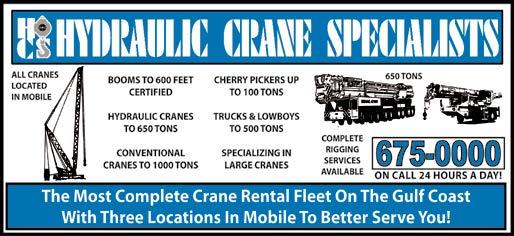
W Th F S Su M T W Th F S Su M T W Th F S Su M T W Th F S Su M T W Th F 04:28 PM / 0.77 05:44 PM / 0.65 07:39 PM / 0.50 10:33 AM / 0.37 10:42 PM / 0.36 09:25 AM / 0.50 09:11 AM / 0.66 09:27 AM / 0.80 10:01 AM / 0.88 10:45 AM / 0.92 11:36 AM / 0.92 12:32 PM / 0.89 01:28 PM / 0.85 02:18 PM / 0.79 02:59 PM / 0.71 03:25 PM / 0.61 02:45 PM / 0.49 10:47 AM / 0.44 09:30 AM / 0.50 08:58 AM / 0.58 08:49 AM / 0.67 08:58 AM / 0.74 09:20 AM / 0.80 09:55 AM / 0.84 10:40 AM / 0.88 11:31 AM / 0.92 12:24 PM / 0.94 01:16 PM / 0.93 02:05 PM / 0.87 02:52 PM / 0.76 03:42 PM / 0.60 11:21 AM / 0.40 05:17 PM / 0.40 03:09 AM / -0.14 03:41 AM / -0.08 04:00 AM / 0.01 03:56 AM / 0.12 04:25 PM / 0.17 02:51 AM / 0.22 05:51 PM / 0.04 06:53 PM / -0.06 07:52 PM / -0.13 08:56 PM / -0.16 10:07 PM / -0.16 11:25 PM / -0.15 12:37 AM / -0.14 01:33 AM / -0.12 02:11 AM / -0.08 02:30 AM / -0.04 02:32 AM / 0.02 02:14 AM / 0.09 01:25 AM / 0.14 06:25 PM / 0.14 06:25 PM / 0.06 06:47 PM / -0.01 07:20 PM / -0.06 08:05 PM / -0.09 09:04 PM / -0.12 10:12 PM / -0.14 11:19 PM / -0.16 12:16 AM / -0.18 01:00 AM / -0.18 01:34 AM / -0.14 01:56 AM / -0.06 02:00 AM / 0.04 02:24 PM / 0.27 1 2 3 4 5 6 7 8 9 10 11 12 13 14 15 16 17 18 19 20 21 22 23 24 25 26 27 28 29 30 31
W Th F S Su M T W Th F S Su M T W Th F S Su M T W Th F S Su M T W Th F 02:09 PM / 1.57 03:21 PM / 1.37 05:16 PM / 1.09 08:58 AM / 0.92 09:14 PM / 0.88 08:30 AM / 1.11 07:34 AM / 1.36 07:44 AM / 1.60 08:19 AM / 1.76 09:02 AM / 1.82 09:49 AM / 1.81 10:39 AM / 1.74 11:31 AM / 1.64 12:25 PM / 1.52 01:18 PM / 1.39 02:10 PM / 1.24 03:02 PM / 1.06 09:20 AM / 0.84 04:01 PM / 0.86 08:12 AM / 0.94 09:46 PM / 0.71 07:10 AM / 1.10 07:01 AM / 1.28 07:16 AM / 1.43 07:40 AM / 1.55 08:10 AM / 1.65 08:45 AM / 1.74 09:26 AM / 1.81 10:11 AM / 1.85 10:58 AM / 1.85 11:46 AM / 1.78 12:32 PM / 1.62 01:13 PM / 1.37 01:34 PM / 1.04 01:08 AM / -0.15 01:43 AM / 0.03 01:43 AM / 0.27 01:21 AM / 0.51 01:34 PM / 0.64 01:07 AM / 0.69 03:21 PM / 0.33 05:03 PM / 0.02 06:45 PM / -0.24 08:01 PM / -0.41 09:07 PM / -0.49 10:10 PM / -0.49 11:08 PM / -0.42 12:00 AM / -0.29 12:41 AM / -0.13 01:02 AM / 0.06 12:53 AM / 0.26 12:41 AM / 0.44 12:15 PM / 0.79 12:30 AM / 0.59 02:19 PM / 0.61 12:01 AM / 0.69 03:38 PM / 0.40 04:35 PM / 0.19 05:22 PM / 0.00 06:09 PM / -0.15 07:03 PM / -0.27 08:04 PM / -0.34 09:08 PM / -0.37 10:07 PM / -0.36 10:59 PM / -0.27 11:39 PM / -0.11 11:55 PM / 0.13 11:30 PM / 0.39 11:09 PM / 0.60 1 2 3 4 5 6 7 8 9 10 11 12 13 14 15 16 17 18 19 20 21 22 23 24 25 26 27 28 29 30 31
W Th F S Su M T W Th F S Su M T W Th F S Su M T W Th F S Su M T W Th F 03:29 PM / 1.52 04:42 PM / 1.30 07:16 PM / 1.04 09:43 AM / 0.76 09:32 PM / 0.81 09:21 AM / 0.97 09:02 AM / 1.23 08:57 AM / 1.50 09:27 AM / 1.69 10:12 AM / 1.79 11:04 AM / 1.81 11:59 AM / 1.77 12:50 PM / 1.69 01:36 PM / 1.57 02:16 PM / 1.41 02:51 PM / 1.22 03:21 PM / 1.00 09:25 AM / 0.82 08:34 AM / 0.95 08:24 AM / 1.12 08:14 AM / 1.29 08:19 AM / 1.45 08:45 AM / 1.59 09:22 AM / 1.69 10:07 AM / 1.77 10:57 AM / 1.83 11:48 AM / 1.87 12:38 PM / 1.85 01:24 PM / 1.76 02:09 PM / 1.57 02:50 PM / 1.29 03:24 PM / 0.95 02:16 AM / -0.28 02:56 AM / -0.14 03:19 AM / 0.09 03:17 AM / 0.38 03:02 PM / 0.57 02:41 AM / 0.64 04:52 PM / 0.27 06:19 PM / -0.01 07:40 PM / -0.23 08:53 PM / -0.37 09:58 PM / -0.42 10:58 PM / -0.41 11:54 PM / -0.34 12:45 AM / -0.23 01:29 AM / -0.09 01:55 AM / 0.07 01:44 AM / 0.24 01:29 AM / 0.40 01:06 AM / 0.54 05:44 PM / 0.53 05:49 PM / 0.31 06:21 PM / 0.12 07:04 PM / -0.04 07:54 PM / -0.16 08:46 PM / -0.26 09:38 PM / -0.34 10:27 PM / -0.39 11:13 PM / -0.41 11:55 PM / -0.36 12:31 AM / -0.23 12:56 AM / -0.03 01:04 AM / 0.23 1 2 3 4 5 6 7 8 9 10 11 12 13 14 15 16 17 18 19 20 21 22 23 24 25 26 27 28 29 30 31
W Th F S Su M T W Th F S Su M T W Th F S Su M T W Th F S Su M T W Th F 05:01 PM / 1.58 06:17 PM / 1.33 08:12 PM / 1.01 11:06 AM / 0.76 11:15 PM / 0.74 09:58 AM / 1.02 09:44 AM / 1.34 10:00 AM / 1.62 10:34 AM / 1.80 11:18 AM / 1.88 12:09 PM / 1.88 01:05 PM / 1.82 02:01 PM / 1.74 02:51 PM / 1.61 03:32 PM / 1.45 03:58 PM / 1.24 03:18 PM / 1.00 11:20 AM / 0.91 10:03 AM / 1.01 09:31 AM / 1.18 09:22 AM / 1.36 09:31 AM / 1.51 09:53 AM / 1.63 10:28 AM / 1.72 11:13 AM / 1.80 12:04 PM / 1.87 12:57 PM / 1.91 01:49 PM / 1.89 02:38 PM / 1.78 03:25 PM / 1.56 04:15 PM / 1.23 11:54 AM / 0.82 05:50 PM / 0.82 03:43 AM / -0.41 04:15 AM / -0.26 04:34 AM / 0.02 04:30 AM / 0.35 04:59 PM / 0.50 03:25 AM / 0.66 06:25 PM / 0.12 07:27 PM / -0.19 08:26 PM / -0.39 09:30 PM / -0.48 10:41 PM / -0.49 11:59 PM / -0.46 01:11 AM / -0.41 02:07 AM / -0.35 02:45 AM / -0.25 03:04 AM / -0.11 03:06 AM / 0.07 02:48 AM / 0.26 01:59 AM / 0.42 06:59 PM / 0.42 06:59 PM / 0.17 07:21 PM / -0.03 07:54 PM / -0.18 08:39 PM / -0.28 09:38 PM / -0.35 10:46 PM / -0.42 11:53 PM / -0.49 12:50 AM / -0.55 01:34 AM / -0.54 02:08 AM / -0.42 02:30 AM / -0.20 02:34 AM / 0.12 02:58 PM / 0.81 1 2 3 4 5 6 7 8 9 10 11 12 13 14 15 16 17 18 19 20 21 22 23 24 25 26 27 28 29 30 31 FLORIDA TIDE CHARTS 78 May 2024 // GreatDaysOutdoors.com // 877.314.1237
Pascagoula
Pascagoula
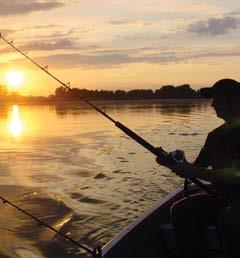

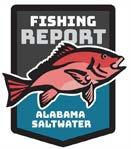
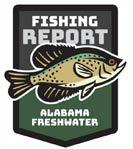

07:39 PM / 1.34 09:27 PM / 1.25 11:03 PM / 1.15 09:37 AM / 0.68 12:48 AM / 1.04 09:54 AM / 0.91 02:31 AM / 0.99 10:19 AM / 1.14 10:45 AM / 1.37 11:17 AM / 1.56 12:01 PM / 1.72 12:59 PM / 1.84 01:57 PM / 1.90 02:49 PM / 1.89 03:44 PM / 1.78 05:01 PM / 1.60 06:37 PM / 1.38 09:54 PM / 1.16 11:31 AM / 0.75 11:38 PM / 0.99 10:33 AM / 0.92 09:28 AM / 1.23 09:55 AM / 1.49 10:27 AM / 1.67 11:03 AM / 1.77 11:45 AM / 1.80 12:39 PM / 1.77 01:36 PM / 1.72 02:27 PM / 1.64 03:14 PM / 1.53 04:06 PM / 1.39 05:28 PM / 1.22 07:05 PM / 1.05 06:14 AM / 0.15 06:27 AM / 0.27 06:37 AM / 0.43 05:50 AM / 0.60 04:52 PM / 0.48 05:43 AM / 0.75 05:53 PM / 0.31 05:49 AM / 0.90 06:53 PM / 0.13 07:55 PM / -0.03 08:58 PM / -0.15 10:13 PM / -0.24 11:48 PM / -0.30 01:05 AM / -0.32 02:31 AM / -0.29 03:55 AM / -0.21 04:48 AM / -0.06 05:23 AM / 0.18 05:39 AM / 0.48 04:06 PM / 0.60 04:44 AM / 0.76 05:32 PM / 0.33 06:41 PM / 0.10 07:44 PM / -0.06 08:38 PM / -0.15 09:35 PM / -0.17 10:54 PM / -0.14 12:01 AM / -0.09 12:57 AM / -0.02 02:02 AM / 0.07 03:48 AM / 0.15 04:30 AM / 0.26 04:48 AM / 0.40 S Su M T W Th F S Su M T W Th F S Su M T W Th F S Su M T W Th F S Su 1 2 3 4 5 6 7 8 9 10 11 12 13 14 15 16 17 18 19 20 21 22 23 24 25 26 27 28 29 30 Share highlights from your great days outdoors with us! info@GreatDaysOutdoors.com 1 2 3 4 5 6 7 8 9 10 11 12 13 14 15 5:58 AM 5:57 AM 5:56 AM 5:55 AM 5:54 AM 5:53 AM 5:52 AM 5:52 AM 5:51 AM 5:50 AM 5:49 AM 5:49 AM 5:48 AM 5:47 AM 5:47 AM 7:27 PM 7:27 PM 7:28 PM 7:29 PM 7:30 PM 7:30 PM 7:31 PM 7:32 PM 7:32 PM 7:33 PM 7:34 PM 7:35 PM 7:35 PM 7:36 PM 7:37 PM 16 17 18 19 20 21 22 23 24 25 26 27 28 29 30 31 5:46 AM 5:45 AM 5:45 AM 5:44 AM 5:43 AM 5:43 AM 5:42 AM 5:42 AM 5:41 AM 5:41 AM 5:41 AM 5:40 AM 5:40 AM 5:40 AM 5:39 AM 5:39 AM 7:37 PM 7:38 PM 7:39 PM 7:40 PM 7:40 PM 7:41 PM 7:42 PM 7:42 PM 7:43 PM 7:43 PM 7:44 PM 7:45 PM 7:45 PM 7:46 PM 7:46 PM 7:47 PM
/ Sunset MISSISSIPPI TIDE CHARTS Download one of our three podcasts today and listen for free! Enjoy hearing the latest news on fishing?
Bay 04:23 PM / 2.03 05:44 PM / 1.74 08:04 PM / 1.38 11:38 AM / 1.02 11:57 PM / 1.11 10:03 AM / 1.30 09:44 AM / 1.72 10:03 AM / 2.11 10:38 AM / 2.39 11:20 AM / 2.55 12:05 PM / 2.57 12:51 PM / 2.49 01:37 PM / 2.33 02:22 PM / 2.12 03:04 PM / 1.88 03:38 PM / 1.61 03:40 PM / 1.32 12:09 PM / 1.13 10:08 AM / 1.21 09:24 AM / 1.42 09:19 AM / 1.67 09:33 AM / 1.90 09:58 AM / 2.10 10:30 AM / 2.25 11:07 AM / 2.37 11:49 AM / 2.44 12:33 PM / 2.45 01:20 PM / 2.39 02:07 PM / 2.23 02:52 PM / 1.96 03:31 PM / 1.58 01:17 PM / 1.14 02:42 AM / -0.27 03:31 AM / -0.07 04:10 AM / 0.24 04:26 AM / 0.64 04:35 PM / 0.82 03:25 AM / 1.03 06:07 PM / 0.36 07:14 PM / -0.05 08:14 PM / -0.36 09:13 PM / -0.55 10:12 PM / -0.60 11:11 PM / -0.55 12:09 AM / -0.44 01:03 AM / -0.27 01:51 AM / -0.08 02:28 AM / 0.13 02:50 AM / 0.36 02:47 AM / 0.61 01:47 AM / 0.82 06:13 PM / 0.69 06:33 PM / 0.39 07:04 PM / 0.12 07:39 PM / -0.10 08:18 PM / -0.27 09:00 PM / -0.40 09:47 PM / -0.49 10:39 PM / -0.55 11:31 PM / -0.55 12:23 AM / -0.48 01:11 AM / -0.32 01:49 AM / -0.06 02:09 AM / 0.30 W Th F S Su M T W Th F S Su M T W Th F S Su M T W Th F S Su M T W Th F 1 2 3 4 5 6 7 8 9 10 11 12 13 14 15 16 17 18 19 20 21 22 23 24 25 26 27 28 29 30 31
May 2024 Sunrise
Biloxi
03:42 PM / 1.59 05:00 PM / 1.31 09:15 PM / 1.01 10:19 AM / 0.88 11:46 PM / 0.89 08:35 AM / 1.10 08:39 AM / 1.44 09:10 AM / 1.73 09:47 AM / 1.93 10:27 AM / 2.03 11:11 AM / 2.03 12:02 PM / 1.96 01:01 PM / 1.85 01:55 PM / 1.71 02:39 PM / 1.54 03:18 PM / 1.33 03:55 PM / 1.09 10:39 AM / 0.79 09:09 PM / 0.85 09:20 AM / 0.88 07:16 AM / 1.09 07:45 AM / 1.32 08:19 AM / 1.52 08:57 AM / 1.70 09:36 AM / 1.83 10:16 AM / 1.93 11:00 AM / 1.99 11:50 AM / 2.00 12:50 PM / 1.94 01:45 PM / 1.81 02:30 PM / 1.57 03:02 PM / 1.24 10:02 AM / 0.93 01:56 AM / -0.16 03:09 AM / 0.02 03:59 AM / 0.28 03:24 AM / 0.58 04:40 PM / 0.53 03:03 AM / 0.85 05:46 PM / 0.16 06:43 PM / -0.14 07:40 PM / -0.34 08:35 PM / -0.44 09:33 PM / -0.44 10:40 PM / -0.37 11:45 PM / -0.27 12:36 AM / -0.15 01:20 AM / 0.00 02:03 AM / 0.18 02:48 AM / 0.37 01:24 AM / 0.54 12:58 PM / 0.75 01:31 AM / 0.70 04:41 PM / 0.57 05:09 PM / 0.31 05:36 PM / 0.09 06:10 PM / -0.10 06:52 PM / -0.24 07:42 PM / -0.34 08:37 PM / -0.39 09:39 PM / -0.41 10:52 PM / -0.40 11:49 PM / -0.33 12:26 AM / -0.17 12:43 AM / 0.06 12:48 AM / 0.34 W Th F S Su M T W Th F S Su M T W Th F S Su M T W Th F S Su M T W Th F 1 2 3 4 5 6 7 8 9 10 11 12 13 14 15 16 17 18 19 20 21 22 23 24 25 26 27 28 29 30 31 877.314.1237 // GreatDaysOutdoors.com // May 2024 79

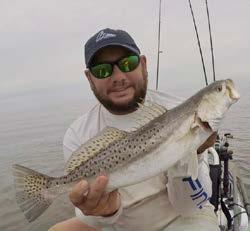
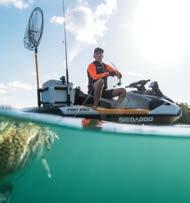
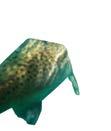




TROPHY ROOM Pensacola Motorsports When Submitting Trophy Room photos, be sure to include as much information as possible about the person and the trophy. Final Decision is made by the editorial Staff of Great Days Outdoors Magazine. Submitting a photo does not guarantee it will be published. GET FEATURED IN OUR ISSUES OF GREAT DAYS OUTDOORS WHEN YOU GIVE US YOUR BEST SHOT POST: To Facebook @GreatDaysOutdoors EMAIL: info@GreatDaysOutdoors.com [ OR ] IT'S EASY TO ENTER Photo of the Month! Simply share your great day outdoors with us! Daniel Williams with a nice gobbler. Tanner Martiniere with a nice speck caught out of his kayak. Sea-Doo.com ©2018 Bombardier Recreational Products Inc. (BRP). All rights reserved. ™ and the BRP logo are trademarks of BRP or its affiliates. Some models depicted may include optional equipment. Carefully read the operator’s guide and safety instructions. Observe applicable laws and regulations. Always wear appropriate protective clothing, including a personal flotation device and wetsuit bottoms. Riding and alcohol/drugs don’t mix. See your authorized BRP dealer fo details. You didn’t see it coming. Neither did the fish. Discover yours at our dealership Introducing the all-new FISH PRO™ The world’s first personal watercraft designed for fishing will bring you closer to the action for an experience like never before. 618 N New Warrington Rd. Pensacola, FL 32506 (850)456-6655 Pensacola Motorsports 80 May 2024 // GreatDaysOutdoors.com // 877.314.1237




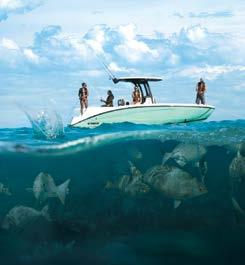

Shai Taylor Markris with her first turkey Jake Freeman with a 35 pound blue cat out of the Tombigbee River Jody Waldorff shows off a nice doormat flounder JETBLASTER ® | YAMAHAWAVERUNNERS.COM This document contains many of Yamaha’s valuable trademarks. It may also contain trademarks belonging to other companies. Any references to other companies or their products are for identification purposes only, and are not intended to be an endorsement. Follow instructional materials and obey all laws. Ride responsibly, wearing protective apparel and USCG-approved personal flotation device. Always ride within your capabilities, allowing time and distance for maneuvering, and respect others around you. Never drink and ride. WaveRunner® is a Yamaha brand personal watercraft and not a generic term. This document contains many of Yamaha’s valuable trademarks. It may also contain trademarks belonging to other companies. Any references to other companies or their products are for identification purposes only, and are not intended to be an endorsement. Follow instructional materials and obey all laws. Ride responsibly, wearing protective apparel and USCG-approved personal flotation device. Always ride within your capabilities, allowing time and distance for maneuvering, and respect others around you. Never drink and ride. WaveRunner® is a Yamaha brand personal watercraft and not a generic term. THE DEEPEST BONDS START AT THE SURFACE FSH SERIES | YAMAHABOATS.COM FSH SERIES | YAMAHABOATS.COM WAKE UP WILD JETBLASTER ® | YAMAHAWAVERUNNERS.COM This document contains many of Yamaha’s valuable trademarks. It may also contain trademarks belonging to other companies. Any references to other companies or their products are for identification purposes only, and are not intended to be an endorsement. Follow instructional materials and obey all laws. Ride responsibly, wearing protective apparel and USCG-approved personal flotation device. Always ride within your capabilities, allowing time and distance for maneuvering, and respect others around you. Never drink and ride. WaveRunner® is a Yamaha brand personal watercraft and not a generic term. Pensacola Motorsports 618 N New Warrington Rd. • Pensacola, FL 32506 (850) 456-6655 www.pensacolamotorsports.com 1ST Turkey 877.314.1237 // GreatDaysOutdoors.com // May 2024 81
KID'S CORNER TROPHY ROOM

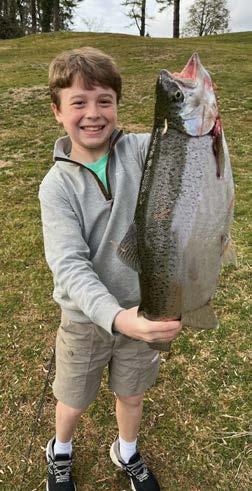
show
Hunter Robertson, 14 and on the Baldwin County High School fishing team.
10 year old Will Johnson from Mobile, with a great catch of a rainbow trout 5+ lbs, on 5 lb test line. At Cashiers Lake, NC
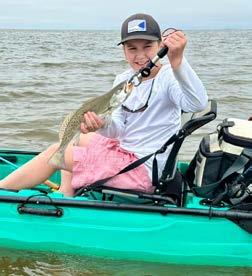

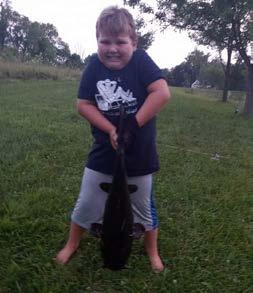
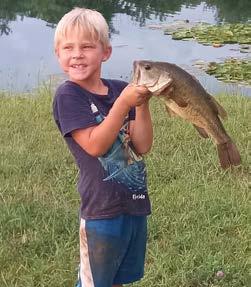
Give us your best shot! Send your submission to info@greatdaysoutdoors.com. Submitting a photo does not guarantee that it will be published. We cannot give any guarantees on when a photo will be published. Please include: child's full name, age, mailing address, and any details. We need to know when, where, size (weight, points, etc.), shot or caught with what and any other meaningful information, like first time, etc.. CONTRIBUTIONS WITHOUT THIS INFO WON’T BE PUBLISHED.
Remington Ammon-Sipe hoisting a big-ole largejaw bass. Great job, Remington!
Raylan Ammon-Sipe muscling in the big ones this month!
Colt Martiniere, age 12, showing off a nice speckled trout. Nice fish and cool kayak, Colt!
Fisher Lowe, age 4, says beauty is in the eye of the “fishholder”.

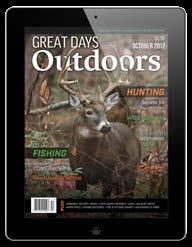
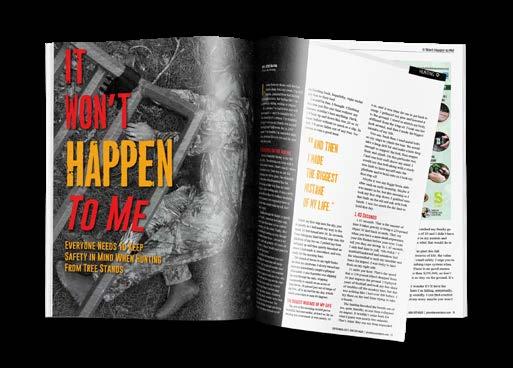






PRINT, DIGITAL OR BOTH THREE WAYS TO SUBSCRIBE... 1) CALL 877.314.1237 2) ORDER ONLINE AT GREATDAYSOUTDOORS.COM 3) MAIL IN THE COUPON (with Credit Card Number, Check or Money Order) GREAT DAYS OUTDOORS MAGAZINE PO BOX 460248 ESCONDIDO CA 92046-9801 SIGN ME UP FOR A SUBSCRIPTION FOR: 1 YEAR $36.00 2 YEARS $60.00 NAME ADDRESS CITY STATE ZIP PHONE CREDIT CARD# EXP. / CID EMAIL includes tax where applicable Must send email address to receive digital copies SAVE 67% Off Newstand Price When you Subscribe for 2 years Hunting & Fishing in Alabama & the Florida Panhandle Yes, send me your e-newsletters 84 May 2024 // GreatDaysOutdoors.com // 877.314.1237
May Fishing Tip
BY THE EDITORS
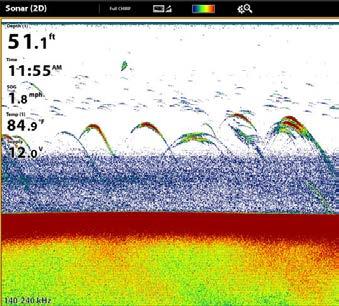
As the water starts to heat up this summer, anglers have a new variable to factor into their fish-prediction calculations: the thermocline. If you’ve ever gone for a dip in a lake or pond and felt your toes brush against water that felt substantially cooler than what your upper body was in, then you’ve experienced thermocline first hand.
This is a result of stratification. Still water will settle, with warm, oxygenated water resting on top of colder, low-oxygen water. The depth at which these two parameters meet is referred to as the thermocline. If you’re fishing deep, still water, chances are that it will stratify in the summertime, and this will have an effect on the fish you are chasing. On a recent episode of the Alabama Freshwater Fishing Report, we caught up with tournament kayak angler Brandon Watson to discuss this effect.
The first thing to keep in mind, according to Brandon, is that not all lakes will stratify. “If you have current, whether it’s wind-driven current, or they’re drawing water at a spillway, or there’s a feeder creek draining into the lake nearby, then the water won’t stratify,” he says.
“If it does stratify, you can actually see that on your electronics. The warm, oxygenated water is less dense, and sonar penetrates it easily. The water below the thermocline is much denser, and it generates a return. Sonar can’t penetrate it, and it can be difficult or impossible to see fish
and other structure below the thermocline.”
According to Brandon, water stratification impacts fish in big ways. Fish can’t survive long term in the low oxygen water below the thermocline. On the other hand, heat-stressed fish can find the water refreshing in small doses.
“I believe that some fish can tolerate conditions below the thermocline for a limited time,” he says. “They use it like air conditioning, almost. I believe that because I’ve been fishing and watched fish come up out of and disappear into the thermocline when the surface temperatures were hot.”
He continues, “This can make fish predictable. If there’s a thermocline, a lot of times you’ll see most of your fish holding right at that depth. Bait fish, I believe, can’t tolerate below the thermocline and will hold right above it. The bass will hang out at that depth as well, or dip down below the level and just slow down. They’re not cruising or chasing, they’re just popping down and conserving the oxygen they have and cooling off.”
So how can you make the most of a thermocline on your lake or pond? According to Brandon, look for structure or topography at that depth that fish will relate to. By targeting these features at the depth of the thermocline, you can have a productive day of fishing, even on a hot, calm “dead” afternoon.
Advertiser Index A-Team Fishing Adventures . . . . . . . . 3 AL Power . . . . . . . . . . . . . . . . . . . . . 88 ADCNR Marine . . . . . . . . . . . . . . . . . 55 Camper City . . . . . . . . . . . . . . . . . . 23 CCA Alabama . . . . . . . . . . . . . . . . . . 75 Clutch Products . . . . . . . . . . . . . . . 58 Coast Safe & Lock . . . . . . . . . . . . . . 71 Cold Blooded Fishing . . . . . . . . . . . 15 Deep South Crane . . . . . . . . . . . . . . 38 Dixie Building Supply . . . . . . . . . . . . 3 Fiber Plastics . . . . . . . . . . . . . . . . . 10 Fishbites . . . . . . . . . . . . . . . . . . . . . 87 Hilton’s Offshore Charts . . . . . . . . . . 15 Hydraulic Crane . . . . . . . . . . . . . . . 78 Killer Dock . . . . . . . . . . . . . . . . . . . 67 Midway Lumber . . . . . . . . . . . . . . . 65 National Land Realty . . . . . . . . . . . . . 5 Paradise Marine . . . . . . . . . . . . . . . . 2 Pensacola Motor Sports . . . . . . . 80-81 Pure Fishing . . . . . . . . . . . . . . . . . . 19 Pure Flats . . . . . . . . . . . . . . . . . . . . 65 Return Em Right . . . . . . . . . . . . . . . 27 Southeastern Pond Management . . . . 7 Test Calibration Co . . . . . . . . . . . . . . 76 Texas Hunter Products . . . . . . . . . . . 43 War Eagle Boats . . . . . . . . . . . . . . . . . . . 47 FISHING TIP
877.314.1237 // GreatDaysOutdoors.com // May 2024 85
An Introduction to Fly Fishing
 BY JIM MIZE
BY JIM MIZE
I was unloading my fly-fishing gear one spring evening when a neighbor’s youngest son followed my driveway up and began staring at my gear. I could tell there were questions behind those eyes, so I broke the ice and said, “Hi.”
“What kind of rod is that?” he asked.
“A fly rod. It allows you to throw delicate little imitations of insects to fish that eat bugs.”
“How does it work?”
At this point, I settled in for an extended lesson on the art of fly fishing, sharing my years of experience and insight.
“Well, the fellows who invented fly fishing wanted casting to be an exciting part of the sport since so much of your time is spent flailing your rod and line in the air. Their goal was to give you an equal opportunity to catch something on either your forward or your backward cast.”
“How does that happen?” he asked, clearly engaged in my fishing lesson.
“Well, on the forward cast, you have the opportunity to catch a fish. On the backward cast, you can catch all sorts of things. I’ve caught trees, other people, and once, a bat.”
“You can also have some excitement on the pickup for your cast. Sometimes, the fish bite just as you lift your line. If it’s a big one, the lift of your rod sets the hook and sometimes breaks your line. If it’s a small one, like a little bluegill, the fish can go sailing right past your head. So I’ll share a tip with you; always keep your rod at an angle away from you so the fish doesn’t hit you in the head.”
“That sounds like good advice. What other gear will I need?”
“Most people get a pair of waders, but they don’t understand what they are for. They think they are there to keep you dry.”
“They aren’t?” asked the kid.
“No, waders only give you the illusion of keeping dry. Eventually, you will poke a hole in them and they will fill with water. Or you’ll slip and fall, letting the waders fill. Or on a hot summer day, you’ll sweat so much you might as well be wading without them. But at least you have a chance.”
“Any other gear I need?”
“You will need some flies and you can either buy them or make them.”
“How do you make flies?” asked the kid.
“You start with a vise to hold the hook, and then you need thread, feathers or hair, sometimes floss or tinsel to dress the body. A lot of this stuff you can buy but some people like to gather their own. You can use duck feathers, deer
hair, squirrel tails, and all sorts of other materials. Even roadkill.” “Roadkill?”
“Sure, just make sure it’s dead though. I heard once about two fellows who found a bobcat on the side of the road and threw it into their backseat. Turns out it was just stunned. Then it woke up. They found out that driving down a highway with an irritated bobcat in the backseat is less fun than it sounds.”
“So, if I get a rod, waders, and flies I can go fly fishing?”
“Pretty much. You’ll need some leaders, tippet, nippers, and probably a net. Plus, something to carry it all in. After that, it’s just a matter of learning how to use it all.”
“Where do I learn that?” asked the kid.
“You can learn the casting part on YouTube or at a fly shop. Maybe even at a fly show or Trout Unlimited gathering. But the tricky part is learning how to fish.”
“What do you mean?”
“Well, you have to present your fly to the fish without spooking it. Then you have to make the bug look realistic so it has to float in the water the way the other bugs do. Or if it’s a minnow imitation, you will want it to jerk along like it’s injured or something. Sometimes you just have to try a lot of different things to see what works.”
“And then there is the part about playing the fish.”
“Playing?”
“Sure. With this light rod you can’t just crank it in. The leader will break. Or the rod.”
“I was teaching a fellow to cast one day when he accidentally hooked a big trout. Neither of us were expecting to catch a fish, so I hadn’t taught him how to play one yet.”
“His fishing experience had been mostly catching catfish on riverbanks with an Ugly Stick. So, when the trout hit, he grabbed the line and held it tight with one hand, then reached up the rod to brace it and just started backing up the bank.”
“He quickly learned that fly rods are designed to bend and if you restrict them by holding the middle, you put all the pressure on one or two spots. That fly rod snapped on either side of his hand and that four-piece fly rod is now a six-piece fly rod.”
“So he broke his rod?” asked the kid.
“No, he broke mine.”
The kid pondered briefly and then asked, “Will you teach me how to fly fish?”
I pondered as long as he did and then answered, “Only if you bring your own rod.”
A fellow has to set some limits.
JIM MIZE has learned to never loan his best rods You can purchase Jim’s new book, The Jon Boat Years, at https:// uscpress.com/The-Jon-Boat-Years or buy autographed copies at www acreektricklesthroughit com .
A GREAT DAY OUTDOORS
86 May 2024 // GreatDaysOutdoors.com // 877.314.1237
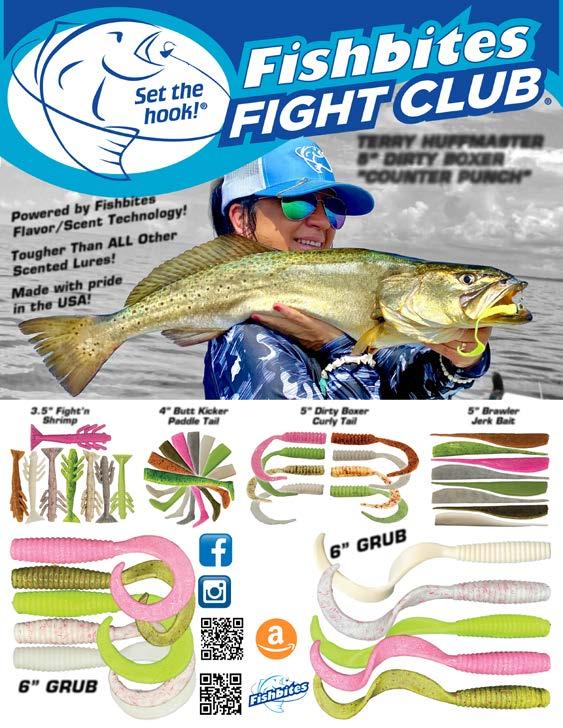

fishbites.com 877.314.1237 // GreatDaysOutdoors.com // May 2024 87
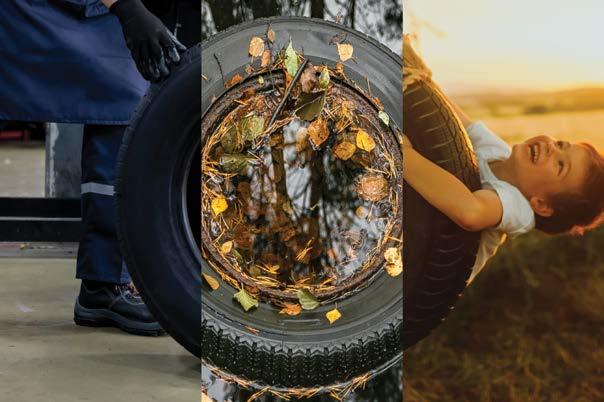
Renewing more than rivers for 25 years.
The Renew Our Rivers program, originated by Alabama Power, has grown into one of the largest river cleanups in the nation. Over 117,000 volunteers have come together to remove 16 million pounds of trash from our Southeastern waterways. We have shown up again and again to preserve the beauty and to create a community that is powering a better Alabama. For 25 years, we’ve been renewing more than rivers.
© 2024 Alabama Power Company
view volunteer opportunities.
Scan to

































 BY HANK SHAW
https://honest-food.net
Image courtesy of Holly A. Heyser
BY HANK SHAW
https://honest-food.net
Image courtesy of Holly A. Heyser







































 Catching Big Bluegill Using Sidescan Sonar
Catching Big Bluegill Using Sidescan Sonar





































 BY CHRIS BLANKENSHIP Commissioner of the Alabama Department of Conservation & Natural Resources
BY CHRIS BLANKENSHIP Commissioner of the Alabama Department of Conservation & Natural Resources






 BY CHARLES
BY CHARLES






 BY DAVID THORNTON
BY DAVID THORNTON





 Photos by Ed Mashburn
Photos by Ed Mashburn











































 BY JIM MIZE
BY JIM MIZE


